MENU
The Electronic Scholarly Publishing Project: Providing access to classic scientific papers and other scholarly materials, since 1993. More About: ESP | OUR CONTENT | THIS WEBSITE | WHAT'S NEW | WHAT'S HOT
Comparative Timelines
The ESP Timeline (one of the site's most popular features) has been completely updated to allow the user to select (using the timeline controls above each column) different topics for the left and right sides of the display.
Select:
New Left Column
New Left Column
Dates
Decade
New Right Column
New Right Column
(no entry for this year)
1470
(no entry for this year)
(no entry for this year)
1471
After having secured much of what today is central and northern Peru, the Inca have expanded their empire into Ecuador. With a new king, Tupac Inca, they begin to expand southward into Chile, Bolivia and Argentina.
(no entry for this year)
1472
(no entry for this year)
(no entry for this year)
1473
(no entry for this year)
(no entry for this year)
1474
(no entry for this year)
(no entry for this year)
1475
(no entry for this year)
(no entry for this year)
1476
(no entry for this year)
(no entry for this year)
1477
(no entry for this year)
(no entry for this year)
1478
A conspiracy, that includes the Archbishop of Pisa and has the support of Pope Sixtus IV, leads to an attack on the Medici while they are in church. The Archbishop and several others are hanged. Pope Sixtus puts Florence under the interdict and excommunicates the Medici leader of Florence, Lorenzo de Medici. The pope forms a military alliance with the King of Naples, and Lorenzo's diplomacy prevents an attack.
(no entry for this year)
1479
(no entry for this year)
(no entry for this year)
1480
Ferdinand and Isabella of Spain employ the Spanish Inquisition to investigate whether converted Jews are secretly clinging to Judaism.
(no entry for this year)
1481
(no entry for this year)
(no entry for this year)
1482
Portuguese have founded new trading settlements on Africa's "Gold Coast." They are trading ironware, firearms, textiles and food for gold, ivory, food and slaves.
(no entry for this year)
1483
Edward IV of England has died. His son succeeds him as Edward V, and he is murdered. The Duke of Gloucester, the youngest brother of Edward IV, usurps the throne and is crowned Richard III.
(no entry for this year)
1484
(no entry for this year)
(no entry for this year)
1485
Henry Tudor, a relative of the Lancaster family, defeats Richard III at the Battle of Bosworth. The Tudor family takes power and is crowned Henry VII.
Henry VII marries Elizabeth of York, uniting the Lancaster and York families. The War of Roses is over.
(no entry for this year)
1486
(no entry for this year)
(no entry for this year)
1487
(no entry for this year)
(no entry for this year)
1488
(no entry for this year)
(no entry for this year)
1489
(no entry for this year)
(no entry for this year)
1490
(no entry for this year)
(no entry for this year)
1491
King Charles VIII of France invades Brittany and forces 14-year-old Ann of Brittany to marry him, adding Brittany to French territory.
(no entry for this year)
1492
Spain's monarchs, Ferdinand and Isabella, do their part in a war against Islam — they annex Granada. Also they give Jews three months to convert to Christianity if they are to avoid banishment from the country. And the voyage that the monarchy is paying for, led by Christopher Columbus, sets sail for China by going westward.
(no entry for this year)
1493
(no entry for this year)
(no entry for this year)
1494
Piero de Medici has ruled since the death of his father, Lorenzo, in 1492. He makes peace with the French, who have invaded Tuscany (in which Florence is located). A political rising drives him into exile. Florence is in anarchy. A Dominican priest, Savonarola, is anti-Renaissance. He is opposed to popular music, art and other worldliness.
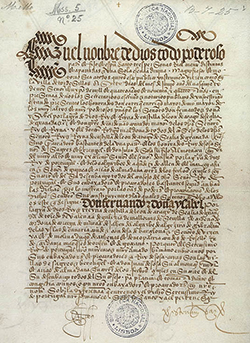 The Treaty of Tordesillas, signed in Tordesillas, Spain, on 7 June 1494, and ratified in Setúbal, Portugal, divided the newly discovered lands outside Europe between the Kingdom of Portugal and the Crown of Castile, along a meridian 370 leagues west of the Cape Verde islands, off the west coast of Africa. That line of demarcation was about halfway between Cape Verde (already Portuguese) and the islands visited by Christopher Columbus on his first voyage (claimed for Castile and León), named in the treaty as Cipangu and Antillia (Cuba and Hispaniola). The lands to the east would belong to Portugal and the lands to the west to Castile, modifying an earlier bull by Pope Alexander VI. The treaty was signed by Spain on 2 July 1494, and by Portugal on 5 September 1494. The other side of the world was divided a few decades later by the Treaty of Zaragoza, signed on 22 April 1529, which specified the antimeridian to the line of demarcation specified in the Treaty of Tordesillas. Portugal and Spain largely respected the treaties, while the indigenous peoples of the Americas did not acknowledge them.
The Treaty of Tordesillas, signed in Tordesillas, Spain, on 7 June 1494, and ratified in Setúbal, Portugal, divided the newly discovered lands outside Europe between the Kingdom of Portugal and the Crown of Castile, along a meridian 370 leagues west of the Cape Verde islands, off the west coast of Africa. That line of demarcation was about halfway between Cape Verde (already Portuguese) and the islands visited by Christopher Columbus on his first voyage (claimed for Castile and León), named in the treaty as Cipangu and Antillia (Cuba and Hispaniola). The lands to the east would belong to Portugal and the lands to the west to Castile, modifying an earlier bull by Pope Alexander VI. The treaty was signed by Spain on 2 July 1494, and by Portugal on 5 September 1494. The other side of the world was divided a few decades later by the Treaty of Zaragoza, signed on 22 April 1529, which specified the antimeridian to the line of demarcation specified in the Treaty of Tordesillas. Portugal and Spain largely respected the treaties, while the indigenous peoples of the Americas did not acknowledge them.
(no entry for this year)
1495
(no entry for this year)
(no entry for this year)
1496
(no entry for this year)
(no entry for this year)
1497
Boys working under Savonarola collect from homes things associated with moral laxity: mirrors, cosmetics, pictures, books, fine dresses, the works of immoral poets. Savonarola has these burned. Renaissance art work is lost. Pope Alexander VI excommunicates Savonarola.
(no entry for this year)
1498
Savonarola is hanged. An enraged crowd burns Savonarola at the same spot where he ordered his bonfire.
(no entry for this year)
1499
(no entry for this year)
(no entry for this year)
1500
(no entry for this year)
(no entry for this year)
1501
African Slaves in the New World Spanish settlers bring slaves from Africa to Santo Domingo (now the capital of the Dominican Republic).
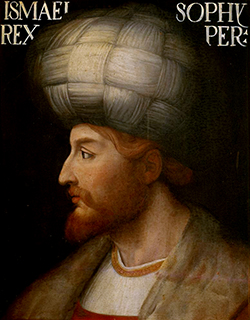 Ismail I, the founder and first shah of Safavid Iran, ruled from 1501 until his death in 1524. His reign is often considered the beginning of modern Iranian history, as well as one of the gunpowder empires. The rule of Ismail I is one of the most vital in the history of Iran. Before his accession in 1501, Iran, since its Islamic conquest eight-and-a-half centuries earlier, had not existed as a unified country under native Iranian rule. The dynasty founded by Ismail I would rule for over two centuries, being one of the greatest Iranian empires and at its height being amongst the most powerful empires of its time, ruling all of present-day Iran, the Republic of Azerbaijan, Armenia, most of Georgia, the North Caucasus, and Iraq, as well as parts of modern-day Turkey, Syria, Pakistan, Afghanistan, Uzbekistan, and Turkmenistan.
Ismail I, the founder and first shah of Safavid Iran, ruled from 1501 until his death in 1524. His reign is often considered the beginning of modern Iranian history, as well as one of the gunpowder empires. The rule of Ismail I is one of the most vital in the history of Iran. Before his accession in 1501, Iran, since its Islamic conquest eight-and-a-half centuries earlier, had not existed as a unified country under native Iranian rule. The dynasty founded by Ismail I would rule for over two centuries, being one of the greatest Iranian empires and at its height being amongst the most powerful empires of its time, ruling all of present-day Iran, the Republic of Azerbaijan, Armenia, most of Georgia, the North Caucasus, and Iraq, as well as parts of modern-day Turkey, Syria, Pakistan, Afghanistan, Uzbekistan, and Turkmenistan.
(no entry for this year)
1502
(no entry for this year)
(no entry for this year)
1503
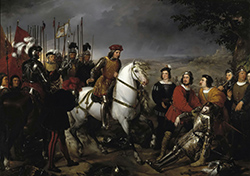 At the Battle of Cerignola Spanish forces defeat the French, considered the first battle in history won by gunpowder small arms.
At the Battle of Cerignola Spanish forces defeat the French, considered the first battle in history won by gunpowder small arms.
(no entry for this year)
1504
(no entry for this year)
(no entry for this year)
1505
(no entry for this year)
(no entry for this year)
1506
(no entry for this year)
(no entry for this year)
1507
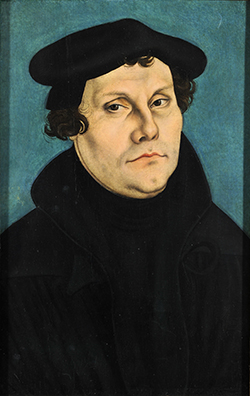 Martin Luther ordained to the priesthood. Luther was the seminal figure of the Protestant Reformation. He is widely regarded as one of the most influential figures in Western and Christian history. He came to reject several teachings and practices of the Roman Catholic Church; in particular, he disputed the view on indulgences. Luther attempted to resolve these differences amicably, first proposing an academic discussion of the practice and efficacy of indulgences in Ninety-five Theses, which he authored in 1517. In 1520, Pope Leo X demanded that Luther renounce all of his writings, and when Luther refused to do so, excommunicated him in January 1521. Later that year, Holy Roman Emperor Charles V condemned Luther as an outlaw at the Diet of Worms. When Luther died in 1546, Pope Leo X's excommunication was still in effect. Luther taught that salvation and, consequently, eternal life are not earned by good deeds; rather, they are received only as the free gift of God's grace through the believer's faith in Jesus Christ, who is the sole redeemer from sin. Luther's theology challenged the authority and office of the pope by teaching that the Bible is the only source of divinely revealed knowledge, and opposed sacerdotalism by considering all baptized Christians to be a holy priesthood. Attempts by the Catholic Church to suppress the new protestant movement led to more than 200 years of wars — the European wars of religion.
Martin Luther ordained to the priesthood. Luther was the seminal figure of the Protestant Reformation. He is widely regarded as one of the most influential figures in Western and Christian history. He came to reject several teachings and practices of the Roman Catholic Church; in particular, he disputed the view on indulgences. Luther attempted to resolve these differences amicably, first proposing an academic discussion of the practice and efficacy of indulgences in Ninety-five Theses, which he authored in 1517. In 1520, Pope Leo X demanded that Luther renounce all of his writings, and when Luther refused to do so, excommunicated him in January 1521. Later that year, Holy Roman Emperor Charles V condemned Luther as an outlaw at the Diet of Worms. When Luther died in 1546, Pope Leo X's excommunication was still in effect. Luther taught that salvation and, consequently, eternal life are not earned by good deeds; rather, they are received only as the free gift of God's grace through the believer's faith in Jesus Christ, who is the sole redeemer from sin. Luther's theology challenged the authority and office of the pope by teaching that the Bible is the only source of divinely revealed knowledge, and opposed sacerdotalism by considering all baptized Christians to be a holy priesthood. Attempts by the Catholic Church to suppress the new protestant movement led to more than 200 years of wars — the European wars of religion.
(no entry for this year)
1508
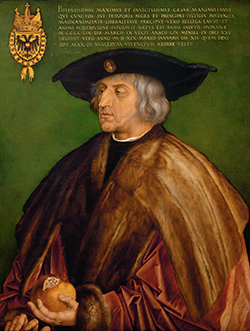 Maximilian I becomes Holy Roman Emperor, a role he held until his death in 1519. He was never crowned by the Pope, as the journey to Rome was blocked by the Venetians. He proclaimed himself elected emperor in 1508 (Pope Julius II later recognized this) at Trent, thus breaking the long tradition of requiring a papal coronation for the adoption of the Imperial title. Maximilian was the only surviving son of Frederick III, Holy Roman Emperor, and Eleanor of Portugal. Since his coronation as King of the Romans in 1486, he ran a double government, or Doppelregierung (with a separate court), with his father until Frederick's death in 1493. Maximilian expanded the influence of the House of Habsburg through war and his marriage in 1477 to Mary of Burgundy, the ruler of the Burgundian State, heiress of Charles the Bold, though he also lost his family's original lands in today's Switzerland to the Swiss Confederacy. Through the marriage of his son Philip the Handsome to eventual queen Joanna of Castile in 1496, Maximilian helped to establish the Habsburg dynasty in Spain, which allowed his grandson Charles to hold the thrones of both Castile and Aragon.
Maximilian I becomes Holy Roman Emperor, a role he held until his death in 1519. He was never crowned by the Pope, as the journey to Rome was blocked by the Venetians. He proclaimed himself elected emperor in 1508 (Pope Julius II later recognized this) at Trent, thus breaking the long tradition of requiring a papal coronation for the adoption of the Imperial title. Maximilian was the only surviving son of Frederick III, Holy Roman Emperor, and Eleanor of Portugal. Since his coronation as King of the Romans in 1486, he ran a double government, or Doppelregierung (with a separate court), with his father until Frederick's death in 1493. Maximilian expanded the influence of the House of Habsburg through war and his marriage in 1477 to Mary of Burgundy, the ruler of the Burgundian State, heiress of Charles the Bold, though he also lost his family's original lands in today's Switzerland to the Swiss Confederacy. Through the marriage of his son Philip the Handsome to eventual queen Joanna of Castile in 1496, Maximilian helped to establish the Habsburg dynasty in Spain, which allowed his grandson Charles to hold the thrones of both Castile and Aragon.
(no entry for this year)
1509
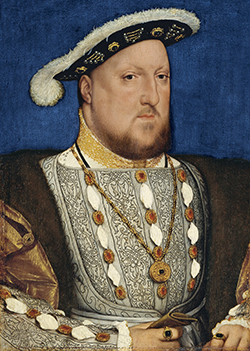 Henry VIII becomes King of England. Henry is known for his six marriages and his efforts to have his first marriage (to Catherine of Aragon) annulled. His disagreement with Pope Clement VII about such an annulment led Henry to initiate the English Reformation, separating the Church of England from papal authority. He appointed himself Supreme Head of the Church of England and dissolved convents and monasteries, for which he was excommunicated by the pope. Henry brought radical changes to the Constitution of England, expanding royal power and ushering in the theory of the divine right of kings in opposition to papal supremacy. He frequently used charges of treason and heresy to quell dissent, and those accused were often executed without a formal trial using bills of attainder. He achieved many of his political aims through his chief ministers, some of whom were banished or executed when they fell out of his favor. Thomas Wolsey, Thomas More, Thomas Cromwell, and Thomas Cranmer all figured prominently in his administration.
Henry VIII becomes King of England. Henry is known for his six marriages and his efforts to have his first marriage (to Catherine of Aragon) annulled. His disagreement with Pope Clement VII about such an annulment led Henry to initiate the English Reformation, separating the Church of England from papal authority. He appointed himself Supreme Head of the Church of England and dissolved convents and monasteries, for which he was excommunicated by the pope. Henry brought radical changes to the Constitution of England, expanding royal power and ushering in the theory of the divine right of kings in opposition to papal supremacy. He frequently used charges of treason and heresy to quell dissent, and those accused were often executed without a formal trial using bills of attainder. He achieved many of his political aims through his chief ministers, some of whom were banished or executed when they fell out of his favor. Thomas Wolsey, Thomas More, Thomas Cromwell, and Thomas Cranmer all figured prominently in his administration.
(no entry for this year)
1510
(no entry for this year)
(no entry for this year)
1511
(no entry for this year)
(no entry for this year)
1512
(no entry for this year)
(no entry for this year)
1513
(no entry for this year)
(no entry for this year)
1514
Raphael's friend, courtier Giovanbattista Branconio dell'Aquila, becomes the personal keeper of Hanno, the white elephant brought to Rome in 1514, as a gift by King Manuel I of Portugal to Pope Leo X (born Giovanni de' Medici) at his coronation.
(no entry for this year)
1515
(no entry for this year)
(no entry for this year)
1516
(no entry for this year)
(no entry for this year)
1517
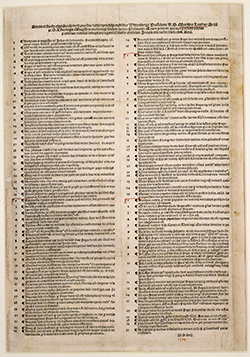 Martin Luther publishes his Ninety-five Theses or Disputation on the Power and Efficacy of Indulgences, a list of propositions for an academic disputation. This work is retrospectively considered to have launched the Protestant Reformation and the birth of Protestantism, despite various proto-Protestant groups having existed previously. It detailed Luther's opposition to what he saw as the Roman Catholic Church's abuse and corruption by Catholic clergy, who were selling plenary indulgences, which were certificates supposed to reduce the temporal punishment in purgatory for sins committed by the purchasers or their loved ones.
Martin Luther publishes his Ninety-five Theses or Disputation on the Power and Efficacy of Indulgences, a list of propositions for an academic disputation. This work is retrospectively considered to have launched the Protestant Reformation and the birth of Protestantism, despite various proto-Protestant groups having existed previously. It detailed Luther's opposition to what he saw as the Roman Catholic Church's abuse and corruption by Catholic clergy, who were selling plenary indulgences, which were certificates supposed to reduce the temporal punishment in purgatory for sins committed by the purchasers or their loved ones.
Ottoman Turks defeat the Mamluks of Egypt and take control of Egypt and the Arabian Peninsula.
(no entry for this year)
1518
(no entry for this year)
(no entry for this year)
1519
Horses are brought to the New World by Hernán Cortéz.
(no entry for this year)
1520
Suleiman I, also known as Suleiman the Magnificent, became Sultan in 1520 and led the Ottoman Empire to its greatest height. He expanded the empire's territory, reformed its legal system, and oversaw a cultural and artistic flourishing known as the Ottoman Renaissance.
Beginning of anabaptist movement in Germany under Thomas Münzer.
Pope Leo X excommunicates Martin Luther.
(no entry for this year)
1521
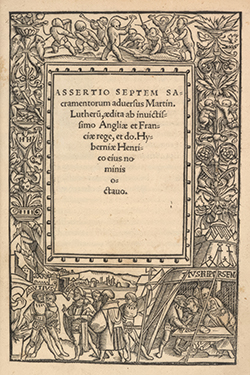 Pope Leo X confers title Defender of the Faith on King Henry VIII for his Assertio septem sacramentorum against Luther.
Pope Leo X confers title Defender of the Faith on King Henry VIII for his Assertio septem sacramentorum against Luther.
(no entry for this year)
1522
Slave Revolt: the Caribbean Slaves rebel on the Caribbean island of Hispaniola, which now comprises Haiti and the Dominican Republic.
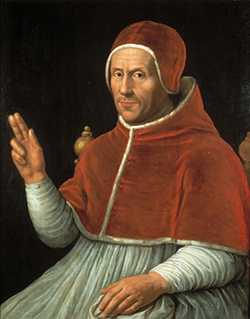 Adrian of Utrecht, Regent of Spain, elected Pope Adrian VI, the last non-Italian Pope for some time.
Adrian of Utrecht, Regent of Spain, elected Pope Adrian VI, the last non-Italian Pope for some time.
(no entry for this year)
1523
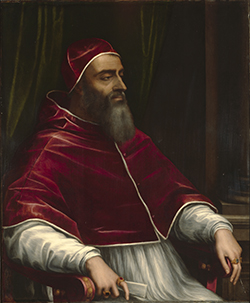 Pope Adrian VI dies, Giulio de' Medici becomes Pope Clement VII. Deemed the most unfortunate of the popes, Clement VII's reign was marked by a rapid succession of political, military, and religious struggles — many long in the making — which had far-reaching consequences for Christianity and world politics. Elected in 1524 at the end of the Italian Renaissance, Clement came to the papacy with a high reputation as a statesman. He had served with distinction as chief advisor to Pope Leo X (1513–1521, his cousin), Pope Adrian VI (1522–1523), and commendably as gran maestro of Florence (1519–1523). Assuming leadership at a time of crisis, with the Protestant Reformation spreading, the Church nearing bankruptcy, and large foreign armies invading Italy, Clement initially tried to unite Christendom by making peace among the many Christian leaders then at odds. He later attempted to liberate Italy from foreign occupation, believing that it threatened the Church's freedom. The complex political situation of the 1520s thwarted Clement's efforts.
Pope Adrian VI dies, Giulio de' Medici becomes Pope Clement VII. Deemed the most unfortunate of the popes, Clement VII's reign was marked by a rapid succession of political, military, and religious struggles — many long in the making — which had far-reaching consequences for Christianity and world politics. Elected in 1524 at the end of the Italian Renaissance, Clement came to the papacy with a high reputation as a statesman. He had served with distinction as chief advisor to Pope Leo X (1513–1521, his cousin), Pope Adrian VI (1522–1523), and commendably as gran maestro of Florence (1519–1523). Assuming leadership at a time of crisis, with the Protestant Reformation spreading, the Church nearing bankruptcy, and large foreign armies invading Italy, Clement initially tried to unite Christendom by making peace among the many Christian leaders then at odds. He later attempted to liberate Italy from foreign occupation, believing that it threatened the Church's freedom. The complex political situation of the 1520s thwarted Clement's efforts.
(no entry for this year)
1524
(no entry for this year)
(no entry for this year)
1525
(no entry for this year)
(no entry for this year)
1526
(no entry for this year)
(no entry for this year)
1527
(no entry for this year)
(no entry for this year)
1528
(no entry for this year)
(no entry for this year)
1529
(no entry for this year)
(no entry for this year)
1530
(no entry for this year)
(no entry for this year)
1531
(no entry for this year)
(no entry for this year)
1532
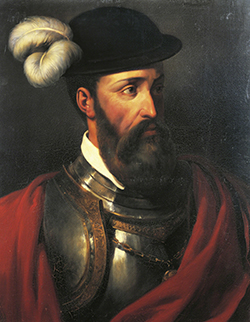 Francisco Pizarro leads the Spanish conquest of the Inca Empire.
Francisco Pizarro leads the Spanish conquest of the Inca Empire.
Sugarcane is first grown in Brazil.
(no entry for this year)
1533
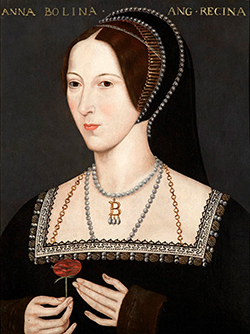 Anne Boleyn becomes Queen of England. Anne was the daughter of Thomas Boleyn (later Earl of Wiltshire), and his wife, Elizabeth Howard, and was educated in the Netherlands and France. Anne returned to England in early 1522, to marry her cousin James Butler, 9th Earl of Ormond; the marriage plans were broken off, and instead, she secured a post at court as maid of honor to Henry VIII's wife, Catherine of Aragon. Early in 1523, Anne was secretly betrothed to Henry Percy, son of Henry Percy, 5th Earl of Northumberland, but the betrothal was broken off when the Earl refused to support it. Cardinal Thomas Wolsey refused the match in January 1524. In February or March 1526, Henry VIII began his pursuit of Anne. She resisted his attempts to seduce her, refusing to become his mistress, as her sister Mary had previously been. Henry focused on annulling his marriage to Catherine, so he would be free to marry Anne. After Wolsey failed to obtain an annulment from Pope Clement VII, it became clear the marriage would not be annulled by the Catholic Church. As a result, Henry and his advisers, such as Thomas Cromwell, began breaking the Church's power in England and closing the monasteries. Henry and Anne formally married on 25 January 1533, after a secret wedding on 14 November 1532.
Anne Boleyn becomes Queen of England. Anne was the daughter of Thomas Boleyn (later Earl of Wiltshire), and his wife, Elizabeth Howard, and was educated in the Netherlands and France. Anne returned to England in early 1522, to marry her cousin James Butler, 9th Earl of Ormond; the marriage plans were broken off, and instead, she secured a post at court as maid of honor to Henry VIII's wife, Catherine of Aragon. Early in 1523, Anne was secretly betrothed to Henry Percy, son of Henry Percy, 5th Earl of Northumberland, but the betrothal was broken off when the Earl refused to support it. Cardinal Thomas Wolsey refused the match in January 1524. In February or March 1526, Henry VIII began his pursuit of Anne. She resisted his attempts to seduce her, refusing to become his mistress, as her sister Mary had previously been. Henry focused on annulling his marriage to Catherine, so he would be free to marry Anne. After Wolsey failed to obtain an annulment from Pope Clement VII, it became clear the marriage would not be annulled by the Catholic Church. As a result, Henry and his advisers, such as Thomas Cromwell, began breaking the Church's power in England and closing the monasteries. Henry and Anne formally married on 25 January 1533, after a secret wedding on 14 November 1532.
(no entry for this year)
1534
(no entry for this year)
(no entry for this year)
1535
(no entry for this year)
(no entry for this year)
1537
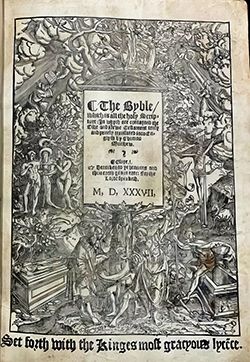 William Tyndale's partial translation of the Bible into English is published, which would eventually be incorporated into the King James Bible.
William Tyndale's partial translation of the Bible into English is published, which would eventually be incorporated into the King James Bible.
(no entry for this year)
1538
(no entry for this year)
(no entry for this year)
1539
Spain annexes Cuba.
(no entry for this year)
1540
Hernando de Alarcón sets sail to explore the Baja California peninsula; on September 26 he enters the Colorado River.
The Society of Jesus, or the Jesuits, is founded by Ignatius of Loyola and six companions with the approval of Pope Paul III.
(no entry for this year)
1541
(no entry for this year)
1542
Juan Rodríguez Cabrillo explores the coast of California.
Pope Paul III establishes the Inquisition in Rome.
War resumes between Francis I of France and Emperor Charles V. This time Henry VIII is allied with the Emperor, while James V of Scotland and Sultan Suleiman I are allied with the French.
(no entry for this year)
1543
(no entry for this year)
(no entry for this year)
1544
(no entry for this year)
(no entry for this year)
1545
(no entry for this year)
(no entry for this year)
1546
(no entry for this year)
(no entry for this year)
1547
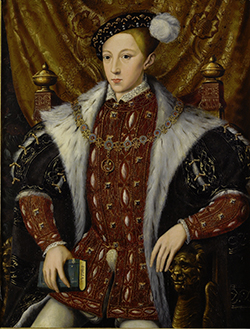 Edward VI becomes King of England and Ireland on 28 January and is crowned on 20 February at the age of 9. The son of Henry VIII and Jane Seymour, Edward was England's first monarch to be raised as a Protestant. During his reign, the realm was governed by a Regency Council because he never reached his majority.
Edward VI becomes King of England and Ireland on 28 January and is crowned on 20 February at the age of 9. The son of Henry VIII and Jane Seymour, Edward was England's first monarch to be raised as a Protestant. During his reign, the realm was governed by a Regency Council because he never reached his majority.
 Grand Prince Ivan the Terrible is crowned tsar of (All)Russia, thenceforth becoming the first Russian tsar.
Grand Prince Ivan the Terrible is crowned tsar of (All)Russia, thenceforth becoming the first Russian tsar.
(no entry for this year)
1548
Battle of Uedahara: Firearms are used for the first time on the battlefield in Japan.
(no entry for this year)
1549
(no entry for this year)
(no entry for this year)
1550
(no entry for this year)
(no entry for this year)
1551
(no entry for this year)
(no entry for this year)
1552
(no entry for this year)
(no entry for this year)
1553
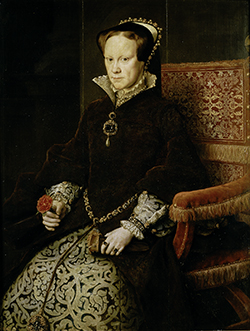 Mary Tudor becomes the first queen regnant of England and restores the Church of England under Papal authority.
Mary Tudor becomes the first queen regnant of England and restores the Church of England under Papal authority.
Venetian mathematician Giambattista Benedetti publishes two editions of Demonstratio proportionum motuum localium, developing his new doctrine of the speed of bodies in free fall.
1554
(no entry for this year)
(no entry for this year)
1555
(no entry for this year)
(no entry for this year)
1556
Pomponio Algerio, 25-year-old radical theologian, is executed by boiling in oil as part of the Roman inquisition. After refusing to conform to Church doctrine, he was sentenced to prison and asked to reconsider his Lutheran beliefs. After a year behind bars, he still refused to reconsider. Because Venetian authorities would not consent to an execution, Pope Paul IV sent officials to extradite Pomponio to Rome. In Rome, on 21 August 1555, a monk from the brotherhood of St John the Beheaded visited Pomponio in his cell urging him to repent. If he repented, he would be strangled before burning. The 24-year-old student refused. One year later, on 22 August 1556, he was executed by civil authorities in the Piazza Navona, Rome. Maintaining his composure while he was boiled in oil, he stayed alive for 15 minutes before dying.
The Shaanxi earthquake in China, during the Ming Dynasty, is history's deadliest known earthquake, killing approximately 830,000 people.
(no entry for this year)
1557
(no entry for this year)
(no entry for this year)
1558
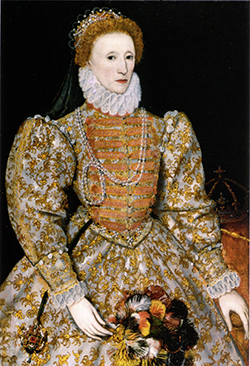 Elizabeth Tudor becomes Queen Elizabeth I at age 25. Sometimes called The Virgin Queen, Gloriana or Good Queen Bess, the childless Elizabeth was the last monarch of the Tudor dynasty. Elizabeth was the daughter of Henry VIII and Anne Boleyn, his second wife, who was executed two-and-a-half years after Elizabeth's birth. Anne's marriage to Henry VIII was annulled, and Elizabeth was declared illegitimate. Elizabeth's reign is known as the Elizabethan era. The period is famous for the flourishing of English drama, led by playwrights such as William Shakespeare and Christopher Marlowe, and for the seafaring prowess of English adventurers such as Francis Drake.
Elizabeth Tudor becomes Queen Elizabeth I at age 25. Sometimes called The Virgin Queen, Gloriana or Good Queen Bess, the childless Elizabeth was the last monarch of the Tudor dynasty. Elizabeth was the daughter of Henry VIII and Anne Boleyn, his second wife, who was executed two-and-a-half years after Elizabeth's birth. Anne's marriage to Henry VIII was annulled, and Elizabeth was declared illegitimate. Elizabeth's reign is known as the Elizabethan era. The period is famous for the flourishing of English drama, led by playwrights such as William Shakespeare and Christopher Marlowe, and for the seafaring prowess of English adventurers such as Francis Drake.
(no entry for this year)
1559
Led by Don Tristán de Luna y Arellano, a Spanish missionary colony of 1500 men on thirteen ships arrives from Vera Cruz at Pensacola Bay, founding the first European settlement on the mainland United States. On September 19, the colony is decimated by a hurricane.
(no entry for this year)
1560
 By winning the Battle of Okehazama, Oda Nobunaga becomes one of the pre-eminent warlords of Japan.
By winning the Battle of Okehazama, Oda Nobunaga becomes one of the pre-eminent warlords of Japan.
(no entry for this year)
1561
(no entry for this year)
(no entry for this year)
1562
Britain Joins Slave Trade. John Hawkins, the first Briton to take part in the slave trade, makes a huge profit hauling human cargo from Africa to Hispaniola.
(no entry for this year)
1563
(no entry for this year)
(no entry for this year)
1564
(no entry for this year)
(no entry for this year)
1565
(no entry for this year)
(no entry for this year)
1566
(no entry for this year)
(no entry for this year)
1567
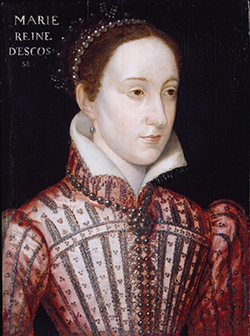 Mary, Queen of Scots, is imprisoned by Elizabeth I. Mary, the only surviving legitimate child of James V of Scotland, was six days old when her father died and she acceded to the throne. Mary had previously claimed Elizabeth's throne as her own and was considered the legitimate sovereign of England by many English Catholics, including participants in a rebellion known as the Rising of the North. Perceiving her as a threat, Elizabeth had her confined in various castles and manor houses in the interior of England. After eighteen and a half years in custody, Mary was found guilty of plotting to assassinate Elizabeth in 1586. She was beheaded the following year.
Mary, Queen of Scots, is imprisoned by Elizabeth I. Mary, the only surviving legitimate child of James V of Scotland, was six days old when her father died and she acceded to the throne. Mary had previously claimed Elizabeth's throne as her own and was considered the legitimate sovereign of England by many English Catholics, including participants in a rebellion known as the Rising of the North. Perceiving her as a threat, Elizabeth had her confined in various castles and manor houses in the interior of England. After eighteen and a half years in custody, Mary was found guilty of plotting to assassinate Elizabeth in 1586. She was beheaded the following year.
(no entry for this year)
1568
The Transylvanian Diet, under the patronage of the prince John Sigismund Zápolya, the former King of Hungary, inspired by the teachings of Ferenc Dávid, the founder of the Unitarian Church of Transylvania, promulgates the Edict of Torda, the first law of Freedom of religion and of conscience in the World.
(no entry for this year)
1569
(no entry for this year)
(no entry for this year)
1570
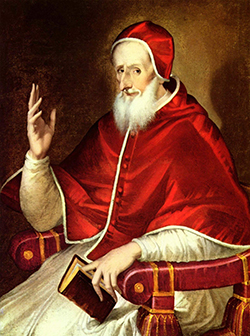 Pope Pius V issues Regnans in Excelsis, a papal bull excommunicating all who obeyed Elizabeth I and calling on all Roman Catholics to rebel against her.
Pope Pius V issues Regnans in Excelsis, a papal bull excommunicating all who obeyed Elizabeth I and calling on all Roman Catholics to rebel against her.
(no entry for this year)
1571
The Ottoman Empire suffered a major defeat at the Battle of Lepanto, a naval battle fought against a coalition of Christian states led by the Holy League. Despite the loss, the Ottoman navy remained a dominant force in the Mediterranean.
(no entry for this year)
1572
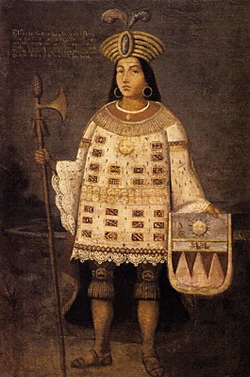 The last Inca leader Tupak Amaru apprehended by Spanish conquistadores at Vilcabamba, Peru, and executed in Cuzco.
The last Inca leader Tupak Amaru apprehended by Spanish conquistadores at Vilcabamba, Peru, and executed in Cuzco.
(no entry for this year)
1573
(no entry for this year)
(no entry for this year)
1574
(no entry for this year)
(no entry for this year)
1575
(no entry for this year)
(no entry for this year)
1576
English navigator Martin Frobisher sights Greenland.
(no entry for this year)
1577
(no entry for this year)
(no entry for this year)
1578
(no entry for this year)
(no entry for this year)
1579
Francis Drake, during his circumnavigation of the world, lands in what is now California, which he claims for Queen Elizabeth I of England as Nova Albion.
(no entry for this year)
1580
Francis Drake in the Golden Hind sails into Plymouth having completed the second circumnavigation of the world, westabout, begun in 1577.
Spain unifies with Portugal under Philip II. The struggle for the throne of Portugal ends the Portuguese Empire. The Spanish and Portuguese crowns are united for 60 years, i.e. until 1640.
(no entry for this year)
1581
Slaves in Florida Spanish residents in St. Augustine, the first permanent settlement in Florida, import African slaves.
(no entry for this year)
1582
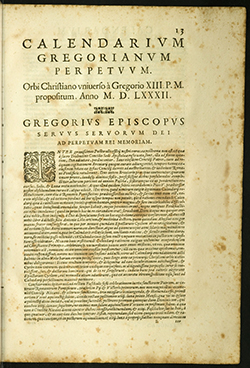 Pope Gregory XIII issues papal bull Inter Gravissimas, thereby establishing the The Gregorian Calendar. The last day of the Julian calendar was Thursday, 4 October 1582 and this was followed by the first day of the Gregorian calendar, Friday, 15 October 1582.
Pope Gregory XIII issues papal bull Inter Gravissimas, thereby establishing the The Gregorian Calendar. The last day of the Julian calendar was Thursday, 4 October 1582 and this was followed by the first day of the Gregorian calendar, Friday, 15 October 1582.
(no entry for this year)
1583
(no entry for this year)
(no entry for this year)
1584
Walter Raleigh sends Philip Amadas and Arthur Barlowe to explore the Outer Banks of Virginia (now North Carolina), with a view to establishing an English colony; they locate Roanoke Island.
(no entry for this year)
1585
(no entry for this year)
Galileo publishes La Billancetta, describing an accurate balance to weigh objects in air or water.
1586
(no entry for this year)
(no entry for this year)
1587
Mary, Queen of Scots, is executed by Elizabeth I.
(no entry for this year)
1588
(no entry for this year)
(no entry for this year)
1589
(no entry for this year)
Glass lenses are developed in the Netherlands and used for the first time in microscopes and telescopes.
1590
At the Siege of Odawara the Go-Hojo clan surrendered to Toyotomi Hideyoshi, unifying Japan.
(no entry for this year)
1591
(no entry for this year)
(no entry for this year)
1592
(no entry for this year)
(no entry for this year)
1593
(no entry for this year)
(no entry for this year)
1594
(no entry for this year)
(no entry for this year)
1595
A Spanish expedition led by lvaro de Menda a de Neira makes the first European landing in Polynesia, on the Marquesas Islands.
(no entry for this year)
1596
(no entry for this year)
(no entry for this year)
1597
(no entry for this year)
(no entry for this year)
1598
(no entry for this year)
(no entry for this year)
1599
(no entry for this year)
(no entry for this year)
1600
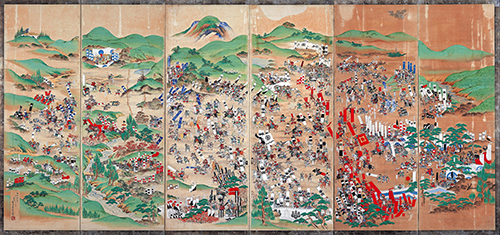 Battle of Sekigahara in Japan. End of the Warring States period and beginning of the Edo period.
Battle of Sekigahara in Japan. End of the Warring States period and beginning of the Edo period.
(no entry for this year)
1601
(no entry for this year)
(no entry for this year)
1602
The Dutch East India Company (VOC) is established by merging competing Dutch trading companies.[4] Its success contributes to the Dutch Golden Age.
(no entry for this year)
1603
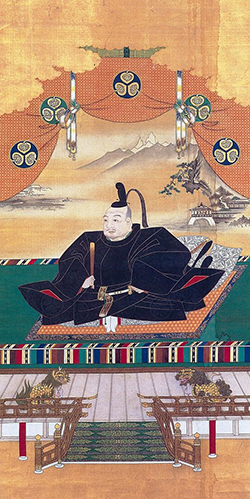 Tokugawa Ieyasu takes the title of Shogun, establishing the Tokugawa Shogunate. This begins the Edo period, which will last until 1869.
Tokugawa Ieyasu takes the title of Shogun, establishing the Tokugawa Shogunate. This begins the Edo period, which will last until 1869.
(no entry for this year)
1604
(no entry for this year)
(no entry for this year)
1605
Johann Carolus of Germany publishes the 'Relation', the first newspaper.
Tokugawa Ieyasu passes the title of Shogun to his son, Tokugawa Hidetada, and "retires" to Sunpu.
(no entry for this year)
1606
Captain Willem Janszoon and his crew aboard the Dutch East India Company ship Duyfken becomes the first recorded Europeans to sight and make landfall in Australia.
(no entry for this year)
1607
Jamestown, Virginia, is settled as what would become the first permanent English colony in North America.
(no entry for this year)
1608
Quebec City founded by Samuel de Champlain in New France (present-day Canada).
(no entry for this year)
1609
(no entry for this year)
(no entry for this year)
1610
(no entry for this year)
(no entry for this year)
1611
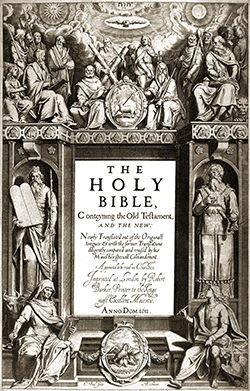 King James Bible is first published. The KJV is an English translation of the Christian Bible for the Church of England begun in 1604 and completed in 1611. The books of the King James Version include the 39 books of the Old Testament, an intertestamental section containing 14 books of the Apocrypha (most of which correspond to books in the Vulgate Deuterocanon adhered to by Roman Catholics), and the 27 books of the New Testament. It was first printed by the King's Printer Robert Barker and was the third translation into English approved by the English Church authorities.
King James Bible is first published. The KJV is an English translation of the Christian Bible for the Church of England begun in 1604 and completed in 1611. The books of the King James Version include the 39 books of the Old Testament, an intertestamental section containing 14 books of the Apocrypha (most of which correspond to books in the Vulgate Deuterocanon adhered to by Roman Catholics), and the 27 books of the New Testament. It was first printed by the King's Printer Robert Barker and was the third translation into English approved by the English Church authorities.
(no entry for this year)
1612
The first commercial tobacco crop is raised in Jamestown, Virginia.
(no entry for this year)
1613
(no entry for this year)
(no entry for this year)
1614
(no entry for this year)
(no entry for this year)
1615
(no entry for this year)
(no entry for this year)
1616
Death of retired Shogun Tokugawa Ieyasu.
(no entry for this year)
1617
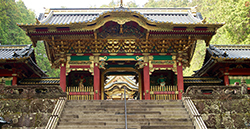 Nikko Tosho-gu Shrine, dedicated to Tokugawa Ieyasu, the founder of the Tokugawa shogunate, is built. Ieyasu is enshrined there, where his remains are also entombed. During the Edo period, the Tokugawa shogunate carried out stately processions from Edo to the Nikko Tosho-gu. The shrine's annual spring and autumn festivals reenact these occasions, and are known as processions of a thousand warriors. Five structures at Nikko Tosho-gu are categorized as National Treasures of Japan, and three more as Important Cultural Properties. The stable of the shrine's sacred horses bears a carving of the three wise monkeys, who hear, speak and see no evil, a traditional symbol in Chinese and Japanese culture.
Nikko Tosho-gu Shrine, dedicated to Tokugawa Ieyasu, the founder of the Tokugawa shogunate, is built. Ieyasu is enshrined there, where his remains are also entombed. During the Edo period, the Tokugawa shogunate carried out stately processions from Edo to the Nikko Tosho-gu. The shrine's annual spring and autumn festivals reenact these occasions, and are known as processions of a thousand warriors. Five structures at Nikko Tosho-gu are categorized as National Treasures of Japan, and three more as Important Cultural Properties. The stable of the shrine's sacred horses bears a carving of the three wise monkeys, who hear, speak and see no evil, a traditional symbol in Chinese and Japanese culture.
(no entry for this year)
1618
Beginning of the Thirty Years War..
The Manchus start invading China. Their conquest eventually topples the Ming Dynasty.
(no entry for this year)
1619
Twenty slaves in Virginia Africans brought to Jamestown are the first slaves imported into Britain's North American colonies. Like indentured servants, they were probably freed after a fixed period of service.
(no entry for this year)
1621
(no entry for this year)
(no entry for this year)
1622
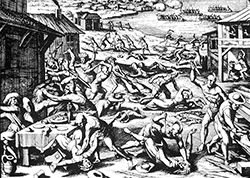 Jamestown massacre: Algonquian natives kill 347 English settlers outside Jamestown, Virginia (one-third of the colony's population) and burn the Henricus settlement.
Jamestown massacre: Algonquian natives kill 347 English settlers outside Jamestown, Virginia (one-third of the colony's population) and burn the Henricus settlement.
(no entry for this year)
1623
(no entry for this year)
Galileo presents to Cesi, founder of the Lincean Academy, a "little eyeglass" (a microscope). The invention will enable the Linceans to study natural objects with unprecedented precision. They will start with bees, then move on to flies and dust mites.
1624
(no entry for this year)
(no entry for this year)
1625
English settlers occupy the islands of Barbados and St. Kitts.
(no entry for this year)
1626
(no entry for this year)
1627
(no entry for this year)
(no entry for this year)
1628
(no entry for this year)
(no entry for this year)
1629
English troops capture Qu bec.
(no entry for this year)
1630
(no entry for this year)
(no entry for this year)
1632
Charles I of England grants a charter to Cecilius Calvert, second Lord Baltimore, for colony in Maryland
(no entry for this year)
1633
(no entry for this year)
(no entry for this year)
1634
(no entry for this year)
(no entry for this year)
1635
(no entry for this year)
(no entry for this year)
1636
Harvard College is established.
Colonial North America's slave trade begins when the first American slave carrier, Desire, is built and launched in Massachusetts.
Harvard University is founded in Cambridge, Massachusetts.
(no entry for this year)
1637
(no entry for this year)
(no entry for this year)
1638
(no entry for this year)
(no entry for this year)
1639
(no entry for this year)
(no entry for this year)
1640
John Punch, a runaway black servant, is sentenced to servitude for life. His two white companions are given extended terms of servitude. Punch is the first documented slave for life.
New Netherlands law forbids residents from harboring or feeding runaway slaves.
(no entry for this year)
1641
Massachusetts is the first colony to legalize slavery.
The D'Angola marriage is the first recorded marriage between blacks in New Amsterdam.
The Tokugawa Shogunate institutes Sakoku — foreigners are expelled and no one is allowed to enter or leave Japan.
(no entry for this year)
1642
The city of Montr al is founded in what will become Canada.
(no entry for this year)
1643
The New England Confederation of Plymouth, Massachusetts, Connecticut, and New Haven adopts a fugitive slave law.
(no entry for this year)
1644
Manchu dynasty established in China; end of the Ming line.
The Manchu conquer China ending the Ming Dynasty. The subsequent Qing Dynasty rules until 1912.
(no entry for this year)
1645
(no entry for this year)
(no entry for this year)
1646
(no entry for this year)
(no entry for this year)
1647
Peter Stuyvesant appointed governor of New Amsterdam.
George Fox founds the Society of Friends, or Quakers, in England.
(no entry for this year)
1648
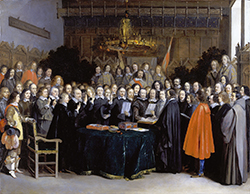 The Peace of Westphalia ends the Thirty Years' War and the Eighty Years' War and marks the ends of Spain and the Holy Roman Empire as major European powers.
The Peace of Westphalia ends the Thirty Years' War and the Eighty Years' War and marks the ends of Spain and the Holy Roman Empire as major European powers.
The Peace of Westphalia brings an end to the Thiry Years War.
(no entry for this year)
1649
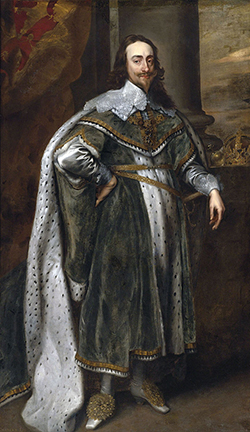 King Charles I is executed for High treason, the first and only English king to be subjected to legal proceedings in a High Court of Justice and put to death.
King Charles I is executed for High treason, the first and only English king to be subjected to legal proceedings in a High Court of Justice and put to death.
George Fox, the founder of the Society of Friends, is imprisoned at Nottingham.
(no entry for this year)
1650
Connecticut legalizes slavery.
(no entry for this year)
1651
(no entry for this year)
(no entry for this year)
1652
Massachusetts requires all black and Indian servants to receive military training.
Rhode Island passes laws restricting slavery and forbidding enslavement for more than 10 years.
(no entry for this year)
1653
Oliver Cromwell dissolves the Rump Parliament and replaces it with the Nominated Assembly (also called the Assembly of Saints or Barebones Parliament.) After three months, the Nominated Assembly passes a motion to dissolve itself and Cromwell establishes the Protectorate.
(no entry for this year)
1654
A Virginia court grants blacks the right to hold slaves.
Scotland incorporated with the English Commonwealth.
(no entry for this year)
1655
The island of Jamaica is captured from the Spaniards by the English.
(no entry for this year)
1656
The first persecution of Quakers occurs in Massachusetts.
(no entry for this year)
1657
Virginia passes a fugitive slave law.
(no entry for this year)
1658
Cromwell dies and his son Richard becomes Lord Protector.
(no entry for this year)
1659
Richard Cromwell is pressured into dissolving the Protectorate; the Rump Parliament is restored.
(no entry for this year)
1660
Charles II, King of England, orders the Council of Foreign Plantations to devise strategies for converting slaves and servants to Christianity.
End of Puritan rule in England; restoration of the Stuarts.
The Commonwealth of England ends and the monarchy is brought back during the English Restoration.
(no entry for this year)
1661
(no entry for this year)
(no entry for this year)
1662
Hereditary slavery is established, when Virginia law decrees that children of black mothers shall be bond or free according to the condition of the mother.
Massachusetts reverses a ruling dating back to 1652, which allowed blacks to train in arms. New York, Connecticut, and New Hampshire pass similar laws restricting the bearing of arms.
(no entry for this year)
1663
Charles II, King of England, gives the Carolinas to proprietors. Until the 1680s, most settlers in the region are small landowners from Barbados.
In Gloucester County, Virginia the first documented slave rebellion in the colonies takes place.
Maryland legalizes slavery.
 Isaac Newton discovers that white light is composed of different colors.
Isaac Newton discovers that white light is composed of different colors.
1664
Maryland is the first colony to take legal action against marriages between white women and black men.
New York and New Jersey legalize slavery.
The State of Maryland mandates lifelong servitude for all black slaves. New York, New Jersey, the Carolinas, and Virginia all pass similar laws.
(no entry for this year)
1665
Great Plague occurs in London.
(no entry for this year)
1666
Maryland passes a fugitive slave law.
(no entry for this year)
1667
Virginia declares that Christian baptism will not alter a person's status as a slave.
Treaty of Breda; peace established among England, Holland, France, Denmark.
(no entry for this year)
1668
The Mission of Sault Ste. Marie, in what will become Michigan, is founded by Father Marquette.
New Jersey passes a fugitive slave law.
(no entry for this year)
1669
(no entry for this year)
(no entry for this year)
1670
The Hudson Bay Company is incorporated.
The State of Virginia prohibits free blacks and Indians from keeping Christian (i.e. white) servants.
(no entry for this year)
1671
(no entry for this year)
(no entry for this year)
1672
(no entry for this year)
(no entry for this year)
1673
The Mississippi River is discovered.
(no entry for this year)
1674
New York declares that blacks who convert to Christianity after their enslavement will not be freed.
The English physicist Sir Isaac Newton argues that light is composed of particles, which are refracted by acceleration toward a denser medium, and posits the existence of aether to transmit forces between the particles.
1675
King Philip's War (sometimes called the First Indian War, Metacom's War, Metacomet's War, or Metacom's Rebellion) begins in New England. The war was an armed conflict between American Indian inhabitants of present-day New England and English colonists and their Indian allies in 1675 78. The war is named for Metacomet, the Wampanoag chief who adopted the English name Philip due to the friendly relations between his father and the Mayflower Pilgrims. The war continued in the most northern reaches of New England until the signing of the Treaty of Casco Bay in April 1678. The war was the single greatest calamity to occur in seventeenth century Puritan New England and is considered by many to be the deadliest war in the history of European settlement in North America in proportion to the population. In the space of little more than a year, twelve of the region's towns were destroyed and many more damaged, the colony's economy was all but ruined, and its population was decimated, losing one-tenth of all men available for military service. More than half of New England's towns were attacked by Indians. By early July, over 400 had surrendered to the colonists, and Metacomet took refuge in the Assowamset Swamp below Providence, close to where the war had started. The colonists formed raiding parties of militia and Indians. They were allowed to keep the possessions of warring Indians and received a bounty on all captives. Metacomet was killed by one of these teams when he was tracked down by Captain Benjamin Church and Captain Josiah Standish of the Plymouth Colony militia at Mount Hope in Bristol, Rhode Island. He was shot and killed by an Indian named John Alderman on August 12, 1676. After his death, his wife and nine-year-old son were captured and sold as slaves in Bermuda. Philip's head was mounted on a pike at the entrance to Fort Plymouth, where it remained for more than two decades. His body was cut into quarters and hung in trees. Alderman was given Metacomet's right hand as a reward.
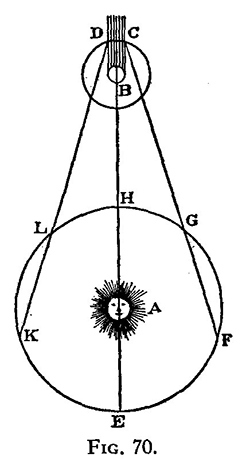 The first quantitative estimate of the speed of light was made in 1676 by Danish astronomer Ole R mer. From the observation that the periods of Jupiter's innermost moon Io appeared to be shorter when the Earth was approaching Jupiter than when receding from it, he concluded that light travels at a finite speed, and estimated that it takes light 22 minutes to cross the diameter of Earth's orbit. Christiaan Huygens combined this estimate with an estimate for the diameter of the Earth's orbit to obtain an estimate of speed of light of 220000 km/s, 26% lower than the actual value.
The first quantitative estimate of the speed of light was made in 1676 by Danish astronomer Ole R mer. From the observation that the periods of Jupiter's innermost moon Io appeared to be shorter when the Earth was approaching Jupiter than when receding from it, he concluded that light travels at a finite speed, and estimated that it takes light 22 minutes to cross the diameter of Earth's orbit. Christiaan Huygens combined this estimate with an estimate for the diameter of the Earth's orbit to obtain an estimate of speed of light of 220000 km/s, 26% lower than the actual value.
1676
In Virginia, black slaves and black and white indentured servants band together to participate in Bacon's Rebellion.
(no entry for this year)
1677
(no entry for this year)
(no entry for this year)
1678
The Treaty of Nijmegen ends various interconnected wars among France, the Dutch Republic, Spain, Brandenburg, Sweden, Denmark, the Prince-Bishopric of M nster, and the Holy Roman Empire.
(no entry for this year)
1679
The habeas corpus act is passed in England.
(no entry for this year)
1680
The State of Virginia forbids blacks and slaves from bearing arms, prohibits blacks from congregating in large numbers, and mandates harsh punishment for slaves who assault Christians or attempt escape.
The Pueblo Revolt drives the Spanish out of New Mexico until 1692.
(no entry for this year)
1681
(no entry for this year)
(no entry for this year)
1682
What will become Pennsylvania is colonized by William Penn. Penn founds Philadelphia. Also, with other Friends, Penn purchases East Jersey.
New York makes it illegal for slaves to sell goods.
Virginia declares that all imported black servants are slaves for life.
La Salle (Ren -Robert Cavelier, Sieur de La Salle) explores the length of the Mississippi River and claims Louisiana for France.
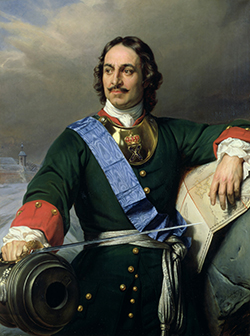 Peter the Great becomes joint ruler of Russia (sole tsar in 1696).
Peter the Great becomes joint ruler of Russia (sole tsar in 1696).
(no entry for this year)
1683
The Ottoman Empire suffered a significant defeat at the Siege of Vienna, a failed attempt to capture the city of Vienna, Austria. This marked the beginning of the empire's decline, as it was forced to cede territory and lost its status as a major European power.
The Ottoman Empire is defeated in the second Siege of Vienna.
(no entry for this year)
1684
(no entry for this year)
(no entry for this year)
1685
Edict of Fontainebleau outlaws Protestantism in France. King Charles II dies.
(no entry for this year)
1686
(no entry for this year)
(no entry for this year)
1687
(no entry for this year)
(no entry for this year)
1688
The Pennsylvania Quakers pass the first formal antislavery resolution.
(no entry for this year)
1689
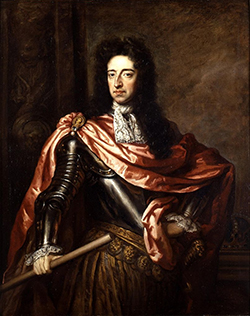 William III ascends to the throne over England, Scotland, and Ireland.
William III ascends to the throne over England, Scotland, and Ireland.
(no entry for this year)
1690
(no entry for this year)
(no entry for this year)
1691
South Carolina passes the first comprehensive slave codes.
Virginia passes the first anti-miscegenation law, forbidding marriages between whites and blacks or whites and Native Americans.
Virginia prohibits the manumission of slaves within its borders. Manumitted slaves are forced to leave the colony.
(no entry for this year)
1692
The colonies of Plymouth and Massachusetts are united.
Witchcraft mania begins to take over new England.
(no entry for this year)
1693
The College of William and Mary is founded in Williamsburg, Virginia, by a royal charter.
(no entry for this year)
1694
Rice cultivation is introduced into Carolina. Slave importation increases dramatically.
The Bank of England is established.
(no entry for this year)
1695
(no entry for this year)
(no entry for this year)
1696
The Royal African Trade Company loses its monopoly and New England colonists enter the slave trade.
(no entry for this year)
1697
(no entry for this year)
(no entry for this year)
1698
Calcutta is founded by the English.
(no entry for this year)
1699
(no entry for this year)
(no entry for this year)
1700
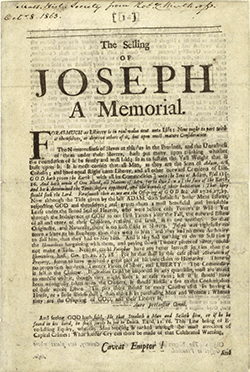 Samuel Sewall (1652-1730) publishes The Selling of Joseph — the first American protest against slavery.
Samuel Sewall (1652-1730) publishes The Selling of Joseph — the first American protest against slavery.
Pennsylvania legalizes slavery.
(no entry for this year)
1701
(no entry for this year)
(no entry for this year)
1702
New York passes An Act for Regulating Slaves. Among the prohibitions of this act are meetings of more than three slaves, trading by slaves, and testimony by slaves in court.
(no entry for this year)
1703
Delaware separates from Pennsylvania and becomes an independent colony.
Connecticut assigns the punishment of whipping to any slaves who disturb the peace or assault whites.
Massachusetts requires those masters who liberate slaves to provide a bond of 50 pounds or more in the event that the freedman becomes a public charge.
Rhode Island makes it illegal for blacks and Indians to walk at night without passes.
(no entry for this year)
1704
(no entry for this year)
(no entry for this year)
1705
Massachusetts makes marriage and sexual relations between blacks and whites illegal.
New York declares that punishment by execution will be applied to certain runaway slaves.
The Virginia Slave Code codifies slave status, declaring all non-Christian servants entering the colony to be slaves. It defines all slaves as real estate, acquits masters who kill slaves during punishment, forbids slaves and free colored peoples from physically assaulting white persons, and denies slaves the right to bear arms or move abroad without written permission.
(no entry for this year)
1706
Connecticut requires that Indians, mulattos, and black servants gain permission from their masters to engage in trade.
New York declares blacks, Indians, and slaves who kill white people to be subject to the death penalty.
(no entry for this year)
1707
(no entry for this year)
(no entry for this year)
1708
Africans in the colony of South Carolina outnumber Europeans, making it the first English colony with a black majority.
Blacks outnumber whites in South Carolina.
Rhode Island requires that slaves be accompanied by their masters when visiting the homes of free persons.
The Southern colonies require militia captains to enlist and train one slave for every white soldier.
(no entry for this year)
1709
(no entry for this year)
(no entry for this year)
1710
New York forbids blacks, Indians, and mulattos from walking at night without lighted lanterns.
(no entry for this year)
1711
Great Britain's Queen Anne overrules a Pennsylvania colonial law prohibiting slavery.
Pennsylvania prohibits the importation of blacks and Indians.
Rhode Island prohibits the clandestine importation of black and Indian slaves.
Rio de Janeiro is captured by the French.
(no entry for this year)
1712
In Charleston, South Carolina slaves are forbidden from hiring themselves out.
New York declares it illegal for blacks, Indians, and slaves to murder other blacks, Indians, and slaves.
New York forbids freed blacks, Indians, and mulatto slaves from owning real estate and holding property.
Pennsylvania prohibits the importation of slaves.
Slave Revolt: New York Slaves in New York City kill whites during an uprising, later squelched by the militia. Nineteen rebels are executed.
(no entry for this year)
1713
England secures the exclusive right to transport slaves to the Spanish colonies in America.
(no entry for this year)
1714
(no entry for this year)
(no entry for this year)
1715
Maryland declares all slaves entering the province and their descendants to be slaves for life.
Rhode Island legalizes slavery.
(no entry for this year)
1716
(no entry for this year)
(no entry for this year)
1717
New York enacts a fugitive slave law.
(no entry for this year)
1718
(no entry for this year)
(no entry for this year)
1719
(no entry for this year)
(no entry for this year)
1720
(no entry for this year)
(no entry for this year)
1721
(no entry for this year)
(no entry for this year)
1722
(no entry for this year)
(no entry for this year)
1723
Virginia abolishes manumissions.
(no entry for this year)
1724
Louisiana's Code Noir is enacted in New Orleans to regulate black slavery and to banish Jews from the colony
French Louisiana prohibits slaves from marrying without the permission of their owners.
(no entry for this year)
1725
(no entry for this year)
(no entry for this year)
1726
(no entry for this year)
(no entry for this year)
1727
(no entry for this year)
(no entry for this year)
1728
(no entry for this year)
(no entry for this year)
1729
The Qing Dynasty Emperor Yongzheng prohibits opium smoking in China. British refusal to comply with these anti-narcotics laws will ultimately lead to two wars (the Opium Wars) and the subjugation of China to Britain (and other western powers).
(no entry for this year)
1730
The number of male and female slaves imported to the North American British colonies balances out for the first time.
(no entry for this year)
1731
The Spanish reverse a 1730 decision and declare that slaves fleeing to Florida from Carolina will not be sold or returned.
(no entry for this year)
1732
Slaves aboard the ship of New Hampshire Captain John Major kill both captain and crew, seizing the vessel and its cargo.
(no entry for this year)
1733
Quaker Elihu Coleman's A Testimony against That Anti-Christian Practice of Maling Slaves of Men is published.
(no entry for this year)
1734
(no entry for this year)
(no entry for this year)
1735
Georgia petitions Britain for the legalization of slavery.
Louis XV, King of France, declares that when an enslaved woman gives birth to the child of a free man, neither mother nor child can be sold. Further, after a certain time, mother and child will be freed.
Under an English law Georgia prohibits the importation and use of black slaves.
(no entry for this year)
1736
(no entry for this year)
(no entry for this year)
1737
An indentured black servant petitions a Massachusetts court and wins his freedom after the death of his master.
(no entry for this year)
1738
Georgia's trustees permit the importation of black slaves.
Spanish Florida promises freedom and land to runaway slaves.
(no entry for this year)
1739
Slaves in Stono, South Carolina rebel, sacking and burning an armory and killing whites. Some 75 slaves in South Carolina steal weapons and flee toward freedom in Florida (then under Spanish rule). Crushed by the South Carolina militia, the revolt results in the deaths of 40 blacks and 20 whiteThe colonial militia puts an end to the rebellion before slaves are able to reach freedom in Florida.
(no entry for this year)
1740
Georgia and Carolina attempt to invade Florida in retaliation for the territory's policy toward runaways.
South Carolina passes the comprehensive Negro Act, making it illegal for slaves to move abroad, assemble in groups, raise food, earn money, and learn to read English. Owners are permitted to kill rebellious slaves if necessary.
(no entry for this year)
1741
(no entry for this year)
(no entry for this year)
1742
(no entry for this year)
(no entry for this year)
1743
(no entry for this year)
(no entry for this year)
1744
(no entry for this year)
(no entry for this year)
1745
(no entry for this year)
(no entry for this year)
1746
(no entry for this year)
(no entry for this year)
1747
(no entry for this year)
(no entry for this year)
1748
(no entry for this year)
(no entry for this year)
1749
Georgia repeals its prohibition and permits the importation of black slaves.
(no entry for this year)
1750
(no entry for this year)
 Benjamin Franklin describes electricity as a single fluid and distinguishes between positive and negative electricity in Experiments and Observations on Electricity. He shows that electricity can magnetize and demagnetize iron needles.
Benjamin Franklin describes electricity as a single fluid and distinguishes between positive and negative electricity in Experiments and Observations on Electricity. He shows that electricity can magnetize and demagnetize iron needles.
1751
Colonial South Carolina prohibits slaves from learning about or practicing medicine.
George II repeals the 1705 act, making slaves real estate in Virginia.
 The lightning conductor is invented by Benjamin Franklin, whose experiments with lightning include a flying a kite in a thunderstorm. The kite experiment shows that lightning is a form of electricity, similar to the discharge from a Leyden jar.
The lightning conductor is invented by Benjamin Franklin, whose experiments with lightning include a flying a kite in a thunderstorm. The kite experiment shows that lightning is a form of electricity, similar to the discharge from a Leyden jar.
1752
(no entry for this year)
 Russian scientist Georg Wilhelm Richmann is killed performing a lightning experiment in St. Petersburg. Richmann is electrocuted in while trying to quantify the response of an insulated rod to a nearby storm. The incident, reported worldwide, underscored the dangers inherent in experimenting with insulated rods and in using protective rods with faulty ground connections.
Russian scientist Georg Wilhelm Richmann is killed performing a lightning experiment in St. Petersburg. Richmann is electrocuted in while trying to quantify the response of an insulated rod to a nearby storm. The incident, reported worldwide, underscored the dangers inherent in experimenting with insulated rods and in using protective rods with faulty ground connections.
1753
(no entry for this year)
(no entry for this year)
1754
The French and Indian War breaks out on the North American continent between the European powers Britain and France.
(no entry for this year)
1755
 The Great Lisbon Earthquake occurs, killing more than 60,000 people. The huge earthquake (estimated at 9.0 on the modern Richter scale) strikes Lisbon, Portugal, at 9:40 am, on 1 November, during church services for All Saint's Day. Because the earthquake hits on an important church holiday and destroys almost every important church in the city, much anxiety and confusion is generated amongst the citizens of this staunch and devout Roman Catholic city and country, which had been a major patron of the Church. Theologians speculate on the religious cause and message, seeing the earthquake as a manifestation of the anger of God. Some philosophers struggle to reconcile the event with the concept that humanity lives in the best of all possible worlds — a world closely supervised by a benevolent deity.
The Great Lisbon Earthquake occurs, killing more than 60,000 people. The huge earthquake (estimated at 9.0 on the modern Richter scale) strikes Lisbon, Portugal, at 9:40 am, on 1 November, during church services for All Saint's Day. Because the earthquake hits on an important church holiday and destroys almost every important church in the city, much anxiety and confusion is generated amongst the citizens of this staunch and devout Roman Catholic city and country, which had been a major patron of the Church. Theologians speculate on the religious cause and message, seeing the earthquake as a manifestation of the anger of God. Some philosophers struggle to reconcile the event with the concept that humanity lives in the best of all possible worlds — a world closely supervised by a benevolent deity.
 William Cullen observes the cooling effect of evaporating liquids and publishes the results in An Essay on the Cold Produced by Evaporating Fluids and Other Means of Producing Cold.
William Cullen observes the cooling effect of evaporating liquids and publishes the results in An Essay on the Cold Produced by Evaporating Fluids and Other Means of Producing Cold.
1756
(no entry for this year)
(no entry for this year)
1757
(no entry for this year)
(no entry for this year)
1758
Pennsylvania Quakers forbid their members from owning slaves or participating in the slave trade.
(no entry for this year)
1759
The British capture Québec from the French.
 Photometria by German physicist Johann Lambert is an investigation of light reflections from planets, introducing the term ALBEDO (whiteness) for the differing reflectivities of planetary bodies.
Photometria by German physicist Johann Lambert is an investigation of light reflections from planets, introducing the term ALBEDO (whiteness) for the differing reflectivities of planetary bodies.
 In experiments with primitive apparatus, Daniel Bernoulli decides that the electrical force obeys an inverse square law similar to that of gravity.
In experiments with primitive apparatus, Daniel Bernoulli decides that the electrical force obeys an inverse square law similar to that of gravity.
1760
Jupiter Hammon of Long Island, New York, publishes a book of poetry. This is believed to be the first volume written and published by an African-American
New Jersey prohibits the enlistment of slaves in the militia without their master's permission.
 King George III ascends the English throne.
King George III ascends the English throne.
 Joseph Black discovers latent heat by finding that ice, when melting, absorbs heat without changing in temperature. Later he measures the latent heat of steam — that is, the heat required to keep water boiling without raising its temperature.
Joseph Black discovers latent heat by finding that ice, when melting, absorbs heat without changing in temperature. Later he measures the latent heat of steam — that is, the heat required to keep water boiling without raising its temperature.
1761
(no entry for this year)
(no entry for this year)
1762
Virginia restricts voting rights to white men.
 Catherine the Great becomes Empress of all the Russias after death of her husband.
Catherine the Great becomes Empress of all the Russias after death of her husband.
(no entry for this year)
1763
Charles Mason and Jeremiah Dixon begin surveying Mason-Dixon Line between Pennsylvania and Maryland.
 Chief Pontiac leads a Native American rebellion against British settlers in and around Detroit.
Chief Pontiac leads a Native American rebellion against British settlers in and around Detroit.
The French Indian War ends with the Treaty of Paris surrendering Canada to England.
(no entry for this year)
1764
(no entry for this year)
 Leonhard Euler gives a general treatment of the motion of rigid bodies, including the precession and nutation of earth, in Theoria motus corporum solidorum seu rigidorum (Theory of the motion of solid and rigid bodies).
Leonhard Euler gives a general treatment of the motion of rigid bodies, including the precession and nutation of earth, in Theoria motus corporum solidorum seu rigidorum (Theory of the motion of solid and rigid bodies).
1765
Britain enacts Quartering Act, requiring colonists to provide temporary housing to British soldiers.
Stamp Act passed; this is the first direct British tax on colonists.
 Horace-Bénédict de Saussure invents the electrometer, a device for measuring the electric potential by means of the attraction or repulsion of charged bodies.
Horace-Bénédict de Saussure invents the electrometer, a device for measuring the electric potential by means of the attraction or repulsion of charged bodies.
1766
Britain repeals the Stamp Act.
(no entry for this year)
1767
Britain passes Townshend Revenue Act levying taxes on America.
The Virginia House of Burgess boycotts the British slave trade in protest of the Townsend Acts. Georgia and the Carolinas follow suit.
(no entry for this year)
1768
 Britain's Capt. James Cook begins exploring the Pacific, putting ashore in such places as New Zealand and Australia.
Britain's Capt. James Cook begins exploring the Pacific, putting ashore in such places as New Zealand and Australia.
 John Robison measures the repulsion between two charged bodies and shows that this force is inversely proportional to the distance between the two bodies.
John Robison measures the repulsion between two charged bodies and shows that this force is inversely proportional to the distance between the two bodies.
1769
 Father Junipero Serra founds Mission San Diego, first mission in California.
Father Junipero Serra founds Mission San Diego, first mission in California.
(no entry for this year)
1770
 Crispus Attucks, an escaped slave, becomes the first colonial resident to die for American independence when he is killed by the British in the Boston massacre.
Crispus Attucks, an escaped slave, becomes the first colonial resident to die for American independence when he is killed by the British in the Boston massacre.
Around 1770, the European slave trade with Africa reaches its peak, transporting nearly 80,000 enslaved Africans across the Atlantic annually.
Escaped slave, Crispus Attucks, is killed by British forces in Boston, Massachusetts. He is one of the first colonists to die in the war for independence.
Swedish scientist Johan Carl Wilcke calculates the latent heat of ice (the amount of heat absorbed when ice turns into water).
1772
 On June 22, Lord Chief Mansfield rules in the James Somerset case that an enslaved person brought to England becomes free and cannot be returned to slavery. His ruling establishes the legal basis for the freeing of England's fifteen thousand slaves.
On June 22, Lord Chief Mansfield rules in the James Somerset case that an enslaved person brought to England becomes free and cannot be returned to slavery. His ruling establishes the legal basis for the freeing of England's fifteen thousand slaves.
James Albert Ukawsaw Gronniosaw's writes the first autobiographical slave narrative.
(no entry for this year)
1773
Jean Baptiste Point du Sable is the first settler in the community now known as Chicago. Point du Sable described himself as "a free mulatto man." He was married to a Potawatomi woman named Catherine some time in the 1770s.
 Phillis Wheatley of Boston publishes Poems on Various Subjects, Religious and Moral. This is the first book of poetry published by an African-American woman.
Phillis Wheatley of Boston publishes Poems on Various Subjects, Religious and Moral. This is the first book of poetry published by an African-American woman.
Phillis Wheatley becomes the first published African-American poet when a London publishing company releases a collection of her verse.
Slaves in Massachusetts unsuccessfully petition the government for their freedom.
The first separate black church in America is founded in South Carolina.
The "Boston Tea Party" occurs as a protest against British taxation policies.
(no entry for this year)
1774
Rhode Island becomes first colony to prohibit importation of slaves.
Connecticut, Rhode Island, and Georgia prohibit the importation of slaves.
The First Continental Congress bans trade with Britain and vows to discontinue the slave trade after the 1st of December.
Virginia takes action against slave importation.
 Alessandro Volta describes his electrofore perpetuo device for producing and storing a charge of static electricity. This device replaces the Leyden jar and eventually leads to modern electrical condensers.
Alessandro Volta describes his electrofore perpetuo device for producing and storing a charge of static electricity. This device replaces the Leyden jar and eventually leads to modern electrical condensers.
1775
Lord Dunmore, promises freedom to male slaves who join British army.
 General Washington forbids recruiting officers enlisting blacks to fight in defense of American freedom.
General Washington forbids recruiting officers enlisting blacks to fight in defense of American freedom.
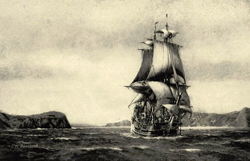 The first Spanish ship, the San Carlos, commanded by Juan Manuel de Ayala, enters San Francisco Bay.
The first Spanish ship, the San Carlos, commanded by Juan Manuel de Ayala, enters San Francisco Bay.
 The Grand Union flag is adopted by the American colonies in rebellion against England.
The Grand Union flag is adopted by the American colonies in rebellion against England.
Abolitionist Society Anthony Benezet of Philadelphia founds the world's first abolitionist society. Benjamin Franklin becomes its president in 1787.
In April, the first battles of the Revolutionary war are waged between the British and Colonial armies at Lexington and Concord, Massachusetts. Black Minutemen participate in the fighting.
In July, George Washington announces a ban on the enlistment of free blacks and slaves in the colonial army. By the end of the year, he reverses the ban, ordering the Continental Army to accept the service of free blacks.
In November, Virginia Governor John Murray, Lord Dunmore, issues a proclamation announcing that any slave fighting on the side of the British will be liberated.
The slave population in the colonies is nearly 500,000. In Virginia, the ratio of free colonists to slaves is nearly 1:1. In South Carolina it is approximately 1:2. 1775 Georgia takes action against slave importation.
Benjamin Franklin and Benjamin Rush form an anti-slavery group in Philadelphia.
The American Revolution begins with fighting at Lexington and Concord, Massachusetts.
The Continental Congress appoints George Washington head of the Continental Army.
 Pierre-Simon Laplace states that if all of the forces on all objects in any one time are known, then the future can be completely predicted.
Pierre-Simon Laplace states that if all of the forces on all objects in any one time are known, then the future can be completely predicted.
1776
Presidio of San Francisco forms as a Spanish fort.
Continental Congress approves enlistment of free blacks .
Delaware prohibits the importation of African slaves.
In Philadelphia, Pennsylvania, members of the Continental Congress sign the Declaration of Independence.
In Philadelphia, Pennsylvania, the Society of Friends, also known as the Quakers, forbids its members from holding slaves.
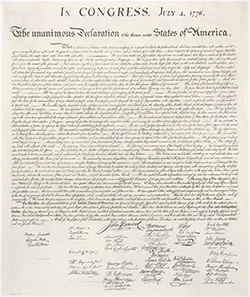 Declaration of Independence published. The Declaration of Independence is the statement adopted by the Second Continental Congress meeting at the Pennsylvania State House (Independence Hall) in Philadelphia on July 4, 1776, which announced that the thirteen American colonies, then at war with the Kingdom of Great Britain, regarded themselves as thirteen newly independent sovereign states, and no longer under British rule. Instead they formed a new nation — the United States of America. John Adams was a leader in pushing for independence, which was passed on July 2 with no opposing vote cast. A committee of five had already drafted the formal declaration, to be ready when Congress voted on independence. The term "Declaration of Independence" is not used in the document itself. Although Americans generally regard themselves as having been independent since July 4, 1776, in fact true, legal independence was not achieved until the Treaty of Paris was signed in 1783 and ratified by the Congress of the Confederation on January 14, 1784.
Declaration of Independence published. The Declaration of Independence is the statement adopted by the Second Continental Congress meeting at the Pennsylvania State House (Independence Hall) in Philadelphia on July 4, 1776, which announced that the thirteen American colonies, then at war with the Kingdom of Great Britain, regarded themselves as thirteen newly independent sovereign states, and no longer under British rule. Instead they formed a new nation — the United States of America. John Adams was a leader in pushing for independence, which was passed on July 2 with no opposing vote cast. A committee of five had already drafted the formal declaration, to be ready when Congress voted on independence. The term "Declaration of Independence" is not used in the document itself. Although Americans generally regard themselves as having been independent since July 4, 1776, in fact true, legal independence was not achieved until the Treaty of Paris was signed in 1783 and ratified by the Congress of the Confederation on January 14, 1784.
 Adam Smith publishes The Wealth of Nations, which lays the foundation for free-market capitalism.
Adam Smith publishes The Wealth of Nations, which lays the foundation for free-market capitalism.
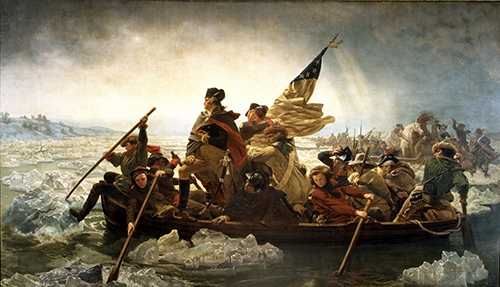 Washington leads the Continental Army in a crossing of the Delaware River, beginning on Christmas Day. The crossing catches the British army unaware, resulting in a victory for the rebel forces.
Washington leads the Continental Army in a crossing of the Delaware River, beginning on Christmas Day. The crossing catches the British army unaware, resulting in a victory for the rebel forces.
 Charles-Augustin Coulomb invents the torsion balance.
Charles-Augustin Coulomb invents the torsion balance.
1777
San Jose, California, is founded on orders from Antonio María de Bucareli y Ursúa, Spanish Viceroy of New Spain, thus providing an answer to the not-yet-asked question, Do you know the way to San Jose?
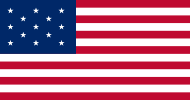 Continental Congress adopts the Stars and Stripes replacing the Grand Union flag. The new flag has thirteen stars and thirteen stripes, representing the thirteen original states: Delaware, Pennsylvania, New Jersey, Georgia, Connecticut, Massachusetts, Maryland, South Carolina, New Hampshire, Virginia, New York, North Carolina, and Rhode Island.
Continental Congress adopts the Stars and Stripes replacing the Grand Union flag. The new flag has thirteen stars and thirteen stripes, representing the thirteen original states: Delaware, Pennsylvania, New Jersey, Georgia, Connecticut, Massachusetts, Maryland, South Carolina, New Hampshire, Virginia, New York, North Carolina, and Rhode Island.
Vermont amends its constitution to ban slavery. Over the next 25 years, other Northern states emancipate their slaves and ban the institution: Pennsylvania, 1780; Massachusetts and New Hampshire, 1783; Connecticut and Rhode Island, 1784; New York, 1799; and New Jersey, 1804. Some of the state laws stipulate gradual emancipation.
New York enfranchises all free propertied men regardless of color or prior servitude.
Vermont is the first of the thirteen colonies to abolish slavery and enfranchise all adult males.
(no entry for this year)
1778
Rhode Island forbids the removal of slaves from the state.
Virginia prohibits the importation of slaves.
(no entry for this year)
1779
 Capt. James Cook dies during a skirmish in Hawaii.
Capt. James Cook dies during a skirmish in Hawaii.
(no entry for this year)
1780
Massachusetts abolishes slavery and grants African-American men the right to vote.
A freedom clause in the Massachusetts constitution is interpreted as an abolishment of slavery. Massachusetts enfranchises all men regardless of race.
Delaware makes it illegal to enslave imported Africans.
Pennsylvania begins gradual emancipation.
Great Hurricane of 1780 — the deadliest Atlantic hurricane on record — kills 20,000 to 30,000 in Caribbean.
Johan Carl Wilcke introduces the concept of SPECIFIC HEAT.
 Coloumb's Théorie des machiones simple (Theory of simple machines) is a study of friction.
Coloumb's Théorie des machiones simple (Theory of simple machines) is a study of friction.
1781
Los Angeles, California, is founded by 54 settlers, including 26 of African ancestry.
 Immanuel Kant publishes Critique of Pure Reason, a fundamental work of modern philosophy.
Immanuel Kant publishes Critique of Pure Reason, a fundamental work of modern philosophy.
(no entry for this year)
1782
Britain signs agreement recognizing U.S. independence.
Congress approves Great Seal of U.S. and the eagle as its symbol.
 Horace-Bénédict de Saussure's Essais sur l'hygromé (Essay on measuring humidity) describes how to construct a hygrometer from human hair that can measure relative humidity.
Horace-Bénédict de Saussure's Essais sur l'hygromé (Essay on measuring humidity) describes how to construct a hygrometer from human hair that can measure relative humidity.
1783
American Revolution Ends Britain and the infant United States sign the Peace of Paris treaty.
Earthquakes ravage Calabria in Italy, killing 30,000.
George Atwood accurately determines the acceleration of a free-falling body.
1784
John Jay becomes first U.S. Secretary of State.
Russian trappers established a colony on Kodiak Island, Alaska.
Congress narrowly defeats Thomas Jefferson's proposal to ban slavery in new territories after 1800.
Treaty of Paris ratified, officially ending the American Revolutionary War
Congress of the Confederation ratifies the Treaty of Paris on January 14, 1784, formally ending the Revolutionary War.
John Wesley charters Methodist Church.
 Couloumb makes precise measurements of the forces of attraction and repulsion between charged bodies and between magnetic poles, using a torsion balance, demonstrating conclusively that electric charge and magnetism obey inverse-square laws like that of gravity. He also discovers that electrically charged bodies discharge spontaneously. In the 20th century, it is found that cosmic radiation is responsible for this discharge.
Couloumb makes precise measurements of the forces of attraction and repulsion between charged bodies and between magnetic poles, using a torsion balance, demonstrating conclusively that electric charge and magnetism obey inverse-square laws like that of gravity. He also discovers that electrically charged bodies discharge spontaneously. In the 20th century, it is found that cosmic radiation is responsible for this discharge.
1785
New York frees all slaves who served in the Revolutionary Army.
Napoleon Bonaparte (16) graduates from the military academy in Paris (42nd in a class of 51).
(no entry for this year)
1786
 Frederick the Great, King of Prussia, dies.
Frederick the Great, King of Prussia, dies.
 Jacques-Alexandre Charles shows that different gases expand by the same amount for a given rise in temperature (Charles Law).
Jacques-Alexandre Charles shows that different gases expand by the same amount for a given rise in temperature (Charles Law).
1787
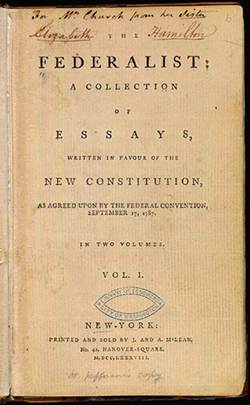 Federalist Papers published, calls for ratification of Constitution. The Federalist (later known as The Federalist Papers) is a collection of 85 articles and essays written (under the pseudonym Publius) by Alexander Hamilton, James Madison, and John Jay promoting the ratification of the United States Constitution. Seventy-seven were published serially in the Independent Journal and the New York Packet between October 1787 and August 1788. A compilation of these and eight others, called The Federalist: A Collection of Essays, Written in Favour of the New Constitution, as Agreed upon by the Federal Convention, September 17, 1787, was published in two volumes in 1788 by J. and A. McLean. The collection's original title was The Federalist; the title The Federalist Papers did not emerge until the 20th century. This book should be carefully read by anyone with an interest in American democracy.
Federalist Papers published, calls for ratification of Constitution. The Federalist (later known as The Federalist Papers) is a collection of 85 articles and essays written (under the pseudonym Publius) by Alexander Hamilton, James Madison, and John Jay promoting the ratification of the United States Constitution. Seventy-seven were published serially in the Independent Journal and the New York Packet between October 1787 and August 1788. A compilation of these and eight others, called The Federalist: A Collection of Essays, Written in Favour of the New Constitution, as Agreed upon by the Federal Convention, September 17, 1787, was published in two volumes in 1788 by J. and A. McLean. The collection's original title was The Federalist; the title The Federalist Papers did not emerge until the 20th century. This book should be carefully read by anyone with an interest in American democracy.
Constitutional convention opens at Philadelphia, George Washington presiding.
The Northwest Ordinance bans slavery in the Northwest Territory (what becomes the states of Ohio, Indiana, Illinois, Michigan, and Wisconsin). The ordinance together with state emancipation laws create a free North.
Austrian emperor Jozef II bans children under 8 from labor.
(no entry for this year)
1788
Maryland votes (December 23) to cede a ten-square-mile area for District of Columbia.
New York City becomes first capital of US.
The Massachusetts General Court (legislature), following an incident in which free blacks were kidnapped and transported to the island of Martinique, declares the slave trade illegal and provides monetary damages to victims of kidnappings.
Captain Arthur Phillip forms English colony at Sydney, Botany Bay, New South Wales, Australia.
 Kant publishes Critique of Practical Reason.
Kant publishes Critique of Practical Reason.
The French chemist Antoine-Laurent de Lavoisier definitively states the Law of Conservation of Mass (although others had previously expressed similar ideas, including the ancient Greek Epicurus, the medieval Persian Nasir al-Din al-Tusi and the 18th Century scientists Mikhail Lomonosov, Joseph Black, Henry Cavendish and Jean Rey), and identifies (albeit slightly incorrectly) 23 elements which he claims can not be broken down into simpler substances.
1789
US Congress passes Federal Judiciary Act, creating a six-person Supreme Court.
 George Washington becomes the first president of the United States.
George Washington becomes the first president of the United States.
 Fletcher Christian leads Mutiny on HMS Bounty and Captain William Bligh. Mutineers from the Bounty settle on Pitcairn Island.
Fletcher Christian leads Mutiny on HMS Bounty and Captain William Bligh. Mutineers from the Bounty settle on Pitcairn Island.
 Former slave Olaudah Equiano publishes his memoirs, and he travels in Britain lecturing against slavery.
Former slave Olaudah Equiano publishes his memoirs, and he travels in Britain lecturing against slavery.
The fall of the Bastille marks the beginning of the French Revolution.
(no entry for this year)
1790
First U.S. census is conducted, showing a population of 3,939,214.
Society of Friends petitions Congress for abolition of slavery.
The first ten amendments to the US Constitution — The Bill of Rights — are ratified.
Washington, D.C., founded as the capitol of the United States.
 Luigi Galvani announces that electricity applied to severed frog's legs causes them to twitch and that frogs legs twitch in the presence of two different metals with no electric current present. The latter discovery eventually leads to Alessandro Volta's developing the electric battery.
Luigi Galvani announces that electricity applied to severed frog's legs causes them to twitch and that frogs legs twitch in the presence of two different metals with no electric current present. The latter discovery eventually leads to Alessandro Volta's developing the electric battery.
 Pierre Prévost develops his theory of exchanges of radiation of heat. He correctly shows that cold is merely the absence of heat and that all bodies continually radiate heat. If they seem not to radiate heat, it means that they are in heat equilibrium with their environment.
Pierre Prévost develops his theory of exchanges of radiation of heat. He correctly shows that cold is merely the absence of heat and that all bodies continually radiate heat. If they seem not to radiate heat, it means that they are in heat equilibrium with their environment.
1791
Vermont admitted as 14th state (first addition to the original thirteen colonies).
(no entry for this year)
1792
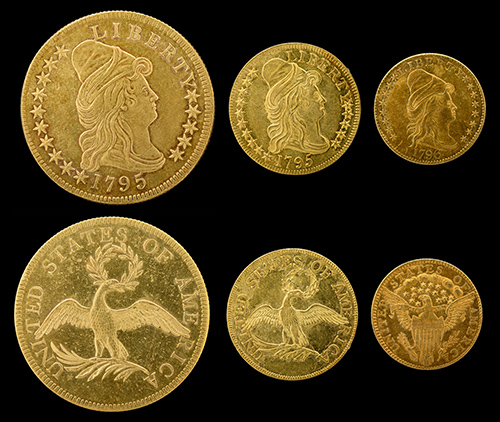 The Coinage Act of 1792 (also known as the Mint Act; officially: An act establishing a mint, and regulating the Coins of the United States), passed by the United States Congress on April 2, 1792, created the United States dollar as the country's standard unit of money, established the United States Mint, and regulated the coinage of the United States. This act established the silver dollar as the unit of money in the United States, declared it to be lawful tender, and created a decimal system for U.S. currency. The Act specified the issuing of three gold coins comprising a $10 gold coin called an "eagle", a $5 coin called a "half eagle", and a $2.5 coin called a "quarter eagle". The Act also authorized construction of a mint building in Philadelphia, the nation's capital at the time. This was the first federal building erected under the United States Constitution. Adjusted for inflation, the ten-dollar coin would be worth $231.00 in today's money. As collector's items, these gold coins have sold for more than $100,000 each.
The Coinage Act of 1792 (also known as the Mint Act; officially: An act establishing a mint, and regulating the Coins of the United States), passed by the United States Congress on April 2, 1792, created the United States dollar as the country's standard unit of money, established the United States Mint, and regulated the coinage of the United States. This act established the silver dollar as the unit of money in the United States, declared it to be lawful tender, and created a decimal system for U.S. currency. The Act specified the issuing of three gold coins comprising a $10 gold coin called an "eagle", a $5 coin called a "half eagle", and a $2.5 coin called a "quarter eagle". The Act also authorized construction of a mint building in Philadelphia, the nation's capital at the time. This was the first federal building erected under the United States Constitution. Adjusted for inflation, the ten-dollar coin would be worth $231.00 in today's money. As collector's items, these gold coins have sold for more than $100,000 each.
U.S. postal service created; postage 6–12 cents, depending on distance. (In today's dollars, that would be somewhere between $1.40 and $3.00.)
Captain George Vancouver claims Puget Sound for Britain.
France declares war on Austria, starting French Revolutionary Wars.
The French Republic is proclaimed.
Twenty-four merchants form New York Stock Exchange at 70 Wall Street.
(no entry for this year)
1793
To enforce Article IV, Section 2, the U.S. Congress enacts the Fugitive Slave Law. It allows slaveowners to cross state lines to recapture their slaves. They must then prove ownership in a court of law. In reaction, some Northern states pass personal liberty laws, granting the alleged fugitive slaves the rights to habeas corpus, jury trials, and testimony on their own behalf. These Northern state legislatures also pass anti-kidnapping laws to punish slave-catchers who kidnap free blacks, instead of fugitive slaves.
 King Louis XVI of France is executed.
King Louis XVI of France is executed.
 Alessandro Volta demonstrates that the electric force observed by Galvani is not connected with living creatures, but can be obtained whenever two different metals are placed in a conducting fluid.
Alessandro Volta demonstrates that the electric force observed by Galvani is not connected with living creatures, but can be obtained whenever two different metals are placed in a conducting fluid.
1794
Slavery abolished in the French colonies.
(no entry for this year)
1795
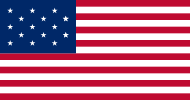 The US flag is modified to have fifteen stars and fifteen stripes, reflecting the addition of two new states: Vermont and Kentucky. This is the only US flag to have other than thirteen stripes.
The US flag is modified to have fifteen stars and fifteen stripes, reflecting the addition of two new states: Vermont and Kentucky. This is the only US flag to have other than thirteen stripes.
(no entry for this year)
1796
George Washington declines a third term as President, gives his Farewell Address.
Henry Cavendish determines the mass of Earth by measuring the gravity between two small masses and two large masses. This gives the gravitational constant G, which was the only unknown in Newton's equations. Solving for G enables Cavendish to establish that Earth is about 5.5 times as dense as water.
 Enquiry concerning the source of heat which is excited by friction by Count Rumford (Benjamin Thompson) describes his experiments with boring cannons that show that the caloric theory of heat cannot be true, and that heat should be considered a kind of motion.
Enquiry concerning the source of heat which is excited by friction by Count Rumford (Benjamin Thompson) describes his experiments with boring cannons that show that the caloric theory of heat cannot be true, and that heat should be considered a kind of motion.
1798
Napoleon invades Egypt and defeats the Egyptians at the Battle of the Pyramids.
(no entry for this year)
1799
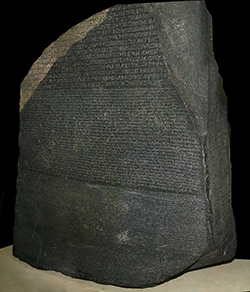 The Rosetta Stone is discovered in Egypt. The stone is a fragment of an Egyptian stele with the same inscription in three texts: ancient Egyptian hieroglyphs, Egyptian demotic script, and Greek. This side-by-side translation allows historians to translate ancient Egyptian hieroglyphs for the first time.
The Rosetta Stone is discovered in Egypt. The stone is a fragment of an Egyptian stele with the same inscription in three texts: ancient Egyptian hieroglyphs, Egyptian demotic script, and Greek. This side-by-side translation allows historians to translate ancient Egyptian hieroglyphs for the first time.
 Napoleon Bonaparte becomes First Consul and seizes power in France.
Napoleon Bonaparte becomes First Consul and seizes power in France.
 Alessandro Volta announces his invention, made in 1799, of the electric battery, also known as the Voltaic pile. It consists of a stack of alternating zinc and silver discs separated by felt soaked in brine. It is the first source of a steady electric current.
Alessandro Volta announces his invention, made in 1799, of the electric battery, also known as the Voltaic pile. It consists of a stack of alternating zinc and silver discs separated by felt soaked in brine. It is the first source of a steady electric current.
 William Herschel's "An investigation of the powers of prismatic colors to heat and illuminate objects" tells of his discovery of infrared radiation. While investigating the power of different parts of the spectrum to heat a thermometer, he finds that invisible light beyond the red produces the most heat.
William Herschel's "An investigation of the powers of prismatic colors to heat and illuminate objects" tells of his discovery of infrared radiation. While investigating the power of different parts of the spectrum to heat a thermometer, he finds that invisible light beyond the red produces the most heat.
1800
(no entry for this year)
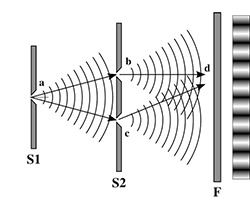 The English scientist Thomas Young demonstrates, in his famous double-slit experiment, the interference of light and concludes that light is a wave, not a particle as Sir Isaac Newton had ruled.
The English scientist Thomas Young demonstrates, in his famous double-slit experiment, the interference of light and concludes that light is a wave, not a particle as Sir Isaac Newton had ruled.
1801
 Thomas Jefferson becomes the third president of the United States.
Thomas Jefferson becomes the third president of the United States.
Ireland and Great Britain, England and Scotland, form United Kingdom.
 Thomas Young's On the theory of light and colors is the first of three pivotal papers describing his wave theory of light.
Thomas Young's On the theory of light and colors is the first of three pivotal papers describing his wave theory of light.
1802
The Ohio Constitution outlaws slavery. It also prohibits free blacks from voting.
(no entry for this year)
1803
U.S. President Thomas Jefferson appoints Meriwether Lewis and William Clark to explore the uncharted West. Among the marvels Lewis and Clark are expected to find are erupting volcanoes, mountains of salt, unicorns, living mastodons and seven-foot-tall beavers. They will find none of these, but will find fossils.
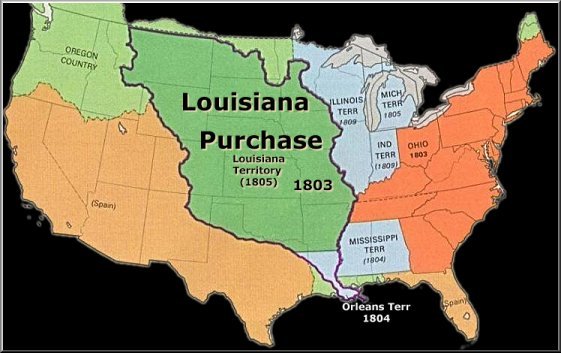 US buys large tract of land from France — The Louisiana Purchase.
US buys large tract of land from France — The Louisiana Purchase.
John Leslie's An experimental inquiry into the nature and propagation of heat establishes that the transmission of heat through radiation has the same properties as the propagation of light.
1804

 Meriwether Lewis and William Clark begin their exploration of the Louisiana territory.
Meriwether Lewis and William Clark begin their exploration of the Louisiana territory.
 Pierre-Simon Laplace measures molecular forces in liquids and announces his theory of capillary forces.
Pierre-Simon Laplace measures molecular forces in liquids and announces his theory of capillary forces.
The English chemist John Dalton develops his atomic theory, proposing that each chemical element is composed of atoms of a single unique type, and that, though they are both immutable and indestructible, they can combine to form more complex structures.
1805
 Britain's Lord Nelson defeats the Franco-Spanish fleet at the Battle of Trafalgar. Lord Nelson is killed, but his victory ends Napoleons power at sea and makes a French invasion of Britain impossible.
Britain's Lord Nelson defeats the Franco-Spanish fleet at the Battle of Trafalgar. Lord Nelson is killed, but his victory ends Napoleons power at sea and makes a French invasion of Britain impossible.
(no entry for this year)
1806
(no entry for this year)
 Thomas Young introduces the concept of, and is the first to use the word, ENERGY.
Thomas Young introduces the concept of, and is the first to use the word, ENERGY.
1807
The Slave Trade Act 1807 or the Abolition of the Slave Trade Act 1807, was an Act of the Parliament of the United Kingdom passed on 25 March 1807, with the title of "An Act for the Abolition of the Slave Trade". The original act is in the Parliamentary Archives. The act abolished the slave trade in the British Empire, in particular the Atlantic slave trade, and also encouraged British action to press other European states to abolish their slave trades, but it did not abolish slavery itself.
 Étienne-Louis Malus discovers that reflected light is polarized and introduces the term POLARIZATION.
Étienne-Louis Malus discovers that reflected light is polarized and introduces the term POLARIZATION.
1808
United States Bans Slave Trade Importing African slaves is outlawed, but smuggling continues.
The US prohibits the importation of new slaves from Africa (but the holding of existing slaves and their descendents remains legal).
(no entry for this year)
1809
 12 Feb 1809
12 Feb 1809
Abraham Lincoln is born
 James Madison becomes the fourth president of the United States.
James Madison becomes the fourth president of the United States.
(no entry for this year)
1810
(no entry for this year)
(no entry for this year)
1811
"Luddites" destroy industrial machines in North England, in protest over too rapid modernization.
 William Hyde Wollaston invents the camera lucida, a device for projecting an image onto a flat surface, such as drawing paper, on which the object can then be traced.
William Hyde Wollaston invents the camera lucida, a device for projecting an image onto a flat surface, such as drawing paper, on which the object can then be traced.
1812
Between 1812 and 1815, the United States and Great Britain fight the War of 1812.
Napoleon invades Russia; he captures Moscow, but unable to spend the winter there when the city catches fire, he marches his army back to France, experiencing tremendous losses along the way.
US declares war on Britain — War of 1812 begins.
(no entry for this year)
1813
(no entry for this year)
(no entry for this year)
1814
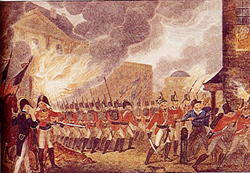 The British army burns down the White House in Washington DC.
The British army burns down the White House in Washington DC.
The defeat of the Creeks by Andrew Jackson begins the forced departure of Indian peoples from the South.
(no entry for this year)
1815
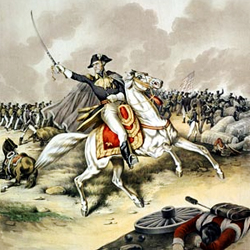 Three thousand troops of the United States Army, led by General Andrew Jackson, defeat the British at the Battle of New Orleans. Six hundred of the US troops are African-American.
Three thousand troops of the United States Army, led by General Andrew Jackson, defeat the British at the Battle of New Orleans. Six hundred of the US troops are African-American.

 An Allied army, led by Britain's Duke of Wellington, defeats Napoleon at the Battle of Waterloo.
An Allied army, led by Britain's Duke of Wellington, defeats Napoleon at the Battle of Waterloo.
 Augustin Fresnel demonstrates with his mirror experiment the wave nature of light. He also gives an explanation of polarization.
Augustin Fresnel demonstrates with his mirror experiment the wave nature of light. He also gives an explanation of polarization.
1816
Shaka becomes ruler of the Zulu Kingdom; his disciplined and mobile army conquers many peoples of southeastern Africa.

 Thomas Young and Augustin Fresnel demonstrated that light waves must be transverse vibrations.
Thomas Young and Augustin Fresnel demonstrated that light waves must be transverse vibrations.
1817
(no entry for this year)
1818
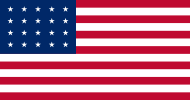 The US flag is modified to have twenty stars, reflecting the addition of five new states: Indiana, Louisiana, Mississippi, Ohio, and Tennessee. The number of stripes is returned to thirteen (both to symbolize the original thirteen states and to avoid having the number of stripes get so large that the flag would seem pink). From this point on, the US flag will have the same overall design, with changes in the number of stars used to denote the addition of new states.
The US flag is modified to have twenty stars, reflecting the addition of five new states: Indiana, Louisiana, Mississippi, Ohio, and Tennessee. The number of stripes is returned to thirteen (both to symbolize the original thirteen states and to avoid having the number of stripes get so large that the flag would seem pink). From this point on, the US flag will have the same overall design, with changes in the number of stars used to denote the addition of new states.
(no entry for this year)
1819
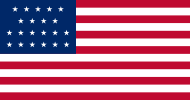 The US flag is modified to have twenty-one stars, reflecting the addition of one new state: Illinois.
The US flag is modified to have twenty-one stars, reflecting the addition of one new state: Illinois.
The Canadian government refuses to cooperate with the American government in the apprehension of fugitive slaves living in Canada. Consequently Canada becomes the destination for 40,000 fugitive slaves from United States between 1819 in 1861.
 The SS Savannah was an American hybrid sailing ship/side-wheel steamer built in 1818. She becomes the first steamship to cross the Atlantic Ocean, a feat accomplished during May–June, 1819. The Savannah was converted back into a sailing ship after returning from Europe. She was wrecked of Long Island in 1821.
The SS Savannah was an American hybrid sailing ship/side-wheel steamer built in 1818. She becomes the first steamship to cross the Atlantic Ocean, a feat accomplished during May–June, 1819. The Savannah was converted back into a sailing ship after returning from Europe. She was wrecked of Long Island in 1821.
The United States purchases Florida from Spain.
 André-Marie Ampère formulates one of the basic laws of electromagnetism, the right-hand rule for the influence of an electric current on the magnet and demonstrates that two wires that are carrying an electric current will attract or repel each other, depending on whether the occurrence are in opposite where the same directions.
André-Marie Ampère formulates one of the basic laws of electromagnetism, the right-hand rule for the influence of an electric current on the magnet and demonstrates that two wires that are carrying an electric current will attract or repel each other, depending on whether the occurrence are in opposite where the same directions.
 Dominique-François Arago discovers the magnetic effect of electricity passing through a copper wire, demonstrating that iron is not necessary for magnetism.
Dominique-François Arago discovers the magnetic effect of electricity passing through a copper wire, demonstrating that iron is not necessary for magnetism.
 Augustin-Jean Fresnel invents the so-called Fresnel lens, a lens used in lighthouses.
Augustin-Jean Fresnel invents the so-called Fresnel lens, a lens used in lighthouses.
 The science of electrodynamics is born with the announcement of Hans Christian Ørsted's discovery of electromagnetism.
The science of electrodynamics is born with the announcement of Hans Christian Ørsted's discovery of electromagnetism.
1820
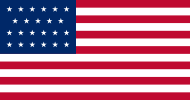 The US flag is modified to have twenty-three stars, reflecting the addition of two new states: Alabama and Maine.
The US flag is modified to have twenty-three stars, reflecting the addition of two new states: Alabama and Maine.
Debate over slavery in the US heats up; The Missouri Compromise admits Maine into the Union as a free state, with Missouri to enter the next year as a slave state. Slavery is banned north of the 36 30' line of latitude in the Louisiana Territory.
Missouri Compromise Missouri is admitted to the Union as a slave state, Maine as a free state. Slavery is forbidden in any subsequent territories north of latitude .
The first Christian missionaries arrived in the Hawaiian Islands.
(no entry for this year)
1821
(no entry for this year)
(no entry for this year)
1822
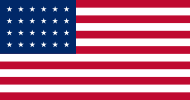 The US flag is modified to have twenty-four stars, reflecting the addition of one new state: Missouri.
The US flag is modified to have twenty-four stars, reflecting the addition of one new state: Missouri.
Slave Revolt: South Carolina Freed slave Denmark Vesey attempts a rebellion in Charleston. Thirty-five participants in the ill-fated uprising are hanged.
(no entry for this year)
1823
Slavery is abolished in Chile.
 Réflexions sur la puissance motrice du feu (On the motive power of fire) by Nicolas Léonard Sadi Carnot shows that work is done as heat passes from a high temperature to a low temperature; defines work; hints at the second law of thermodynamics; and suggests internal combustion engines.
Réflexions sur la puissance motrice du feu (On the motive power of fire) by Nicolas Léonard Sadi Carnot shows that work is done as heat passes from a high temperature to a low temperature; defines work; hints at the second law of thermodynamics; and suggests internal combustion engines.
1824
Mexico outlaws slavery. This decision creates the incentive for Anglo Texans to fight for independence in 1835-1836.
Mexico becomes a republic, three years after declaring independence from Spain.
(no entry for this year)
1826
(no entry for this year)
 Theory of systems of rays by William Rowan Hamilton is a unification of the study of optics through the principle of "varying action". It contains his correct prediction of conical refraction. When his prediction is verified, he becomes a well-known and is knighted.
Theory of systems of rays by William Rowan Hamilton is a unification of the study of optics through the principle of "varying action". It contains his correct prediction of conical refraction. When his prediction is verified, he becomes a well-known and is knighted.
1827
(no entry for this year)
(no entry for this year)
1828
(no entry for this year)
 Gustave-Gaspard Coriolis coins the term KINETIC ENERGY in On the calculation of mechanical action.
Gustave-Gaspard Coriolis coins the term KINETIC ENERGY in On the calculation of mechanical action.
 Joseph Henry shows that passing an electric current through a wire wrapped into coils produces a greater magnetic field than is produced when that same current is passed through a straight wire, and that an insulated wire wrapped around an iron core can produce a powerful electromagnet.
Joseph Henry shows that passing an electric current through a wire wrapped into coils produces a greater magnetic field than is produced when that same current is passed through a straight wire, and that an insulated wire wrapped around an iron core can produce a powerful electromagnet.
1829
 Andrew Jackson becomes the seventh president of the United States.
Andrew Jackson becomes the seventh president of the United States.
Slavery abolished in Mexico.
(no entry for this year)
1830
 On April 6, the Church of Jesus Christ of Latter-Day Saints is founded by Joseph Smith Jr. (1805-1844), in Fayette, New York. In Palmyra, New York, The Book of Mormon is published for the first time; Smith has translated it, he says, from golden tablets he found buried near Palmyra.
On April 6, the Church of Jesus Christ of Latter-Day Saints is founded by Joseph Smith Jr. (1805-1844), in Fayette, New York. In Palmyra, New York, The Book of Mormon is published for the first time; Smith has translated it, he says, from golden tablets he found buried near Palmyra.
The first wagon trains to cross the Rocky Mountains arrived in California.
The U.S. Congress passes the Indian Removal Act.
The world's population tops 1,000,000,000 (it had been roughly 750 million only 50 years earlier).
Independently, Michael Faraday and Joseph Henry discover that electricity can be induced by changes in a magnetic field (electromagnetic induction), a discovery leading to the first electric generators.
1831
Nat Turner leads a slave rebellion in Southampton, Virginia, killing at least 57 whites. Hundreds of black slaves are killed in retaliation.
Alabama makes it illegal for enslaved or free blacks to preach.
 In Boston, William Lloyd Garrison founds the abolitionist newspaper, The Liberator, signaling a dramatic shift in the antislavery movement. In the previous decades, it had centered in the South and favored a combination of compensated emancipation and colonization of freed slaves back to Africa. In the 1830s, the abolitionist movement becomes the dominant voice among antislavery advocates. Abolitionists demand the immediate end to slavery, which they consider to be a moral evil, without compensation to slaveowners.
In Boston, William Lloyd Garrison founds the abolitionist newspaper, The Liberator, signaling a dramatic shift in the antislavery movement. In the previous decades, it had centered in the South and favored a combination of compensated emancipation and colonization of freed slaves back to Africa. In the 1830s, the abolitionist movement becomes the dominant voice among antislavery advocates. Abolitionists demand the immediate end to slavery, which they consider to be a moral evil, without compensation to slaveowners.
Nat Turner, a literate slave who believes he is chosen to be the Moses of his people, instigates a slave revolt in Virginia. He and his followers kill 57 whites, but the revolt is unsuccessful and up to 200 slaves are killed. After an intense debate, the Virginia legislature narrowly rejects a bill to emancipate Virginia's slaves. The widespread fear of slave revolts, compounded by the rise of abolitionism, leads legislatures across the South to increase the harshness of their slave codes. Also, expressions of anti-slavery sentiment are suppressed throughout the South through state and private censorship.
North Carolina enacts a statute that bans teaching enslaved people to read and write.
Slave Revolt: Virginia Slave preacher Nat Turner leads a two-day uprising against whites, killing about 60. Militiamen crush the revolt then spend two months searching for Turner, who is eventually caught and hanged. Enraged Southerners impose harsher restrictions on their slaves.
(no entry for this year)
1832
Oberlin College is founded in Ohio. It admits African-Americans. By 1860, one third of its students are black.
 Electric telegraph invented by Samuel Morse.
Electric telegraph invented by Samuel Morse.

 In correspondence, Michael Faraday and William Whewell introduce the terms ELECTRODE, ANODE, ION, CATHODE, ANION, CATION, ELECTROLYTE, and ELECTROLYSIS.
In correspondence, Michael Faraday and William Whewell introduce the terms ELECTRODE, ANODE, ION, CATHODE, ANION, CATION, ELECTROLYTE, and ELECTROLYSIS.
1833
The American Anti-Slavery Society is established in Philadelphia.
The British Parliament abolishes slavery in the entire British Empire.
 Mathematician Carl Friedrich Gauss (1777-1855) shows that the origin of the Earth's magnetic field must lie deep inside the Earth. He makes use of the measurements of the magnetic field made by the physicist Paul Erman in 1828.
Mathematician Carl Friedrich Gauss (1777-1855) shows that the origin of the Earth's magnetic field must lie deep inside the Earth. He makes use of the measurements of the magnetic field made by the physicist Paul Erman in 1828.
1834
South Carolina bans the teaching of blacks, and slave or free, in its borders.
Federal troops are ordered to put down a riot by workers along the Chesapeake and Ohio Canal. It is the first time federal troops have been used to settle a labor battle in the United States.
 Gustave-Gaspard Coriolis's Mémoire sur les equations du mouvement relatif des sytèms de corps (Memoir on the equations of relative movement of systems of bodies) describes the Coriolis effect: the deflection of a moving body caused by Earth's rotation. The Coriolis effect is important in the study of wind. However, the claim that the Coriolis effect determines the direction water rotates when going down a drain is a myth.
Gustave-Gaspard Coriolis's Mémoire sur les equations du mouvement relatif des sytèms de corps (Memoir on the equations of relative movement of systems of bodies) describes the Coriolis effect: the deflection of a moving body caused by Earth's rotation. The Coriolis effect is important in the study of wind. However, the claim that the Coriolis effect determines the direction water rotates when going down a drain is a myth.
1835
Texas declares its independence from Mexico. In its constitution as an independent nation, Texas recognizes slavery and makes it difficult for free blacks to remain there.
Southern states expel abolitionists and forbid the mailing of antislavery propaganda.
 The first volume of La Dèmocracie en Amèrique (Democracy in America), by Alexis de Tocqueville (1805-1859), is published in France. Tocqueville, a historian and politician and member of the French aristocracy, writes about the American people and their institutions, based on his 9 months of travels through the United States and eastern Canada in 1831-1832.
The first volume of La Dèmocracie en Amèrique (Democracy in America), by Alexis de Tocqueville (1805-1859), is published in France. Tocqueville, a historian and politician and member of the French aristocracy, writes about the American people and their institutions, based on his 9 months of travels through the United States and eastern Canada in 1831-1832.
 John Frederic Danielle invents the Daniell cell, the first reliable source of electric current, based on the interactions of copper and zinc.
John Frederic Danielle invents the Daniell cell, the first reliable source of electric current, based on the interactions of copper and zinc.
1836
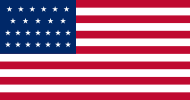 The US flag is modified to have twenty-five stars, reflecting the addition of one new state: Arkansas.
The US flag is modified to have twenty-five stars, reflecting the addition of one new state: Arkansas.
 Davy Crockett killed, as Texans are defeated by the Mexican army at the Alamo.
Davy Crockett killed, as Texans are defeated by the Mexican army at the Alamo.
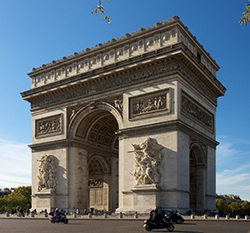 In Paris, the Arc de Triomphe is completed. The arch was ordered built by Napoleon in 1806.
In Paris, the Arc de Triomphe is completed. The arch was ordered built by Napoleon in 1806.
 Texas gains independence from Mexico after winning the battle of San Jacinto.
Texas gains independence from Mexico after winning the battle of San Jacinto.
(no entry for this year)
1837
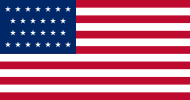 The US flag is modified to have twenty-six stars, reflecting the addition of one new state: Michigan.
The US flag is modified to have twenty-six stars, reflecting the addition of one new state: Michigan.
 Martin Van Buren becomes eighth president of the United States.
Martin Van Buren becomes eighth president of the United States.
 William IV, King of Great Britain, dies.
William IV, King of Great Britain, dies.
(no entry for this year)
1838
 Coronation of Victoria as queen of Great Britain.
Coronation of Victoria as queen of Great Britain.
The English scientist Michael Faraday concludes from his work on electromagnetism that, contrary to scientific opinion of the time, the divisions between the various kinds of electricity are illusory. He also establishes that magnetism can affect rays of light, and that there is an underlying relationship between the two phenomena.
1839
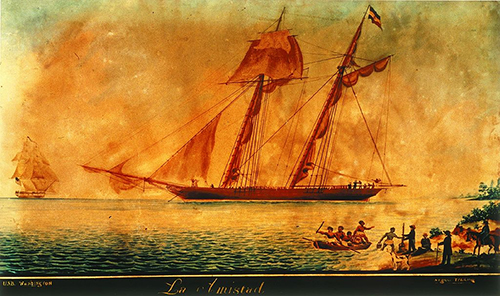 La Amistad was a 19th-century two-masted schooner, owned by a Spaniard living in Cuba. It became renowned in July 1839 for a slave revolt by Mende captives, who had been enslaved in Sierra Leone, and were being transported from Havana, Cuba to their purchasers' plantations. The African captives took control of the ship, killing some of the crew and ordering the survivors to sail the ship to Africa. The Spanish survivors secretly maneuvered the ship north, and La Amistad was captured off the coast of Long Island by the brig USS Washington. The Mende and La Amistad were interned in Connecticut while federal court proceedings were undertaken for their disposition. The owners of the ship and Spanish government claimed the slaves as property; but the US had banned the African trade and argued that the Mende were legally free. Because of issues of ownership and jurisdiction, the case gained international attention. Former president John Quincy Adams argued on behalf of the slaves when the appeal was brought before the U.S. Supreme Court, which eventually determined the Africans to be free men. The case became a symbol in the United States in the movement to abolish slavery.
La Amistad was a 19th-century two-masted schooner, owned by a Spaniard living in Cuba. It became renowned in July 1839 for a slave revolt by Mende captives, who had been enslaved in Sierra Leone, and were being transported from Havana, Cuba to their purchasers' plantations. The African captives took control of the ship, killing some of the crew and ordering the survivors to sail the ship to Africa. The Spanish survivors secretly maneuvered the ship north, and La Amistad was captured off the coast of Long Island by the brig USS Washington. The Mende and La Amistad were interned in Connecticut while federal court proceedings were undertaken for their disposition. The owners of the ship and Spanish government claimed the slaves as property; but the US had banned the African trade and argued that the Mende were legally free. Because of issues of ownership and jurisdiction, the case gained international attention. Former president John Quincy Adams argued on behalf of the slaves when the appeal was brought before the U.S. Supreme Court, which eventually determined the Africans to be free men. The case became a symbol in the United States in the movement to abolish slavery.
Sultan Abdulmecid I implemented the Tanzimat reforms in an attempt to modernize the Ottoman Empire and strengthen it against European powers. The reforms included changes to the legal system, education, and the military, and were influenced by western ideas.

 In response to the British opium trade, Lin Zexu wrote a letter to Queen Victoria, urging her to end the opium trade: We find that your country is sixty or seventy thousand li from China. Yet there are barbarian ships that strive to come here for trade for the purpose of making a great profit. The wealth of China is used to profit the barbarians. That is to say, the great profit made by barbarians is all taken from the rightful share of China. By what right do they then in return use the poisonous drug to injure the Chinese people? Even though the barbarians may not necessarily intend to do us harm, yet in coveting profit to an extreme, they have no regard for injuring others. Let us ask, where is your conscience? The letter to the Queen never reached her. Belatedly, it was delivered and published in The Times of London.
In response to the British opium trade, Lin Zexu wrote a letter to Queen Victoria, urging her to end the opium trade: We find that your country is sixty or seventy thousand li from China. Yet there are barbarian ships that strive to come here for trade for the purpose of making a great profit. The wealth of China is used to profit the barbarians. That is to say, the great profit made by barbarians is all taken from the rightful share of China. By what right do they then in return use the poisonous drug to injure the Chinese people? Even though the barbarians may not necessarily intend to do us harm, yet in coveting profit to an extreme, they have no regard for injuring others. Let us ask, where is your conscience? The letter to the Queen never reached her. Belatedly, it was delivered and published in The Times of London.
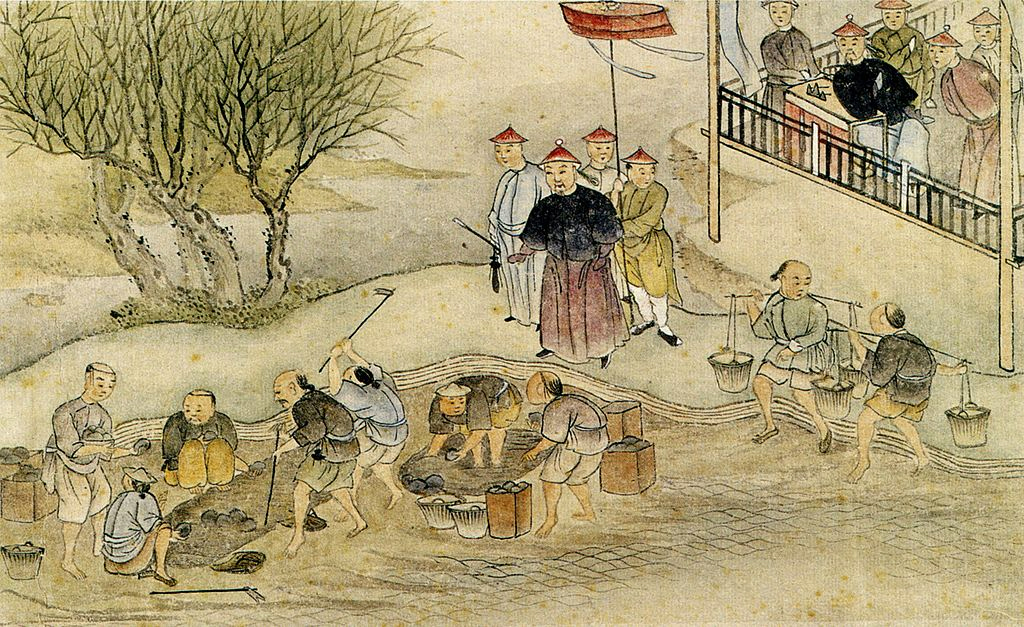 Lin Zexu was a Chinese scholar-official of the Qing dynasty best known for his role in the First Opium War of 1839. In March 1839, Lin arrived in Guangdong Province to take measures that would eliminate the opium trade. He was a formidable bureaucrat known for his competence and high moral standards, with an imperial commission from the Daoguang Emperor to halt the illegal importation of opium by the British. Upon arrival, he made changes within a matter of months. He arrested more than 1,700 Chinese opium dealers and confiscated over 70,000 opium pipes. He initially attempted to get foreign companies to forfeit their opium stores in exchange for tea, but this ultimately failed. Lin resorted to using force in the western merchants' enclave. A month and a half later, the merchants gave up nearly 1.2 million kg (2.6 million pounds) of opium. Beginning 3 June 1839, 500 workers laboured for 23 days to destroy it, mixing the opium with lime and salt and throwing it into the sea outside of Humen Town. Lin composed an elegy apologising to the gods of the sea for polluting their realm.
Lin Zexu was a Chinese scholar-official of the Qing dynasty best known for his role in the First Opium War of 1839. In March 1839, Lin arrived in Guangdong Province to take measures that would eliminate the opium trade. He was a formidable bureaucrat known for his competence and high moral standards, with an imperial commission from the Daoguang Emperor to halt the illegal importation of opium by the British. Upon arrival, he made changes within a matter of months. He arrested more than 1,700 Chinese opium dealers and confiscated over 70,000 opium pipes. He initially attempted to get foreign companies to forfeit their opium stores in exchange for tea, but this ultimately failed. Lin resorted to using force in the western merchants' enclave. A month and a half later, the merchants gave up nearly 1.2 million kg (2.6 million pounds) of opium. Beginning 3 June 1839, 500 workers laboured for 23 days to destroy it, mixing the opium with lime and salt and throwing it into the sea outside of Humen Town. Lin composed an elegy apologising to the gods of the sea for polluting their realm.
The First Opium War between Britain and China occurs between 1839 and 1842, triggered when Chinese officials attempt to prevent the sale of narcotics (opium) to the Chinese people by the British East India trading Company. The British respond by bringing in gunboats and shelling Chinese coastal cities.
 The process of vulcanization, developed by Charles Goodyear, makes possible the commercial use of rubber.
The process of vulcanization, developed by Charles Goodyear, makes possible the commercial use of rubber.
 Alexandre-Edmond Becquerel shows that light can initiate chemical reactions that produce an electric current.
Alexandre-Edmond Becquerel shows that light can initiate chemical reactions that produce an electric current.
1840
(no entry for this year)
(no entry for this year)
1841
The U.S.S. Creole, a ship carrying slaves from Virginia to Louisiana, is seized by the slaves on board and taken to Nassau, where they are free.
 John Tyler becomes tenth president of the United States.
John Tyler becomes tenth president of the United States.
 The first centralized government bureau of statistics is founded in Belgium by the mathematician Lambert Adolphe Jacques Quetelet (1781-1840).
The first centralized government bureau of statistics is founded in Belgium by the mathematician Lambert Adolphe Jacques Quetelet (1781-1840).
 German physician and physicist Julius Robert Mayer is the first to state the law of conservation of energy, noting specifically that heat and mechanical energy are two aspects of the same thing.
German physician and physicist Julius Robert Mayer is the first to state the law of conservation of energy, noting specifically that heat and mechanical energy are two aspects of the same thing.
 On the uniform motion of heat in homogeneous solid bodies, by William Thomson, aka Lord Kelvin (1824-1907), is published. Thomson's concern with the physics of cooling bodies will draw him into debates concerning the age of the Earth. In 1846 he calculates that the Earth can be no more than 100 million years old.
On the uniform motion of heat in homogeneous solid bodies, by William Thomson, aka Lord Kelvin (1824-1907), is published. Thomson's concern with the physics of cooling bodies will draw him into debates concerning the age of the Earth. In 1846 he calculates that the Earth can be no more than 100 million years old.
 The change in the observed frequency of waves emitted from a source, moving relative to the observer, is described by Christian Johann Doppler (1803-1853). This phenomenon is now known as the Doppler Effect.
The change in the observed frequency of waves emitted from a source, moving relative to the observer, is described by Christian Johann Doppler (1803-1853). This phenomenon is now known as the Doppler Effect.
1842
 Frederick Douglass leads a successful campaign against Rhode Island's proposed Dorr Constitution, which would have continued the prohibition on black male voting rights.
Frederick Douglass leads a successful campaign against Rhode Island's proposed Dorr Constitution, which would have continued the prohibition on black male voting rights.
In Prigg v. Pennsylvania, the U.S. Supreme Court upholds the Fugitive Slave Law of 1793, stating that slaveowners have a right to retrievetheir "property." In so doing, the court rules that Pennsylvania's anti-kidnapping law is unconstitutional. At the same time, the Supreme Court declares that enforcement of the Fugitive Slave Lawis a federal responsibility in which states are not compelled to participate. Between 1842 and 1850, nine Northern states pass new personal liberty laws which forbid state officials from cooperating in the return of alleged fugitive slaves and bar the use of state facilities for that purpose.
Slavery is abolished in Uruguay.
The Virginia Legislature votes against abolishing slavery.
In Commonwealth v. Hunt, a case involving the Boston Journeyman Bootmakers Society, the Chief Justice of the Massachusetts Supreme Court ruled that trade unions are legal. The ruling revises the common law that treated such unions as criminal conspiracies.
The Massachusetts State Legislature enacts a child labor law that limits the working hours of children under 12 years-old to 10 hours per day.
P. T. Barnum lures crowds of thousands to see his "Feejee Mermaid."
 James Prescott Joule determines the mechanical equivalent of heat by measuring the rise in temperature produced in water by stirring it.
James Prescott Joule determines the mechanical equivalent of heat by measuring the rise in temperature produced in water by stirring it.
1843
 Congress grants S. F. B. Morse $30,000 to build the first telegraph line (Washington to Baltimore).
Congress grants S. F. B. Morse $30,000 to build the first telegraph line (Washington to Baltimore).
(no entry for this year)
1844
(no entry for this year)
 Michael Faraday relates magnetism to light after finding the magnetic field effects the polarization of light in crystals. He proposes that light may be waves of electromagnetism. He also describes the phenomena of diamagnetism and paramagnetism, which he explains in terms of his concept of a magnetic field.
Michael Faraday relates magnetism to light after finding the magnetic field effects the polarization of light in crystals. He proposes that light may be waves of electromagnetism. He also describes the phenomena of diamagnetism and paramagnetism, which he explains in terms of his concept of a magnetic field.
1845
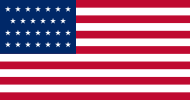 The US flag is modified to have twenty-seven stars, reflecting the addition of one new state: Florida.
The US flag is modified to have twenty-seven stars, reflecting the addition of one new state: Florida.
 Frederick Douglass publishes his autobiography, The Life and Times of Frederick Douglass.
Frederick Douglass publishes his autobiography, The Life and Times of Frederick Douglass.
 James K. Polk becomes eleventh president of the United States.
James K. Polk becomes eleventh president of the United States.
Texas is annexed by the United States.
The Irish potato famine begins, one of the century's worst natural disasters. One million citizens starve to death, and one million others emigrate, mostly to the United States
 James Prescott Joule discovers that the length of an iron bar changes slightly when the bar is magnetized.
James Prescott Joule discovers that the length of an iron bar changes slightly when the bar is magnetized.
1846
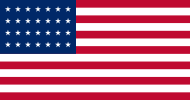 The US flag is modified to have twenty-eight stars, reflecting the addition of one new state: Texas.
The US flag is modified to have twenty-eight stars, reflecting the addition of one new state: Texas.
Mexican-American War Defeated, Mexico yields an enormous amount of territory to the United States. Americans then wrestle with a controversial topic: Is slavery permitted in the new lands?
The first professional baseball game is played, in Hoboken, New Jersey.
The Mexican War (1846-48) between the United States and Mexico results in the United States taking possession of California and much of the Southwest, which had been Mexican territory.
The Oregon Treaty delineates border between the United States and Canada.
 Über die Erhaltung der Kraft ("On the Conservation of Force"), by Hermann Ludwig von Helmholtz (1821-1894), is published. It articulates what later becomes known as the Conservation of Energy.
Über die Erhaltung der Kraft ("On the Conservation of Force"), by Hermann Ludwig von Helmholtz (1821-1894), is published. It articulates what later becomes known as the Conservation of Energy.
1847
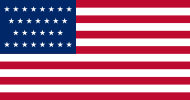 The US flag is modified to have twenty-nine stars, reflecting the addition of one new state: Iowa.
The US flag is modified to have twenty-nine stars, reflecting the addition of one new state: Iowa.
 The North Star, an abolitionist newspaper, begins publication in Rochester, New York. The paper is founded by escaped slave Frederick Douglass (1817-1895), with money he earned as a result of his autobiography.
The North Star, an abolitionist newspaper, begins publication in Rochester, New York. The paper is founded by escaped slave Frederick Douglass (1817-1895), with money he earned as a result of his autobiography.
Liberia is formed as a home for released American slaves.
Missouri bans the education of free blacks.
The Istanbul slave market is abolished.
The Factory Act is passed in Britain. It forbids women and children between the ages of 13 and 18 to work more than 10 hours per day.
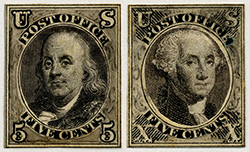 The first United States postage stamps are issued
The first United States postage stamps are issued
 An absolute scale of temperatures is proposed by William Thomson (1824-1907). Thomson will become Baron Kelvin of Largs, in 1892, and the scale will come to bear his name.
An absolute scale of temperatures is proposed by William Thomson (1824-1907). Thomson will become Baron Kelvin of Largs, in 1892, and the scale will come to bear his name.
 Armand Hippolyte Louis Fizeau suggests that light from a source of moving away from the observer will be shifted toward the red end of the spectrum, a phenomenon known as redshift. This is closely related to, but not exactly the same as, the Doppler effect.
Armand Hippolyte Louis Fizeau suggests that light from a source of moving away from the observer will be shifted toward the red end of the spectrum, a phenomenon known as redshift. This is closely related to, but not exactly the same as, the Doppler effect.
1848
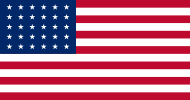 The US flag is modified to have thirty stars, reflecting the addition of one new state: Wisconsin.
The US flag is modified to have thirty stars, reflecting the addition of one new state: Wisconsin.
Slavery is abolished in old French and Danish colonies.
 Karl Marx publishes The Communist Manifesto, which asserts that revolution by the working classes will ultimately destroy capitalism.
Karl Marx publishes The Communist Manifesto, which asserts that revolution by the working classes will ultimately destroy capitalism.
Revolution breaks out across much of Europe; the Second Republic is proclaimed in France.
 Armand Hippolyte Louis Fizeau measures the velocity of light in error by measuring the time it takes for a beam of light to pass between the teeth of a rotating gear. The light is reflected by a mirror and stopped by the next tooth of the gear. The result, 315,000 km/se4c (196,000 miles/sec), is within 5% of today's accepted value.
Armand Hippolyte Louis Fizeau measures the velocity of light in error by measuring the time it takes for a beam of light to pass between the teeth of a rotating gear. The light is reflected by a mirror and stopped by the next tooth of the gear. The result, 315,000 km/se4c (196,000 miles/sec), is within 5% of today's accepted value.
 In describing Sadi Carnot's theory of heat, published in 1824, William Thomson (1824-1907) uses the term THERMODYNAMICS.
In describing Sadi Carnot's theory of heat, published in 1824, William Thomson (1824-1907) uses the term THERMODYNAMICS.
 The speed of light is measured by physicist Armand Hippolyte Louis Fizeau (1819-1896) to be approximately 186,000 miles per second.
The speed of light is measured by physicist Armand Hippolyte Louis Fizeau (1819-1896) to be approximately 186,000 miles per second.
1849
 Charles Lewis Reason becomes the first African-American college instructor when he is hired at predominantly white Free Mission College (later New York Central College) to teach Greek, Latin, French, and mathematics.
Charles Lewis Reason becomes the first African-American college instructor when he is hired at predominantly white Free Mission College (later New York Central College) to teach Greek, Latin, French, and mathematics.
 Harriet Tubman escapes from slavery and goes on to lead more than 300 slaves to freedom on the underground railroad.
Harriet Tubman escapes from slavery and goes on to lead more than 300 slaves to freedom on the underground railroad.
 Zachary Taylor becomes twelfth president of the United States.
Zachary Taylor becomes twelfth president of the United States.
The California gold rush begins as more than 100,000 people swarm to California to make their fortunes after gold is found there in 1848.
Showmen Moses Kimball and P. T. Barnum purchase the contents of the Peale Museum (established in 1784).
 In Über die bewegende Kraft der Wärme, mathematical physicist Rudolf Julius Emanuel Clausius articulates what comes to be known as the Second Law of Thermodynamics. The law states that heat can only be transferred from a warmer body to a colder body. In 1865, he'll restate the Law, saying that in the closed system entropy always increases.
In Über die bewegende Kraft der Wärme, mathematical physicist Rudolf Julius Emanuel Clausius articulates what comes to be known as the Second Law of Thermodynamics. The law states that heat can only be transferred from a warmer body to a colder body. In 1865, he'll restate the Law, saying that in the closed system entropy always increases.
1850
The Compromise of 1850 is introduced into Congress by Henry Clay as an omnibus bill designed to settle disputes arising from the conclusion of the Mexican War. It passes after Stephen Douglas divides the bill into several parts: California enters the Union as a free state; the slave trade (but not slavery) is abolished in Washington D.C.; the fugitive slave law is strengthened; and the Utah and New Mexico Territories are opened to slavery on the basis of popular sovereignty (allowing territorial voters to decide the issue without federa linterference).
 Léon Foucault demonstrates that the Earth rotates using a pendulum, suspended from the ceiling of a church.
Léon Foucault demonstrates that the Earth rotates using a pendulum, suspended from the ceiling of a church.
 Physicist William Thomson proposes a concept of "absolute zero", at which the energy of molecules is zero. He draws on Charles' Law to show that such a condition would hold at -273 degrees Celsius.
Physicist William Thomson proposes a concept of "absolute zero", at which the energy of molecules is zero. He draws on Charles' Law to show that such a condition would hold at -273 degrees Celsius.
1851
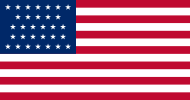 The US flag is modified to have thirty-one stars, reflecting the addition of one new state: California.
The US flag is modified to have thirty-one stars, reflecting the addition of one new state: California.

 James Prescott Joule and William Thompson, later Lord Kelvin, establish that an expanding gas becomes cooler. This is now known as the Joule-Thompson effect.
James Prescott Joule and William Thompson, later Lord Kelvin, establish that an expanding gas becomes cooler. This is now known as the Joule-Thompson effect.
1852
 The French Republic falls; Louis Napoleon (Napoleon III) is crowned Emperor.
The French Republic falls; Louis Napoleon (Napoleon III) is crowned Emperor.
The U.S. state of Massachusetts adopts a compulsory school-attendance law, the first effective example of such a law in the nation.
 Léon Foucault demonstrates that the velocity of light is lesson water than in air, tending to confirm the wave theory of light.
Léon Foucault demonstrates that the velocity of light is lesson water than in air, tending to confirm the wave theory of light.
 William John Macquorn Rankine introduces the concept of potential energy, or energy of position.
William John Macquorn Rankine introduces the concept of potential energy, or energy of position.
1853
 Commodore Matthew Perry sails into Japan's Edo Bay with his black ships (four modern, steam-powered warships), urging Japan to open trade policies with the United States.
Commodore Matthew Perry sails into Japan's Edo Bay with his black ships (four modern, steam-powered warships), urging Japan to open trade policies with the United States.
 Franklin Pierce becomes fourteenth president of the United States.
Franklin Pierce becomes fourteenth president of the United States.
(no entry for this year)
1854
Kansas-Nebraska Act: In an attempt to spur population growth in the western territories in advance of a transcontinental railroad, Stephen Douglas introduces a bill to establish the territories of Kansas and Nebraska. In order to gain Southern support, the bill stipulates that slavery in the territories will be decided by popular sovereignty. Thus the Kansas-Nebraska Act repeals the Missouri Compromise ban on slavery north of 36 30' in the lands of the Louisiana Purchase.
Ostend Manifesto: The U.S. ministers to Britain, France, and Spain meet in Ostend, Belgium. They draft a policy recommendation to President Pierce, urging him to attempt again to purchase Cuba from Spain and, if Spain refuses, to take the island by force. When the secret proposal, called the Ostend Manifesto, is leaked to the press, it creates an uproar since Cuba would likely become another slave state.
 On May 24, Virginia fugitive slave Anthony Burns is captured in Boston and returned to slavery under the provisions of the Fugitive Slave Act. Fifty thousand Boston residents watch his transport through the streets of the city in shackles. A Boston church raises $1500 to purchase his freedom and Burns returns to the city in 1855, a free man.
On May 24, Virginia fugitive slave Anthony Burns is captured in Boston and returned to slavery under the provisions of the Fugitive Slave Act. Fifty thousand Boston residents watch his transport through the streets of the city in shackles. A Boston church raises $1500 to purchase his freedom and Burns returns to the city in 1855, a free man.
On May 30, the Kansas-Nebraska act is passed by Congress. The act repeals the Missouri Compromise and permits the admission of Kansas and Nebraska territories to the Union after their white male voters decide the fate of slavery in those territories.
Slavery is abolished in Peru and Venezuela.
The Republican Party is formed in the summer in opposition to the extension of slavery into the western territories.
(no entry for this year)
1855
The Massachusetts Legislature outlaws racially segregated schools.
(no entry for this year)
1856
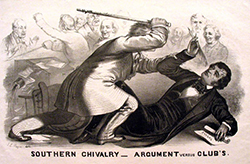 The Caning of Charles Sumner: Senator Charles Sumner delivers a stinging speech in the U.S. Senate, "The Crime against Kansas," in which he attacks slavery, the South, and singles out his Senate colleague, Andrew Butler of South Carolina, for criticism. In retaliation, Butler's nephew, Congressman Preston Brooks of South Carolina, attacks Sumner with a cane while the Massachusetts senator is seated at his desk on the floor of the Senate. The injuries he sustains cause Sumner to be absent from the Senate for four years. The episode revealed the polarization in America, as Sumner became a martyr in the North and Brooks a hero in the South. Northerners were outraged. Southerners sent Brooks hundreds of new canes in endorsement of his assault. One was inscribed "Hit him again." Brooks claimed that he had not intended to kill Sumner, or else he would have used a different weapon. In a speech to the House defending his actions, Brooks stated that he "meant no disrespect to the Senate of the United States" or the House by his attack on Sumner. He was tried in a District of Columbia court, convicted for assault, and fined $300 ($8,000 in today's dollars), but received no prison sentence.
The Caning of Charles Sumner: Senator Charles Sumner delivers a stinging speech in the U.S. Senate, "The Crime against Kansas," in which he attacks slavery, the South, and singles out his Senate colleague, Andrew Butler of South Carolina, for criticism. In retaliation, Butler's nephew, Congressman Preston Brooks of South Carolina, attacks Sumner with a cane while the Massachusetts senator is seated at his desk on the floor of the Senate. The injuries he sustains cause Sumner to be absent from the Senate for four years. The episode revealed the polarization in America, as Sumner became a martyr in the North and Brooks a hero in the South. Northerners were outraged. Southerners sent Brooks hundreds of new canes in endorsement of his assault. One was inscribed "Hit him again." Brooks claimed that he had not intended to kill Sumner, or else he would have used a different weapon. In a speech to the House defending his actions, Brooks stated that he "meant no disrespect to the Senate of the United States" or the House by his attack on Sumner. He was tried in a District of Columbia court, convicted for assault, and fined $300 ($8,000 in today's dollars), but received no prison sentence.
In South Africa, Boers establish the South African Republic (Transvaal), with Pretoria as its capital. Marthinus Wessels Pretorius, 37, is named the first president.
The Second Opium War (1856-1860) between Britain and China leads to further erosion of Chinese sovereignty.
 Über die Art der Bewegung, welche wir Wäe nennen (On the type of motion turned heat) by Rudolf Clausius is establishes his kinetic theory of heat of the mathematical basis. It also explains how evaporation occurs.
Über die Art der Bewegung, welche wir Wäe nennen (On the type of motion turned heat) by Rudolf Clausius is establishes his kinetic theory of heat of the mathematical basis. It also explains how evaporation occurs.
1857
 Farmer Hinton Rowan Helper publishes The Impending Crisis of the South, and How to Meet It, in which he argues that slavery in economically unwise, and particularly devastating to small farmers who do not own slaves. He writes that slavery is "the root of all the shame, poverty, ignorance, tyranny and imbecility" in the South. He also argues that slavery foolishly ties up economic resources in human beings when it might be spent on labor-saving improvements.
Farmer Hinton Rowan Helper publishes The Impending Crisis of the South, and How to Meet It, in which he argues that slavery in economically unwise, and particularly devastating to small farmers who do not own slaves. He writes that slavery is "the root of all the shame, poverty, ignorance, tyranny and imbecility" in the South. He also argues that slavery foolishly ties up economic resources in human beings when it might be spent on labor-saving improvements.
The African slave trade is prohibited in the Ottoman Empire
 The Dred Scott Decision makes the Missouri Compromise unconstitutional and increases tension between North and South over slavery in the United States. Writing for the majority, Chief Justice Roger B. Taney asserted that blacks were "beings of an inferior order, and altogether unfit to associate with the white race, either in social or political relations, and so far inferior that they had no rights which the white man was bound to respect." This embarrassing decision represents a low point in the history of the United States Supreme Court.
The Dred Scott Decision makes the Missouri Compromise unconstitutional and increases tension between North and South over slavery in the United States. Writing for the majority, Chief Justice Roger B. Taney asserted that blacks were "beings of an inferior order, and altogether unfit to associate with the white race, either in social or political relations, and so far inferior that they had no rights which the white man was bound to respect." This embarrassing decision represents a low point in the history of the United States Supreme Court.
 James Buchanan becomes fifteenth president of the United States.
James Buchanan becomes fifteenth president of the United States.
 Giuseppe Garibaldi, who returned to Italy in 1854 after several years working at Staten Island, New York, founds the Italian National Association. The organization is designed to promote the unification of Italy.
Giuseppe Garibaldi, who returned to Italy in 1854 after several years working at Staten Island, New York, founds the Italian National Association. The organization is designed to promote the unification of Italy.
 Julius Plücker shows that cathode rays bend under the influence of a magnet, suggesting they are connected in some way with charge. This is an early step along the path that will lead in 1897 to the discovery that cathode rays are composed of electrons.
Julius Plücker shows that cathode rays bend under the influence of a magnet, suggesting they are connected in some way with charge. This is an early step along the path that will lead in 1897 to the discovery that cathode rays are composed of electrons.
1858
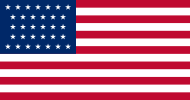 The US flag is modified to have thirty-two stars, reflecting the addition of one new state: Minnesota.
The US flag is modified to have thirty-two stars, reflecting the addition of one new state: Minnesota.
 Abraham Lincoln, running for the United States Senate, declares "A house divided against itself cannot stand." He loses the race to Stephen Douglas, but his performance in there now-legendary debates leads to his nomination as the Republican candidate for president in 1860.
Abraham Lincoln, running for the United States Senate, declares "A house divided against itself cannot stand." He loses the race to Stephen Douglas, but his performance in there now-legendary debates leads to his nomination as the Republican candidate for president in 1860.
In Ireland, the group Sein Féin is founded.
 Gustav Kirchoff recognizes that sodium is found on the sun and discovers his black-body radiation law.
Gustav Kirchoff recognizes that sodium is found on the sun and discovers his black-body radiation law.

 Physicist Gustav Robert Kirchhoff and chemist R. W. Bunsen explain that when light passes through a gas, or heated material, only certain wavelengths of the light are absorbed. Therefore, an analysis of the spectrum of the light can reveal the chemical makeup of the gas or material.
Physicist Gustav Robert Kirchhoff and chemist R. W. Bunsen explain that when light passes through a gas, or heated material, only certain wavelengths of the light are absorbed. Therefore, an analysis of the spectrum of the light can reveal the chemical makeup of the gas or material.
1859
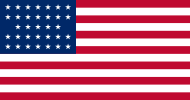 The US flag is modified to have thirty-three stars, reflecting the addition of one new state: Oregon.
The US flag is modified to have thirty-three stars, reflecting the addition of one new state: Oregon.
Harriet Wilson of Milford, New Hampshire, publishes Our Nig; or Sketches from the Life of a Free Black, the first novel by an African-American woman.
 On October 16, John Brown leads 20 men, including five African-Americans, in an unsuccessful attempt to seize the Federal Armory at Harper's ferry, Virginia, with the goal of inspiring a slave insurrection. He was captured by US troops under the command of Colonel Robert E. Lee, tried, and hanged on December 2.
On October 16, John Brown leads 20 men, including five African-Americans, in an unsuccessful attempt to seize the Federal Armory at Harper's ferry, Virginia, with the goal of inspiring a slave insurrection. He was captured by US troops under the command of Colonel Robert E. Lee, tried, and hanged on December 2.
(no entry for this year)
1860
On December 20, South Carolina secedes from the union, setting in motion the forces leading to the US Civil war.
Southern Secession South Carolina secedes in December. More states follow the next year.
The Pony Express begins cross-country mail delivery.
(no entry for this year)
1861
 Abraham Lincoln becomes sixteenth president of the United States.
Abraham Lincoln becomes sixteenth president of the United States.
Fort Sumter shelled, American Civil War begins.
The First Battle of Bull Run, also known as the First Battle of Manassas (the name used by Confederate forces and still often used in the Southern United States), is fought on July 21, 1861, near Manassas, Virginia. It is the first major land battle of the American Civil War. Neither Confederate nor Union troops were ready for battle. Union troops advanced on Confederate troops, almost breaking through, but at the last moment, Confederate reinforcements arrived on the battlefield and carried the day. Union troops were routed. Union civilian spectators, who had come to watch the expected Confederate defeat as entertainment, were forced to run for their lives.
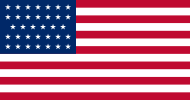 The US flag is modified to have thirty-four stars, reflecting the addition of one new state: Kansas.
The US flag is modified to have thirty-four stars, reflecting the addition of one new state: Kansas.
United States Civil War Four years of brutal conflict claim 623,000 lives.
Congress passes the First Confiscation Act, which prevents Confederate slave owners from re-enslaving runaways.
(no entry for this year)
1862
On April 16, Congress abolishes slavery in the District of Columbia.
 Otto von Bismarck is appointed Prime Minister of Prussia.
Otto von Bismarck is appointed Prime Minister of Prussia.
 The Battle of Fort Donelson (11-16 Feb) is an early Union victory in the American Civil War, which opened the Cumberland River as an avenue for the invasion of the South. The success elevated Brig. Gen. Ulysses S. Grant from an obscure and largely unproven leader to the rank of major general.
The Battle of Fort Donelson (11-16 Feb) is an early Union victory in the American Civil War, which opened the Cumberland River as an avenue for the invasion of the South. The success elevated Brig. Gen. Ulysses S. Grant from an obscure and largely unproven leader to the rank of major general.
The Battle of Shiloh (6-7 Apr). Although the Confederates swept the field on the first day, Union troops under U. S. Grant retook the field on the second day. Combined Union and Confederate casualties (23,746 killed, wounded, or missing) represented more than the total American battle-related casualties of the American Revolutionary War, the War of 1812, and the Mexican-American War combined.
(no entry for this year)
1863
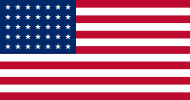 The US flag is modified to have thirty-five stars, reflecting the addition of one new state: West Virginia. This new state was created when Union sympathizers in the western portion of Virginia seceded from Virginia (then in secession from the US) and rejoined the Union.
The US flag is modified to have thirty-five stars, reflecting the addition of one new state: West Virginia. This new state was created when Union sympathizers in the western portion of Virginia seceded from Virginia (then in secession from the US) and rejoined the Union.
Abraham Lincoln's Emancipation Proclamation takes effect on January 1, legally freeing slaves in areas of the South still in rebellion against the United States.
 The Battle of Gettysburg (1-3 Jul) was the battle with the largest number of casualties in the American Civil War. Union Maj. Gen. George Gordon Meade's Army of the Potomac defeated attacks by Confederate Gen. Robert E. Lee's Army of Northern Virginia, ending Lee's invasion of the North.
The Battle of Gettysburg (1-3 Jul) was the battle with the largest number of casualties in the American Civil War. Union Maj. Gen. George Gordon Meade's Army of the Potomac defeated attacks by Confederate Gen. Robert E. Lee's Army of Northern Virginia, ending Lee's invasion of the North.

 The Siege of Vicksburg was the final major military action in the Vicksburg Campaign of the American Civil War. Union Maj. Gen. Ulysses S. Grant crossed the Mississippi River and drove the Confederate army of Lt. Gen. John C. Pemberton into the fortress city of Vicksburg, Mississippi, and placed the city under siege. After more than forty days, with no re-enforcement and supplies nearly gone, the garrison surrendered on July 4. This surrender, combined with Lee's defeat at Gettysburg the previous day, represents the turning point of the war. From then on, military victory for the Confederacy was impossible.
The Siege of Vicksburg was the final major military action in the Vicksburg Campaign of the American Civil War. Union Maj. Gen. Ulysses S. Grant crossed the Mississippi River and drove the Confederate army of Lt. Gen. John C. Pemberton into the fortress city of Vicksburg, Mississippi, and placed the city under siege. After more than forty days, with no re-enforcement and supplies nearly gone, the garrison surrendered on July 4. This surrender, combined with Lee's defeat at Gettysburg the previous day, represents the turning point of the war. From then on, military victory for the Confederacy was impossible.
 James Clerk Maxwell's A dynamical theory of the electromagnetic field is the first of his publications to use Michael Faraday's concept of a field as the basis of the mathematical treatment of electricity and magnetism. It introduces Maxwell's equations to describe electromagnetism.
James Clerk Maxwell's A dynamical theory of the electromagnetic field is the first of his publications to use Michael Faraday's concept of a field as the basis of the mathematical treatment of electricity and magnetism. It introduces Maxwell's equations to describe electromagnetism.
1864
 After the Confederate defeat at Chattanooga, President Lincoln promoted Grant to a special regular army rank, Lieutenant General, authorized by Congress on March 2, 1864. This rank had previously been awarded two other times, a full rank to George Washington and a Brevet rank to Winfield Scott. Lincoln then places Grant in charges of all Union forces.
After the Confederate defeat at Chattanooga, President Lincoln promoted Grant to a special regular army rank, Lieutenant General, authorized by Congress on March 2, 1864. This rank had previously been awarded two other times, a full rank to George Washington and a Brevet rank to Winfield Scott. Lincoln then places Grant in charges of all Union forces.


 Sherman captures Atlanta, marches to Savannah. Through a series of bloody battles, Grant forces Lee back to Petersburg, Virginia, and then lays siege to the city. Lincoln is reelected, destroying the South's hope for a political settlement to the war.
Sherman captures Atlanta, marches to Savannah. Through a series of bloody battles, Grant forces Lee back to Petersburg, Virginia, and then lays siege to the city. Lincoln is reelected, destroying the South's hope for a political settlement to the war.
 Rudolf Clausius invents the term ENTROPY to describe the degradation of energy in the closed system.
Rudolf Clausius invents the term ENTROPY to describe the degradation of energy in the closed system.
1865
On February 1, Abraham Lincoln signs the 13th Amendment to the United States Constitution outlawing slavery throughout the United States.
The Thirteenth Amendment to the United States Constitution officially abolished slavery and involuntary servitude, except as punishment for a crime. It was passed by the Senate on April 8, 1864, passed by the House on January 21, 1865, and adopted on December 6, 1865.
Lee surrenders, US Civil war ends, Lincoln assassinated.
 Andrew Johnson becomes seventeenth president of the United States.
Andrew Johnson becomes seventeenth president of the United States.
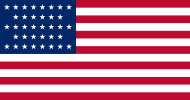 The US flag is modified to have thirty-six stars, reflecting the addition of one new state: Nevada.
The US flag is modified to have thirty-six stars, reflecting the addition of one new state: Nevada.
 The Ku Klux Klan is formed on December 24 in Polanski, Tennessee, by six Confederate veterans. Nathan Bedford Forrest, a former Confederate cavalry general and slave trader, serves as the Klan's first grand wizard or leader-in-chief.
The Ku Klux Klan is formed on December 24 in Polanski, Tennessee, by six Confederate veterans. Nathan Bedford Forrest, a former Confederate cavalry general and slave trader, serves as the Klan's first grand wizard or leader-in-chief.
(no entry for this year)
1866
On June 13, Congress approves the Fourteenth Amendment to the Constitution, guaranteeing due process and equal protection under the law to all citizens. The amendment also grants citizenship to African-Americans.
(no entry for this year)
1867
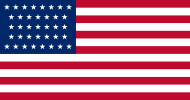 The US flag is modified to have thirty-seven stars, reflecting the addition of one new state: Nebraska.
The US flag is modified to have thirty-seven stars, reflecting the addition of one new state: Nebraska.
The Alaska Purchase resulted in the transfer of Alaska to the United States from the Russian Empire for a total price of $ 7,000,000. The purchase, made at the initiative of United States Secretary of State William H. Seward, gained 586,412 square miles of new United States territory.
(no entry for this year)
1868
The Meiji Restoration in Japan (led by samurai from the western clans of Satsuma, Choshu, Tosa, and Hizen) overthrows the feudal shogunate system and initiates Japan's participation in the modern world.
The Impeachment of Andrew Johnson, 17th President of the United States, was one of the most dramatic events in the political life of the United States during Reconstruction, and the first impeachment in history of a sitting United States president.
(no entry for this year)
1869
On February 26, Congress sends the Fifteenth Amendment to the Constitution to the states for approval. The amendment guarantees African-American males the right to vote.
Transcontinental Rail Service Begun in the United States On May 10th, at Promontory Point, Utah, a golden rail spike was struck, completing the first transcontinental railroad line.
 Ulysses S. Grant becomes eighteenth president of the United States.
Ulysses S. Grant becomes eighteenth president of the United States.
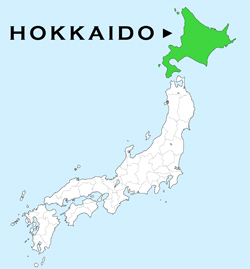 Japan colonizes Hokkaido as part of its new nation state.
Japan colonizes Hokkaido as part of its new nation state.
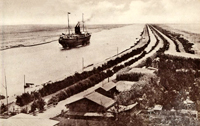 The Suez Canal opened to traffic on 17 November. The canal linked the Mediterranean and the Red Sea. It was 103 miles long and it brought Oriental ports 5,000 miles closer to Europe. Work had begun on the canal in 1859, financed primarily by French investors. The canal increased the strategic importance of Egypt to European powers.
The Suez Canal opened to traffic on 17 November. The canal linked the Mediterranean and the Red Sea. It was 103 miles long and it brought Oriental ports 5,000 miles closer to Europe. Work had begun on the canal in 1859, financed primarily by French investors. The canal increased the strategic importance of Egypt to European powers.
(no entry for this year)
1870
 Standard Oil Formed On January 10th, 1870, John D Rockefeller and four partners incorporate the Standard Oil Company. The company gains control of nearly 95% of the oil refining industry in the United States.
Standard Oil Formed On January 10th, 1870, John D Rockefeller and four partners incorporate the Standard Oil Company. The company gains control of nearly 95% of the oil refining industry in the United States.
The First Vatican Council of the Roman Catholic Church proclaims the dogma of the infallibility of the Pope.
The Franco-Prussian war (1870-71) leads to the formation of the German Empire.
 George Johnstone Stoney notes that the wavelengths of three lines in the hydrogen spectrum are found to have simple ratios, and anticipation of Balmer's formula, an important step towards understanding the structure of the atom.
George Johnstone Stoney notes that the wavelengths of three lines in the hydrogen spectrum are found to have simple ratios, and anticipation of Balmer's formula, an important step towards understanding the structure of the atom.
 James Clerk Maxwell explains how his statistical theory of heat works by inventing MAXWELL'S DEMON, a mythical creature that can see and handle individual molecules. By opening a gate between two vessels containing a gas only one of fast molecules passing into one, the demon would make heat flow from cold to hot.
James Clerk Maxwell explains how his statistical theory of heat works by inventing MAXWELL'S DEMON, a mythical creature that can see and handle individual molecules. By opening a gate between two vessels containing a gas only one of fast molecules passing into one, the demon would make heat flow from cold to hot.
1871
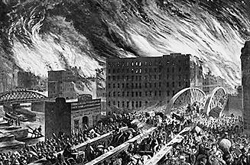 On October 8th, a fire broke out in the west side of Chicago. The Great Chicago Fire lasted two days, killing 300 people, and destroying most of Chicago. Property damages were estimated at 200 million dollars.
On October 8th, a fire broke out in the west side of Chicago. The Great Chicago Fire lasted two days, killing 300 people, and destroying most of Chicago. Property damages were estimated at 200 million dollars.
On October 8th, a fire broke out in the village of Peshtigo, Wisconsin. The Peshtigo Fire caused more deaths than any other fire in the history of the United States. By the time it was over, 1,875 square miles (1.2 million acres) of forest had been consumed, an area approximately twice the size of the state of Rhode Island. Some sources list as much as 1.5 million acres burned. Twelve communities were destroyed. An accurate death toll has never been determined since local population records were destroyed in the fire. Between 1,200 and 2,500 people are thought to have lost their lives.
The occurrence of this fire, and several other smaller fires, on the same day as the Great Chicago fire has lead some to speculate that all of the fires may have had a common cause: multiple impacts from fragments of a disintegrating comet.

 Henry Morton Stanley finds David Livingstone in Africa, greeting the Scotsman with the famous words, "Dr. Livingstone, I presume."
Henry Morton Stanley finds David Livingstone in Africa, greeting the Scotsman with the famous words, "Dr. Livingstone, I presume."
The Second Reich proclaimed With the German victory in France complete, the German Reichstag(parliament) proclaimed the creation of the Second Reich. The Reichstag approved with minor modification the constitution of the Northern German Federation. William I became King of Germany with Otto Bismarck the first chancellor.
(no entry for this year)
1872
(no entry for this year)
 James Clerk Maxwell's Electricity and Magnetism contains the basic laws of electromagnetism and predicts, in great detail, such phenomena as radio waves and pressure caused by light rays.
James Clerk Maxwell's Electricity and Magnetism contains the basic laws of electromagnetism and predicts, in great detail, such phenomena as radio waves and pressure caused by light rays.
1873
Slavery is abolished in Puerto Rico.
Spain decrees the end of slavery in Cuba, still a Spanish colony.
 Irish physicist George J. Stoney estimates the charge of the then unknown electron to be about 10-20 coulomb, close to the modern value of 1.6021892 x 10-19. He also introduces the term ELECTRON.
Irish physicist George J. Stoney estimates the charge of the then unknown electron to be about 10-20 coulomb, close to the modern value of 1.6021892 x 10-19. He also introduces the term ELECTRON.
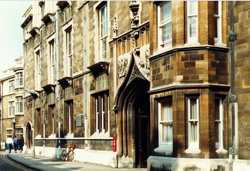 The Cavendish laboratory at Cambridge is completed. Although widely believed to have been named after the 18th-century physicist Henry Cavendish, it is, in fact, named after the entire Cavendish family, because the 19th century steel-making descendent of Henry, William Cavendish, financed the laboratory. The structure of DNA was worked out at the Cavendish many years later by Watson and Crick.
The Cavendish laboratory at Cambridge is completed. Although widely believed to have been named after the 18th-century physicist Henry Cavendish, it is, in fact, named after the entire Cavendish family, because the 19th century steel-making descendent of Henry, William Cavendish, financed the laboratory. The structure of DNA was worked out at the Cavendish many years later by Watson and Crick.
1874
(no entry for this year)
(no entry for this year)
1875
(no entry for this year)
 Eugen Goldstein shows that the radiation in a vacuum tube produced when an electric current is forced through the tube starts at the cathode. Goldstein introduces the term CATHODE RAY to describe the light emitted.
Eugen Goldstein shows that the radiation in a vacuum tube produced when an electric current is forced through the tube starts at the cathode. Goldstein introduces the term CATHODE RAY to describe the light emitted.
1876
 Custer Killed at Little Bighorn On June 25th, in Dakota territory, at the Little Big Horn, General George Armstrong Custer (who graduated from West Point in 1861, last in his class) and all 256 troops were killed. The defeat of Custer in the Battle of the Little Big Horn was the last Indian victory.
Custer Killed at Little Bighorn On June 25th, in Dakota territory, at the Little Big Horn, General George Armstrong Custer (who graduated from West Point in 1861, last in his class) and all 256 troops were killed. The defeat of Custer in the Battle of the Little Big Horn was the last Indian victory.
 Alexander Graham Bell patents the telephone.
Alexander Graham Bell patents the telephone.
(no entry for this year)
1877
The Compromise of 1877 ends Reconstruction and gives the Presidency to Rutherford B. Hayes. Although Democratic presidential candidate Samuel Tilden won the popular vote, Southern Democratic leaders agreed to support Rutherford Hayes' efforts to obtain the disputed electoral votes of Florida, Louisiana, and South Carolina in exchange for the withdrawal of the last federal troops from the South and the end of federal efforts to protect the civil rights of African Americans.
 Rutherford B. Hayes becomes nineteenth president of the United States.
Rutherford B. Hayes becomes nineteenth president of the United States.
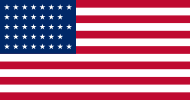 The US flag is modified to have thirty-eight stars, reflecting the addition of one new state: Colorado.
The US flag is modified to have thirty-eight stars, reflecting the addition of one new state: Colorado.
Frederick Douglass becomes US Marshal for the District of Columbia.
(no entry for this year)
1878

 Thomas Edison and Joseph Wilson Swan produce first successful incandescent electric light.
Thomas Edison and Joseph Wilson Swan produce first successful incandescent electric light.
(no entry for this year)
1879
 F. W. Woolworth opens his first "five and dime store".
F. W. Woolworth opens his first "five and dime store".
 Pierre Curie discovers the piezoelectric effect: certain substances produce an electric current when they are physically distorted, and conversely they are physically distorted when an electric current is applied to them. This effect has many applications, including, in the 21st century, the construction of high-end tweeters in stereo systems.
Pierre Curie discovers the piezoelectric effect: certain substances produce an electric current when they are physically distorted, and conversely they are physically distorted when an electric current is applied to them. This effect has many applications, including, in the 21st century, the construction of high-end tweeters in stereo systems.
1880
(no entry for this year)
 Hermann Ludwig von Helmholtz shows that the electrical charges in atoms are divided into definite integral portions, suggesting the idea that there is a smallest unit of electricity.
Hermann Ludwig von Helmholtz shows that the electrical charges in atoms are divided into definite integral portions, suggesting the idea that there is a smallest unit of electricity.
1881
 James A Garfield becomes twentieth president of the United States.
James A Garfield becomes twentieth president of the United States.
Six months after taking office, Garfield becomes the second US President to be assassinated, when he was shot by Charles J. Guiteau — a disgruntled and impoverished would-be office holder. When he purchased the pistol used in the assassination, he chose to buy one with an ivory handle because he thought it would look good as a museum exhibit after the assassination.
In January, the Tennessee State Legislature votes to segregate railroad passenger cars.
 On the Fourth of July, Booker T. Washington opens Tuskegee Institute in central Alabama.
On the Fourth of July, Booker T. Washington opens Tuskegee Institute in central Alabama.
 Chester A. Arthur becomes twenty-first president of the United States.
Chester A. Arthur becomes twenty-first president of the United States.
 Clara Barton founds the American Red Cross.
Clara Barton founds the American Red Cross.
 John William Strutt, Lord Rayleigh, discovers that the ratio of the atomic mass of oxygen to that of hydrogen is not 16 exactly, as had been assumed, but 15.882.
John William Strutt, Lord Rayleigh, discovers that the ratio of the atomic mass of oxygen to that of hydrogen is not 16 exactly, as had been assumed, but 15.882.
1882
Britain Invades Egypt The British invaded Egypt in response to anti foreign riots. The British defeated the army of Arabi Pasha at Al Tell. On September 15th they captured Cairo. Arabi pasha the nationalist leader was deported to Ceylon.
(no entry for this year)
1883
On October 16, the United States Supreme Court declares invalid the Civil Rights Act of 1875, stating that the federal government cannot bar corporations or individuals from discriminating on the basis of race.
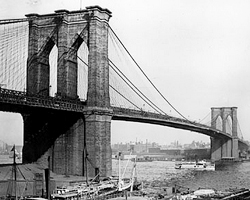 On May 25, the New York boroughs of Manhattan and Brooklyn were linked with the opening of the Brooklyn Bridge. The bridge was the first steel suspension bridge erected in the United States. It was built at a cost of $16 million and 26 lives. When it opened, the Brooklyn Bridge was the longest suspension bridge in the world.
On May 25, the New York boroughs of Manhattan and Brooklyn were linked with the opening of the Brooklyn Bridge. The bridge was the first steel suspension bridge erected in the United States. It was built at a cost of $16 million and 26 lives. When it opened, the Brooklyn Bridge was the longest suspension bridge in the world.
(no entry for this year)
1884
(no entry for this year)
Johann Jakob Balmer discovers the formula for the hydrogen spectrum that will later inspire Niels Bohr to develop his model of the atom.
1885
 William Crookes proposes that atomic weights measured by chemists are averages of the weights of different kinds of atoms of the same element (although it will not be until 1910 that Frederick Soddy identifies these different kinds of atoms as isotopes).
William Crookes proposes that atomic weights measured by chemists are averages of the weights of different kinds of atoms of the same element (although it will not be until 1910 that Frederick Soddy identifies these different kinds of atoms as isotopes).
1886
Slavery is abolished in Cuba.
Daimler produces his first car.

 Albert Michelson and Edward Morley measure the velocity of light in two directions, attempting to detect the proper motion of Earth through the ether (a hypothesized fluid that was assumed to fill all space, providing a medium for the transport of electromagnetic waves). The Michelson Morley experiment reveals no evidence of motion.
Albert Michelson and Edward Morley measure the velocity of light in two directions, attempting to detect the proper motion of Earth through the ether (a hypothesized fluid that was assumed to fill all space, providing a medium for the transport of electromagnetic waves). The Michelson Morley experiment reveals no evidence of motion.
 Ernst Mach notes that airflow becomes disturbed at the speed of sound.
Ernst Mach notes that airflow becomes disturbed at the speed of sound.
1887
African-American players are banned from major league baseball.
Slavery is abolished in Brazil
Interstate Commerce Act Passed On February 4, President Cleveland signed into law the first bill regulating the railroads. The act, which called for just and equal rates, also limited pooling (secret pacts between railroads). This measure received broad support in the Congress.
The United States acquires Pearl Harbor, Hawaii, as a coaling station and future naval base.
 Heinrich Rudolf Hertz produces and detects radio waves for the first time. Radio waves will be called Hertzian waves until renamed by Marconi, who calls them radiotelegraphy waves.
Heinrich Rudolf Hertz produces and detects radio waves for the first time. Radio waves will be called Hertzian waves until renamed by Marconi, who calls them radiotelegraphy waves.
1888
 George Eastman Patents Camera George Eastman patents the hand held camera.
George Eastman Patents Camera George Eastman patents the hand held camera.
Slavery is abolished in Brazil, bringing to an end of the legal sanction of slavery in the Americas.
 George Francis Fitzgerald formulates the principle that objects shrink slightly in the direction they are traveling, now known as the Fitzgerald-Lorenz contraction, since Hendrik Antoon Lorentz reaches the same conclusion a few years later.
George Francis Fitzgerald formulates the principle that objects shrink slightly in the direction they are traveling, now known as the Fitzgerald-Lorenz contraction, since Hendrik Antoon Lorentz reaches the same conclusion a few years later.
1889
Florida becomes the first state to use the poll tax to disenfranchise black voters.
 Frederick Douglass is appointed minister to Haiti.
Frederick Douglass is appointed minister to Haiti.
 Benjamin Harrison becomes twenty-third president of the United States.
Benjamin Harrison becomes twenty-third president of the United States.
Oklahoma Land Rush The last major unsettled territory in the United States (which had been exclusively Indian) is opened for settlement. Over 200,000 settlers gather at the borders of the territory awaiting the opportunity to seize land. On the first day the territory was opened, 12,000 settlers arrived in Guthrie, Oklahoma.
(no entry for this year)
1890
 About 60 common starlings are released into New York's Central Park by Eugene Schieffelin, as part of an effort to introduce every bird species mentioned in the works of William Shakespeare into North America. The original 60 birds have since swelled in number to 150 million, occupying an area extending from southern Canada and Alaska to Central America.
About 60 common starlings are released into New York's Central Park by Eugene Schieffelin, as part of an effort to introduce every bird species mentioned in the works of William Shakespeare into North America. The original 60 birds have since swelled in number to 150 million, occupying an area extending from southern Canada and Alaska to Central America.
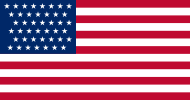 The US flag is modified to have forty-three stars, reflecting the addition of five new states: Idaho, Montana, North Dakota, South Dakota, and Washington.
The US flag is modified to have forty-three stars, reflecting the addition of five new states: Idaho, Montana, North Dakota, South Dakota, and Washington.
The United States Army massacres 200 Indians at Wounded Knee in South Dakota, ending the Indian wars of resistance.
(no entry for this year)
1891
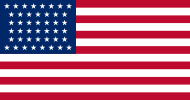 The US flag is modified to have forty-four stars, reflecting the addition of one new state: Wyoming.
The US flag is modified to have forty-four stars, reflecting the addition of one new state: Wyoming.
The first basketball game is played, in Springfield, Massachusetts.
(no entry for this year)
1892
A record 230 people are lynched in the United States this year; 161 are black and 69 white.
 Wilhelm Wien discovers that the maximum wavelength emitted by hot body varies inversely with its absolute temperature. Wien's law becomes useful in establishing the temperature of stars. The problems he has with deriving an equation to describe black-body radiation lead to Max Planck's introduction of the quantum in 1900.
Wilhelm Wien discovers that the maximum wavelength emitted by hot body varies inversely with its absolute temperature. Wien's law becomes useful in establishing the temperature of stars. The problems he has with deriving an equation to describe black-body radiation lead to Max Planck's introduction of the quantum in 1900.
1893
 Joseph John (J.J.) Thomson announces that he has found that the velocity of cathode rays is much lower than that of light.
Joseph John (J.J.) Thomson announces that he has found that the velocity of cathode rays is much lower than that of light.
1894
(no entry for this year)
 Charles Thomson Rees Wilson develops the CLOUD CHAMBER, a box containing a gas that is saturated. When a charged particle passes through the gas, small droplets are formed that make the track of the particle visible. The cloud chamber becomes a powerful tool in particle physics.
Charles Thomson Rees Wilson develops the CLOUD CHAMBER, a box containing a gas that is saturated. When a charged particle passes through the gas, small droplets are formed that make the track of the particle visible. The cloud chamber becomes a powerful tool in particle physics.
 Pierre Curie shows that as the temperature of the magnet is increased, there is a level at which the magnetism is disrupted and ceases to exist. This temperature is still called the Curie point.
Pierre Curie shows that as the temperature of the magnet is increased, there is a level at which the magnetism is disrupted and ceases to exist. This temperature is still called the Curie point.
 Wilhelm Konrad Röntgen (Roentgen) discovers X-rays, which will soon be applied in the visualization of bodily structures and in the induction of genetic mutations (both intentionally and accidentally).
Wilhelm Konrad Röntgen (Roentgen) discovers X-rays, which will soon be applied in the visualization of bodily structures and in the induction of genetic mutations (both intentionally and accidentally).
1895
The Lumiere Brothers introduce moving pictures.
The Sino-Japanese War ends and Japan gains dominance over Korea and Taiwan.
 Antoine-Henri Becquerel discovers rays produced by uranium — the first observation of natural radioactivity.
Antoine-Henri Becquerel discovers rays produced by uranium — the first observation of natural radioactivity.
1896
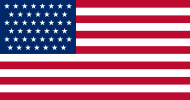 The US flag is modified to have forty-five stars, reflecting the addition of one new state: Utah.
The US flag is modified to have forty-five stars, reflecting the addition of one new state: Utah.
In Plessy vs. Ferguson, the United States Supreme Court declares legalized segregation in the United States to be constitutional.
 The will of Alfred Nobel establishes annual prizes for peace, science, and literature.
The will of Alfred Nobel establishes annual prizes for peace, science, and literature.
 Joseph John Thomson discovers the electron, the first known particle that is smaller than an atom, in part because he has better vacuum pumps that were previously available. He, and independently, Emil Wiechert, determine the ratio of mass to charge of the particles by deflecting them by electric and magnetic fields.
Joseph John Thomson discovers the electron, the first known particle that is smaller than an atom, in part because he has better vacuum pumps that were previously available. He, and independently, Emil Wiechert, determine the ratio of mass to charge of the particles by deflecting them by electric and magnetic fields.
Marie Curie begins research of "uranium rays" that will lead to the discovery of radioactivity.
1897
 William McKinley becomes twenty-fifth president of the United States. McKinley was the last veteran of the Civil war to serve as President. He enlisted as a private in the 23rd Ohio Infantry, and by the end of the war he had been promoted several times, finally leaving the service with the rank of Captain.
William McKinley becomes twenty-fifth president of the United States. McKinley was the last veteran of the Civil war to serve as President. He enlisted as a private in the 23rd Ohio Infantry, and by the end of the war he had been promoted several times, finally leaving the service with the rank of Captain.
 Zionist activity begins in the Middle East, under the World Zionist Congress called by Theodore Herzl.
Zionist activity begins in the Middle East, under the World Zionist Congress called by Theodore Herzl.

 Marie and Pierre Curie discovered that thorium, gives off "uranium rays", which Marie renames RADIOACTIVITY.
Marie and Pierre Curie discovered that thorium, gives off "uranium rays", which Marie renames RADIOACTIVITY.
1898
The United States Supreme Court, in Williams vs. Mississippi, rules that poll taxes and literacy tests do not violate the Constitution.
United States invades Cuba and defeats Spain in the Spanish-American War.
 British physicist Ernest Rutherford discovers the radioactivity from uranium has at least two different forms, which he calls alpha and beta rays.
British physicist Ernest Rutherford discovers the radioactivity from uranium has at least two different forms, which he calls alpha and beta rays.


 Fritz Geisel, Antoine-Henri Becquerel, and Marie Curie proved the beta rays consist of high-speed electrons.
Fritz Geisel, Antoine-Henri Becquerel, and Marie Curie proved the beta rays consist of high-speed electrons.
1899
The Boer war breaks out between Afrikaners and the British in southern Africa.
 Paul Karl Ludwig Drude shows that moving electrons conduct electricity in metals.
Paul Karl Ludwig Drude shows that moving electrons conduct electricity in metals.
 Paul Ulrich Villard is the first to observe a radiation that is more penetrating than X-rays, now called gamma rays.
Paul Ulrich Villard is the first to observe a radiation that is more penetrating than X-rays, now called gamma rays.
 On December 14, Max Planck announces the first step toward quantum theory. He states that substances can emit light only at certain energies, which implies that some physical processes are not continuous, but occur only in specified amounts called quanta.
On December 14, Max Planck announces the first step toward quantum theory. He states that substances can emit light only at certain energies, which implies that some physical processes are not continuous, but occur only in specified amounts called quanta.
1900
 Booker T. Washington publishes Up from Slavery, his autobiography.
Booker T. Washington publishes Up from Slavery, his autobiography.
(no entry for this year)
1901
 Theodore Roosevelt becomes twenty-sixth president of the United States.
Theodore Roosevelt becomes twenty-sixth president of the United States.
 Queen Victoria dies and is succeeded by her son, Edward VII.
Queen Victoria dies and is succeeded by her son, Edward VII.
(no entry for this year)
1902
(no entry for this year)
Physicist Ernest Rutherford lectures the British Association that radioactivity could power the sun and maintain its heat, meaning the sun and Earth could be much older than Lord Kelvin's estimate.
1903
 W. E. B. Du Bois' The Souls of Black Folk is published on April 27. Du Bois rejects the gradualism of Booker T. Washington and calls for agitation on behalf of African-American rights.
W. E. B. Du Bois' The Souls of Black Folk is published on April 27. Du Bois rejects the gradualism of Booker T. Washington and calls for agitation on behalf of African-American rights.
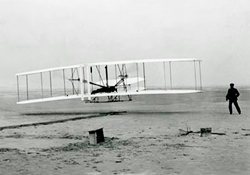 Orville and Wilbur Wright succeed with the first controlled flight in a heavier-than-air machine.
Orville and Wilbur Wright succeed with the first controlled flight in a heavier-than-air machine.
(no entry for this year)
1904
The Russo-Japanese war begins with a surprise attack by the Imperial Japanese Navy against the Russian far East Fleet, while it was at anchor at Port Arthur.
Albert Einstein proposes the special theory of relativity (E=mc2).
1905
 An obscure Swiss patent clerk, Albert Einstein, formulates the special theory of relativity and ushers in the atomic age.
An obscure Swiss patent clerk, Albert Einstein, formulates the special theory of relativity and ushers in the atomic age.
The National Forest Service is established in the United States by Gifford Pinchot.
(no entry for this year)
1906
 An All-India Muslim League is founded by Sultan Mahommed Shah, Aga Khan III.
An All-India Muslim League is founded by Sultan Mahommed Shah, Aga Khan III.
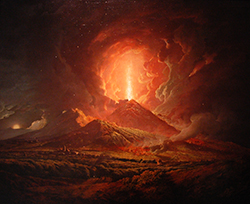 Mount Vesuvius erupts, devastating the town of Ottaiano, Italy
Mount Vesuvius erupts, devastating the town of Ottaiano, Italy
The Great San Francisco Earthquake kills seven hundred people and causes more than $400 million in property losses.
The world's largest battleship — the Satsuma — is launched in Japan.
(no entry for this year)
1907
 Alain Locke of Philadelphia, a Harvard graduate, becomes the first African-American Rhodes scholar to study at Oxford University in England.
Alain Locke of Philadelphia, a Harvard graduate, becomes the first African-American Rhodes scholar to study at Oxford University in England.
Robert Baden-Powell founds the Boy Scout movement, in Britain.
(no entry for this year)
1908
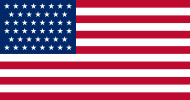 The US flag is modified to have forty-six stars, reflecting the addition of one new state: Oklahoma.
The US flag is modified to have forty-six stars, reflecting the addition of one new state: Oklahoma.
The Young Turk revolution restores the Constitution and parliamentary government in the Ottoman Empire.
(no entry for this year)
1909
The National Association for the Advancement of Colored People (NAACP) is formed on February 12 in New York City.
 William Howard Taft becomes twenty-seventh president of the United States.
William Howard Taft becomes twenty-seventh president of the United States.
Tel Aviv, the first Jewish town in modern Palestine, is founded.
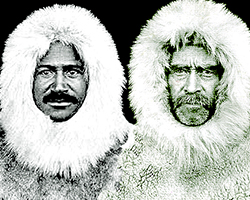 United States explorer Commander Robert E. Peary, accompanied by Matthew Henson, is the first person to reach North Pole.
United States explorer Commander Robert E. Peary, accompanied by Matthew Henson, is the first person to reach North Pole.
(no entry for this year)
1910
 On July 4, boxer Jack Johnson defeats Jim Jeffries in Reno, Nevada, to become the first African-American world heavyweight champion.
On July 4, boxer Jack Johnson defeats Jim Jeffries in Reno, Nevada, to become the first African-American world heavyweight champion.
(no entry for this year)
1911
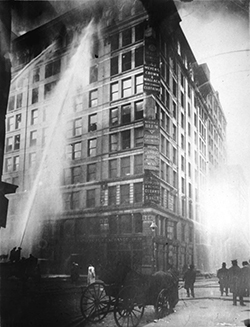 A fire inside the Triangle Shirtwaist Company factory in New York City's garment district kills 146 workers, mostly immigrant Jewish and Italian women in their teens and early 20s. Most women could not escape the burning building because the doors to the stairwells and exits were locked to keep the workers from stealing linen from the factory. It is the deadliest workplace incident in the city's history until 9/11.
A fire inside the Triangle Shirtwaist Company factory in New York City's garment district kills 146 workers, mostly immigrant Jewish and Italian women in their teens and early 20s. Most women could not escape the burning building because the doors to the stairwells and exits were locked to keep the workers from stealing linen from the factory. It is the deadliest workplace incident in the city's history until 9/11.
Winston Churchill is appointed First Lord of the Admiralty.
(no entry for this year)
1912
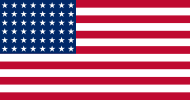 The US flag is modified to have forty-eight stars, reflecting the addition of two new states: Arizona and New Mexico.
The US flag is modified to have forty-eight stars, reflecting the addition of two new states: Arizona and New Mexico.
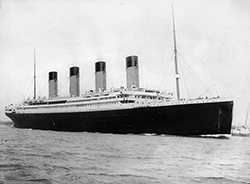 On April 10, the RMS Titanic — the largest, most advanced, and most luxurious passenger ship in the world — set off on her maiden voyage from Southampton, England to New York City. Four days later, this unsinkable marvel of modern engineering rammed an iceberg and sank in the North Atlantic, resulting in the deaths of 1,517 people.
On April 10, the RMS Titanic — the largest, most advanced, and most luxurious passenger ship in the world — set off on her maiden voyage from Southampton, England to New York City. Four days later, this unsinkable marvel of modern engineering rammed an iceberg and sank in the North Atlantic, resulting in the deaths of 1,517 people.

 The Republic of China is a nationally proclaimed with Sun Yat-sen as president. He appoints Chiang Kai-shek as his military advisor.
The Republic of China is a nationally proclaimed with Sun Yat-sen as president. He appoints Chiang Kai-shek as his military advisor.
(no entry for this year)
1913
 Woodrow Wilson becomes twenty-eighth president of the United States.
Woodrow Wilson becomes twenty-eighth president of the United States.
On April 11, President Woodrow Wilson initiates the racial segregation of workplaces, restaurants, and lunchrooms and all federal offices across the nation.
The federal income tax is introduced in the United States with the 16th amendment.
(no entry for this year)
1914
The Ottoman Empire entered World War I on the side of the Central Powers, fighting against the Allied Powers. The war proved costly for the empire, leading to economic hardship, military defeats, and ultimately, its dissolution.
World War I begins after Archduke Francis Ferdinand, heir to the Austrian throne, and his wife are assassinated in Sarajevo, Bosnia, on June 28 by a Serbian nationalist.
(no entry for this year)
1915
(no entry for this year)
(no entry for this year)
1916

 The Sykes–Picot Agreement (a secret agreement between the governments of the UK and France defining their respective spheres of influence and control in the Middle East after the expected downfall of the Ottoman Empire during World War I) is drawn up and signed by Sir Mark Sykes and Fran ois Georges-Picot.
The Sykes–Picot Agreement (a secret agreement between the governments of the UK and France defining their respective spheres of influence and control in the Middle East after the expected downfall of the Ottoman Empire during World War I) is drawn up and signed by Sir Mark Sykes and Fran ois Georges-Picot.
(no entry for this year)
1917
 Lucy Diggs Slowe wins the championship in the first national tennis tournament sponsored by the American Tennis Association. With her victory she becomes the first African-American woman to win a major sports title.
Lucy Diggs Slowe wins the championship in the first national tennis tournament sponsored by the American Tennis Association. With her victory she becomes the first African-American woman to win a major sports title.
 The Balfour Declaration (dated 2 November 1917) — a formal statement of policy by the British government, written by Arthur Balfour, stating that "His Majesty's government view with favour the establishment in Palestine of a national home for the Jewish people, and will use their best endeavours to facilitate the achievement of this object" — is issued. The anniversary of the declaration, 2 November, is widely commemorated in Israel and among Jews in the Jewish diaspora as Balfour Day. This day is also observed as a day of mourning in Arab countries still today.
The Balfour Declaration (dated 2 November 1917) — a formal statement of policy by the British government, written by Arthur Balfour, stating that "His Majesty's government view with favour the establishment in Palestine of a national home for the Jewish people, and will use their best endeavours to facilitate the achievement of this object" — is issued. The anniversary of the declaration, 2 November, is widely commemorated in Israel and among Jews in the Jewish diaspora as Balfour Day. This day is also observed as a day of mourning in Arab countries still today.
The October Revolution occurs in Russia, followed by the Russian Civil War.
 The United States enters World War I; Gen. Pershing goes to Paris to lead American forces.
The United States enters World War I; Gen. Pershing goes to Paris to lead American forces.
(no entry for this year)
1918
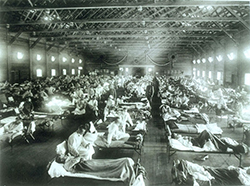 A worldwide influenza epidemic strikes. By 1920, 50 to 100 millions are dead, including Mark Sykes, the author of the British half of the Sykes-Picot Treaty.
A worldwide influenza epidemic strikes. By 1920, 50 to 100 millions are dead, including Mark Sykes, the author of the British half of the Sykes-Picot Treaty.
(no entry for this year)
1919
By the beginning of 1919, the Ku Klux Klan (revived in 1915 at Stone Mountain, Georgia) operates in 27 states. Eighty-three African Americans are lynched during the year, among them a number of returning soldiers still in uniform.
(no entry for this year)
1920
Women gain the right to vote in the United States.
The Russian Civil War ends in victory for the Bolsheviks.
(no entry for this year)
1922
 The Dyer Anti-Lynching Bill (first introduced by St. Louis congressman Leonidas Dyer in 1918), making lynching a federal offense, passes the US House of Representatives but fails in the US Senate.
The Dyer Anti-Lynching Bill (first introduced by St. Louis congressman Leonidas Dyer in 1918), making lynching a federal offense, passes the US House of Representatives but fails in the US Senate.
The Ottoman Empire officially ended with the signing of the Treaty of Lausanne, which recognized the sovereignty of the Republic of Turkey. Mustafa Kemal Ataturk, the founder of the Turkish Republic, implemented sweeping reforms to modernize the country and break with the Ottoman past.
(no entry for this year)
1923
Harding dies in office.
 Calvin Coolidge becomes thirtieth president of the United States.
Calvin Coolidge becomes thirtieth president of the United States.
Adolf Hitler's attempted coup d'état (the Beer Hall Putsch) in Munich fails. Hitler is imprisoned for eight months
(no entry for this year)
1924
 Gandhi undertakes his 21-day fast to protest feuds between Hindus and Muslims in India.
Gandhi undertakes his 21-day fast to protest feuds between Hindus and Muslims in India.
(no entry for this year)
1925
 On September 9, Ossian Sweet, a Detroit physician, is arrested for murder after he and his family kill a member of a white mob while defending their home. The Sweet family is represented by Clarence Darrow and they are acquitted of the charge.
On September 9, Ossian Sweet, a Detroit physician, is arrested for murder after he and his family kill a member of a white mob while defending their home. The Sweet family is represented by Clarence Darrow and they are acquitted of the charge.
Hitler reorganizes the Nazi party and publishes volume one of Mein Kampf.
Ibn Saud of Najd conquers Hijaz and forms Saudi Arabia.
(no entry for this year)
1926
Hirohito takes over the Japanese throne upon the death of his father, Yoshihito.
 Mussolini takes total control in Italy, banning all opposition.
Mussolini takes total control in Italy, banning all opposition.
(no entry for this year)
1927
(no entry for this year)
(no entry for this year)
1928
(no entry for this year)
(no entry for this year)
1929
 Herbert Hoover becomes thirty-first president of the United States.
Herbert Hoover becomes thirty-first president of the United States.
Black Tuesday in New York signals the beginning of a worldwide economic crisis and the beginning of the Great Depression, when the US stock exchange collapses, losing $26 billion in value.
(no entry for this year)
1930
(no entry for this year)
(no entry for this year)
1931
(no entry for this year)
(no entry for this year)
1932
(no entry for this year)
(no entry for this year)
1933
 Franklin D. Roosevelt becomes thirty-second president of the United States.
Franklin D. Roosevelt becomes thirty-second president of the United States.
Adolf Hitler is appointed German Chancellor; later the same year he is granted dictatorial powers. Events are in motion that will lead to World War II — the greatest military struggle of all time.
(no entry for this year)
1934
 In Herndon vs Georgia, the United States Supreme Court sets aside the death sentence of black communist Angelo Herndon, who was convicted under a pre-Civil War slave insurrection statute for passing out leaflets in Atlanta.
In Herndon vs Georgia, the United States Supreme Court sets aside the death sentence of black communist Angelo Herndon, who was convicted under a pre-Civil War slave insurrection statute for passing out leaflets in Atlanta.
(no entry for this year)
1935
(no entry for this year)
(no entry for this year)
1936
 Track star Jesse Owens wins four gold medals at the Berlin Olympics between August 3 and August 9.
Track star Jesse Owens wins four gold medals at the Berlin Olympics between August 3 and August 9.
German troops occupy the Rhineland in defiance of the treaties of Locarno and Versailles.
(no entry for this year)
1937
(no entry for this year)
(no entry for this year)
1938
(no entry for this year)
(no entry for this year)
1939
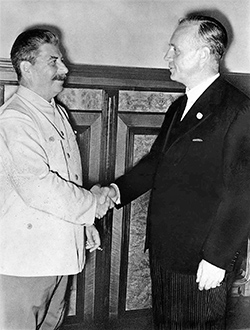 August 23, the Molotov–Ribbentrop Pact, officially the Treaty of Non-Aggression between Germany and the Union of Soviet Socialist Republics, and also known as the Hitler–Stalin Pact and the Nazi–Soviet Pact, was a non-aggression pact between Nazi Germany and the Soviet Union, with a secret protocol establishing Soviet and German spheres of influence across Northern Europe. The pact was signed in Moscow by Soviet Foreign Minister Vyacheslav Molotov and German Foreign Minister Joachim von Ribbentrop. One week after signing the pact, on 1 September 1939, Germany invaded Poland.
August 23, the Molotov–Ribbentrop Pact, officially the Treaty of Non-Aggression between Germany and the Union of Soviet Socialist Republics, and also known as the Hitler–Stalin Pact and the Nazi–Soviet Pact, was a non-aggression pact between Nazi Germany and the Soviet Union, with a secret protocol establishing Soviet and German spheres of influence across Northern Europe. The pact was signed in Moscow by Soviet Foreign Minister Vyacheslav Molotov and German Foreign Minister Joachim von Ribbentrop. One week after signing the pact, on 1 September 1939, Germany invaded Poland.
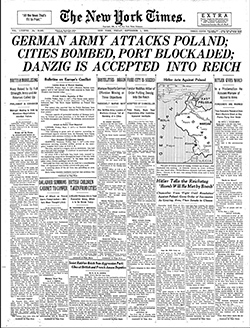 September 1, Germany invades Poland; Britain and France declare war on Germany on September 3. Soviet troops invade Poland. World War II begins.
September 1, Germany invades Poland; Britain and France declare war on Germany on September 3. Soviet troops invade Poland. World War II begins.
 September 1, George C. Marshall is sworn in as Chief of Staff of the US Army. After the war, Churchill refers to Marshall (the only military leader to serve through the entirety of WW II) as the Architect of Victory for his crucial role in ensuring the defeat of the Axis Powers. The very day that Hitler launches all-out war in Europe, the man who will oversee his defeat takes command of the US Military — a military that, at the time, contained only 334,000 total personnel.
September 1, George C. Marshall is sworn in as Chief of Staff of the US Army. After the war, Churchill refers to Marshall (the only military leader to serve through the entirety of WW II) as the Architect of Victory for his crucial role in ensuring the defeat of the Axis Powers. The very day that Hitler launches all-out war in Europe, the man who will oversee his defeat takes command of the US Military — a military that, at the time, contained only 334,000 total personnel.
(no entry for this year)
1940
(no entry for this year)
(no entry for this year)
1941
Between 1941 and 1945, the desperate need for labor in US defense plants and shipyards leads to the migration of 1.2 million African-Americans from the South to the North and West. This migration transforms American politics as blacks increasingly vote in their new homes and put pressure on Congress to protect civil rights throughout the nation. Their activism lays much of the foundation for the national civil rights movement a decade later.
On June 25, Pres. Franklin Roosevelt issues Executive Order 8802, which desegregates US defense plants and shipyards and creates the Fair Employment Practices Committee.
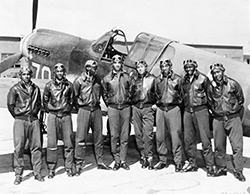 The US Army creates the Tuskegee Air Squadron (the 99th Pursuit Squadron) — an all African-American flying unit.
The US Army creates the Tuskegee Air Squadron (the 99th Pursuit Squadron) — an all African-American flying unit.
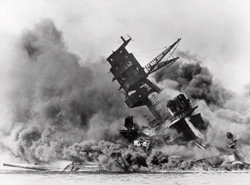 07 DEC 1941: Pearl Harbor bombed by Japanese The US immediately declares war on Japan. Germany quickly declares war on the United States. The US is now a full participant in World War II.
07 DEC 1941: Pearl Harbor bombed by Japanese The US immediately declares war on Japan. Germany quickly declares war on the United States. The US is now a full participant in World War II.
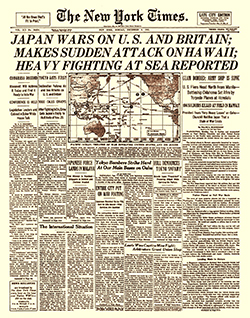 08 DEC 1941: The US responds to Pearl Harbor. President to address joint session of Congress. Declaration of War expected.
08 DEC 1941: The US responds to Pearl Harbor. President to address joint session of Congress. Declaration of War expected.
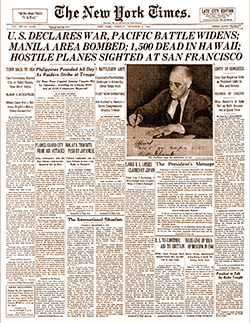 09 DEC 1941: The United States formally declares War on Japan.
09 DEC 1941: The United States formally declares War on Japan.
(no entry for this year)
1942
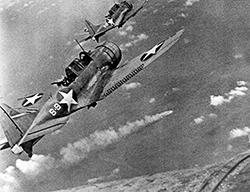 4-7 JUN 1942: The Battle of Midway occurs. Less than six months after Pearl Harbor the Japanese navy attempts to lure the remnants of the US Navy into a decisive battle at Midway Island. The Japanese plan backfires, as the battle proves to be a huge victory for US forces and the turning point in the war in the Pacific.
4-7 JUN 1942: The Battle of Midway occurs. Less than six months after Pearl Harbor the Japanese navy attempts to lure the remnants of the US Navy into a decisive battle at Midway Island. The Japanese plan backfires, as the battle proves to be a huge victory for US forces and the turning point in the war in the Pacific.
(no entry for this year)
1943
(no entry for this year)
(no entry for this year)
1944
On April 3, the United States Supreme Court in Smith vs. Allright declares white-only political primaries unconstitutional.
 D-Day landing On June 6th, the largest amphibious force ever assembled, led by General Dwight D. Eisenhower, successfully attacks and establishes a landing on the coast of France at Normandy.
D-Day landing On June 6th, the largest amphibious force ever assembled, led by General Dwight D. Eisenhower, successfully attacks and establishes a landing on the coast of France at Normandy.
(no entry for this year)
1945
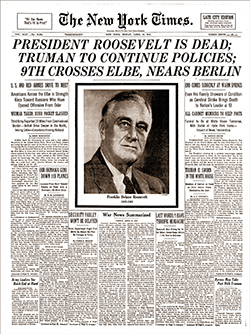 13 APR 1945: President Roosevelt dies in office.
13 APR 1945: President Roosevelt dies in office.
 Harry S. Truman becomes thirty-third president of the United States.
Harry S. Truman becomes thirty-third president of the United States.
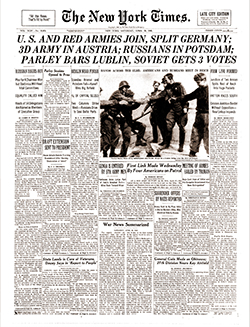 28 APR 1945: US and Russian troops meet. Germany split in two.
28 APR 1945: US and Russian troops meet. Germany split in two.
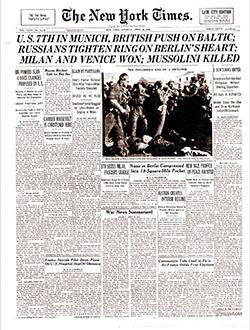 30 APR 1945: Press reports Mussolini killed by Italian partisans, his body abused. Hitler commits suicide by gunshot while hiding in his Führerbunker, but news of his death will not surface for a few days.
30 APR 1945: Press reports Mussolini killed by Italian partisans, his body abused. Hitler commits suicide by gunshot while hiding in his Führerbunker, but news of his death will not surface for a few days.
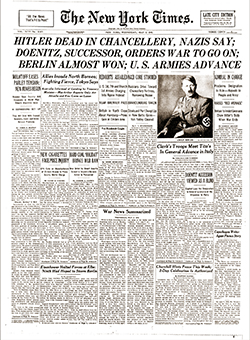 02 MAY 1945: Hitler reported dead..
02 MAY 1945: Hitler reported dead..
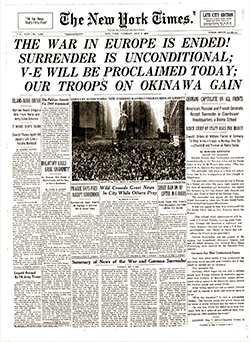 08 MAY 1945: Germany surrenders unconditionally. The war in Europe is over.
08 MAY 1945: Germany surrenders unconditionally. The war in Europe is over.
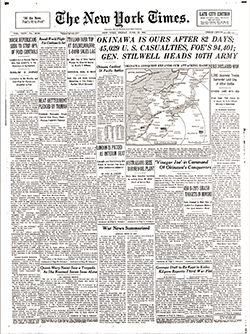 22 JUN 1945: Okinawa falls after 82 days of fierce fighting.
22 JUN 1945: Okinawa falls after 82 days of fierce fighting.
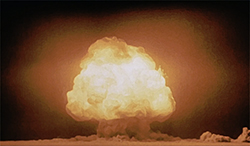 16 JUL 1945: The Manhattan Project yields results — the world's first atomic bomb is secretly tested in New Mexico.
16 JUL 1945: The Manhattan Project yields results — the world's first atomic bomb is secretly tested in New Mexico.
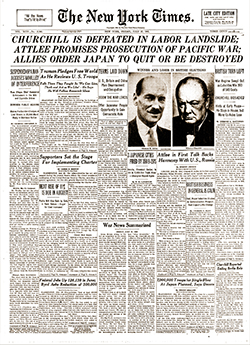 27 JUL 1945: Churchill is defeated in British elections. Potsdam Declaration is reported, calling for Japan to surrender unconditionally or face "prompt and utter destruction."
27 JUL 1945: Churchill is defeated in British elections. Potsdam Declaration is reported, calling for Japan to surrender unconditionally or face "prompt and utter destruction."
 06 AUG 1945: the first atomic bomb used in combat is dropped on Hiroshima, Japan.
06 AUG 1945: the first atomic bomb used in combat is dropped on Hiroshima, Japan.
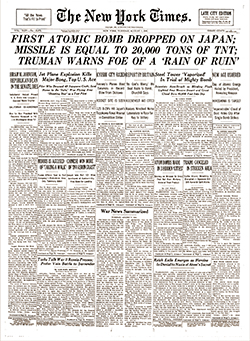 07 AUG 1945: The world learns about the atomic bomb. President Truman announces "The force from which the sun draws its power has been loosed against those who brought war to the Far East" and he calls upon Japan to immediately accept the terms of the Potsdam Declaration or expect a rain of ruin from the air, the like of which has never been seen on this earth."
07 AUG 1945: The world learns about the atomic bomb. President Truman announces "The force from which the sun draws its power has been loosed against those who brought war to the Far East" and he calls upon Japan to immediately accept the terms of the Potsdam Declaration or expect a rain of ruin from the air, the like of which has never been seen on this earth."
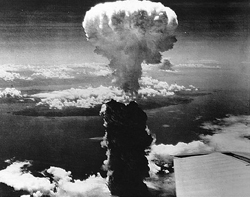 09 AUG 1945: The second atomic bomb used in combat is dropped on Nagasaki, Japan. The primary target for this mission was actually the city of Kokura, but the bomber crew moved on to the secondary target of Nagasaki when Kokura proved to be too obscured by smoke to get a clear view for the bombsight. Russia declares war on japan.
09 AUG 1945: The second atomic bomb used in combat is dropped on Nagasaki, Japan. The primary target for this mission was actually the city of Kokura, but the bomber crew moved on to the secondary target of Nagasaki when Kokura proved to be too obscured by smoke to get a clear view for the bombsight. Russia declares war on japan.
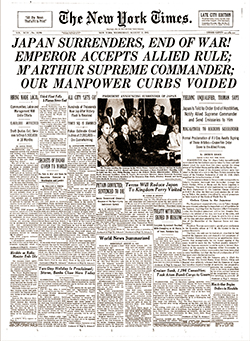 15 AUG 1945: In the afternoon of August 15th (Japanese time), Japan announces its unconditional surrender. World War II is finally over. More than 60 million people have died as a result of the conflict.
15 AUG 1945: In the afternoon of August 15th (Japanese time), Japan announces its unconditional surrender. World War II is finally over. More than 60 million people have died as a result of the conflict.
 Col. Benjamin O. Davis, Jr, is named commander of Godman Field, Kentucky. He is the first African-American to command a United States military base.
Col. Benjamin O. Davis, Jr, is named commander of Godman Field, Kentucky. He is the first African-American to command a United States military base.
(no entry for this year)
1946
The United States Supreme Court, in Morgan vs Virginia, rules that segregation in interstate bus travel is unconstitutional.
(no entry for this year)
1947
 On April 10, Jackie Robinson of the Brooklyn Dodgers becomes the first African-American to play major league baseball in the 20th century.
On April 10, Jackie Robinson of the Brooklyn Dodgers becomes the first African-American to play major league baseball in the 20th century.
(no entry for this year)
1948
On July 26, Pres. Harry Truman issues Executive Order 9981, directing the desegregation of the armed forces.
The United States Supreme Court, in Shelley vs Kraemer, rules that racially restrictive covenants are legally unenforceable.
(no entry for this year)
1949
(no entry for this year)
(no entry for this year)
1950
(no entry for this year)
(no entry for this year)
1951
 On May 24, a mob of 3500 whites attempt to prevent a black family from moving into an apartment in Cicero, Illinois. Illinois Gov. Adlai Stevenson calls out the Illinois National Guard to protect the family and restore order.
On May 24, a mob of 3500 whites attempt to prevent a black family from moving into an apartment in Cicero, Illinois. Illinois Gov. Adlai Stevenson calls out the Illinois National Guard to protect the family and restore order.
On May 24, the United States Supreme Court rules that racial segregation in District of Columbia restaurants is unconstitutional.
(no entry for this year)
1952
(no entry for this year)
(no entry for this year)
1953
(no entry for this year)
1954
On May 17, the United States Supreme Court, in Brown vs the Board of Education, declares segregation in all public schools in the United States unconstitutional, nullifying the earlier judicial doctrine of "separate but equal."
(no entry for this year)
1955
 Rosa Parks refuses to relinquish her bus seat to a white man on December 1, initiating the Montgomery bus boycott. Soon afterward, Martin Luther King, Jr., becomes the leader of the boycott.
Rosa Parks refuses to relinquish her bus seat to a white man on December 1, initiating the Montgomery bus boycott. Soon afterward, Martin Luther King, Jr., becomes the leader of the boycott.
 Fourteen-year-old Chicago resident Emmett Till is lynched in Money, Mississippi, on August 28.
Fourteen-year-old Chicago resident Emmett Till is lynched in Money, Mississippi, on August 28.
(no entry for this year)
1956
(no entry for this year)
(no entry for this year)
1957
Congress passes the Civil Rights Act of 1957, the first legislation protecting black rights since Reconstruction.
In September, Pres. Dwight D. Eisenhower sends federal troops to Little Rock, Arkansas, to ensure the enforcement of a federal court order to desegregate Central High School and to protect nine African-American students enrolled as part of the order.
(no entry for this year)
1958
(no entry for this year)
(no entry for this year)
1959
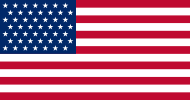 The US flag is modified to have forty-nine stars, reflecting the addition of one new state: Alaska.
The US flag is modified to have forty-nine stars, reflecting the addition of one new state: Alaska.
(no entry for this year)
1960
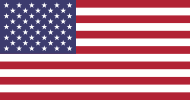 The US flag is modified to have fifty stars, reflecting the addition of one new state: Hawaii.
The US flag is modified to have fifty stars, reflecting the addition of one new state: Hawaii.
The Civil Rights Act of 1960 is signed into law by Pres. Dwight D. Eisenhower on May 6. The act establishes federal inspection of local voter registration rolls and introduces penalties for anyone who obstructs a citizens attempt to register to vote or to cast a ballot.
(no entry for this year)
1961
The Congress of Racial Equality organizes Freedom Rides through the Deep South.
 John F. Kennedy becomes thirty-fifth president of the United States.
John F. Kennedy becomes thirty-fifth president of the United States.
(no entry for this year)
1962
 On October 1, James Meredith becomes the first black student to enroll at the University of Mississippi.
On October 1, James Meredith becomes the first black student to enroll at the University of Mississippi.
(no entry for this year)
1963
Martin Luther King Jr. writes his "Letter from Birmingham Jail" on April 16.
Kennedy assassinated.
Lyndon Johnson becomes thirty-sixth president of the United States.
 Martin Luther King Jr. is named Time magazine's Man of the Year.
Martin Luther King Jr. is named Time magazine's Man of the Year.
 On June 12, Mississippi NAACP field secretary Medgar Evers is assassinated outside his home in Jackson.
On June 12, Mississippi NAACP field secretary Medgar Evers is assassinated outside his home in Jackson.
(no entry for this year)
1964
Congress passes the Civil Rights Act of 1964. The act and this discrimination in all public accommodations and by employers. It also establishes the Equal Opportunity Employment Commission (EEOC) to monitor compliance with the law.


 On June 21, civil rights workers James Chaney, Andrew Goodman, and Michael Schwerner are abducted and killed by terrorists in Mississippi.
On June 21, civil rights workers James Chaney, Andrew Goodman, and Michael Schwerner are abducted and killed by terrorists in Mississippi.
The 24th amendment to the Constitution, which abolishes the poll tax, is ratified.
(no entry for this year)
1965
 Malcolm X is assassinated at the Audubon Ballroom in Harlem on February 21.
Malcolm X is assassinated at the Audubon Ballroom in Harlem on February 21.
The Watts Uprising occurs on August 11-16th. Thirty-four people are killed and 1000 are injured in the five-day confrontation.
(no entry for this year)
1966
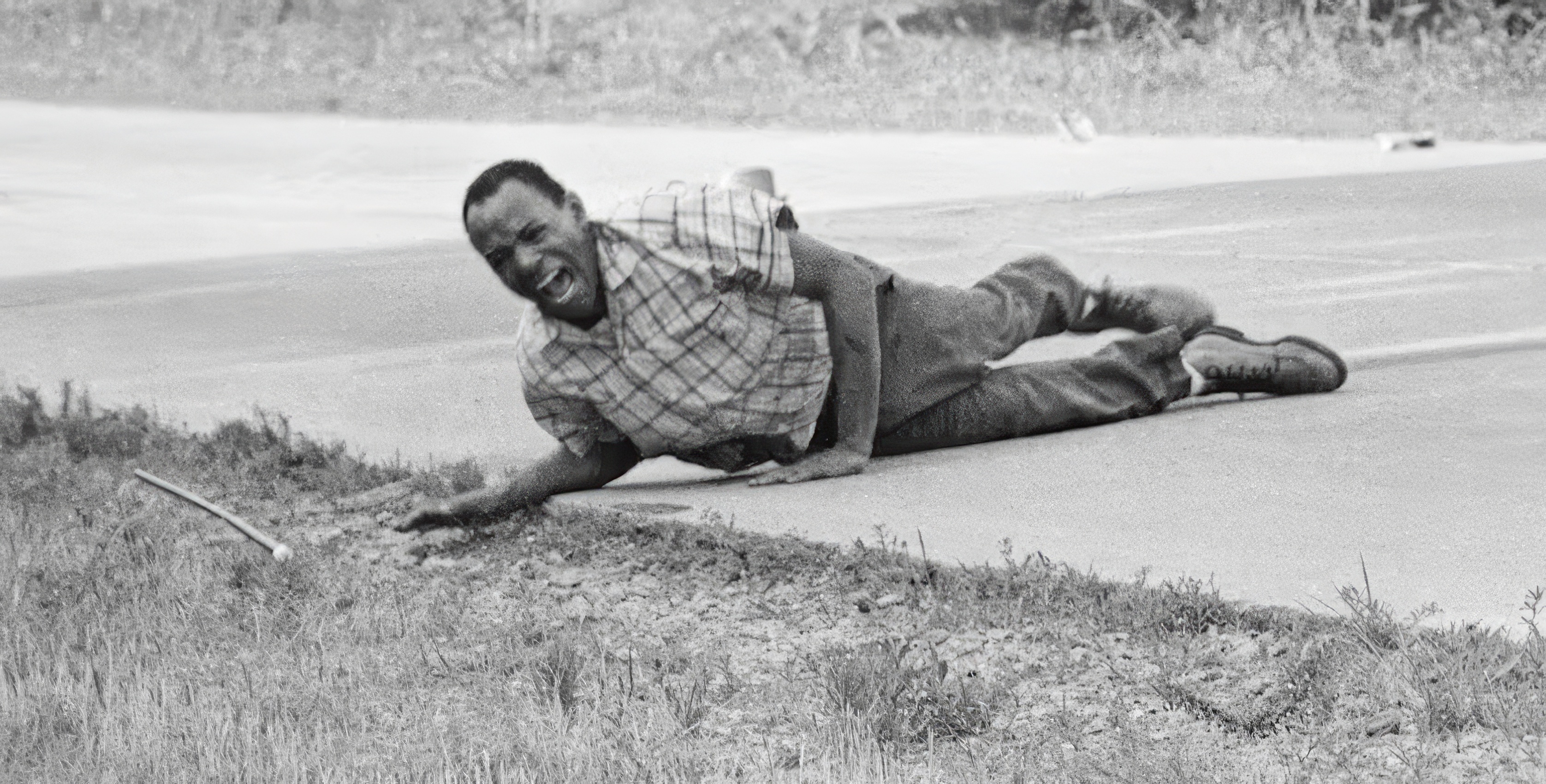 On June 5, James Meredith begins a solitary March Against Fear for 220 miles from Memphis, Tennessee, to Jackson, Mississippi, to protest racial discrimination. Meredith is shot by a sniper soon after crossing into Mississippi.
On June 5, James Meredith begins a solitary March Against Fear for 220 miles from Memphis, Tennessee, to Jackson, Mississippi, to protest racial discrimination. Meredith is shot by a sniper soon after crossing into Mississippi.
 On November 8, Edward Brooke of Massachusetts becomes the first African-American to be elected to the United States Senate since Reconstruction.
On November 8, Edward Brooke of Massachusetts becomes the first African-American to be elected to the United States Senate since Reconstruction.

 On September 15, the Black Panther Party is formed in Oakland, California, by Bobby Seale and Huey P. Newton.
On September 15, the Black Panther Party is formed in Oakland, California, by Bobby Seale and Huey P. Newton.
(no entry for this year)
1967
 On July 13, Thurgood Marshall takes his seat as the first African-American justice on the United States Supreme Court.
On July 13, Thurgood Marshall takes his seat as the first African-American justice on the United States Supreme Court.
On June 12, the United States Supreme Court, in Loving vs Virginia, strikes down state interracial marriage bans.
The six-day Newark Riot begins on July 12.
(no entry for this year)
1968
 On April 4, Martin Luther King, Jr., is assassinated in Memphis, Tennessee. In the wake of the assassination, 125 cities in 29 states experience uprisings.
On April 4, Martin Luther King, Jr., is assassinated in Memphis, Tennessee. In the wake of the assassination, 125 cities in 29 states experience uprisings.
 On June 5, New York Senator and presidential candidate Robert F. Kennedy is assassinated in Los Angeles.
On June 5, New York Senator and presidential candidate Robert F. Kennedy is assassinated in Los Angeles.
(no entry for this year)
1969
(no entry for this year)
1970
 Dr. Clifton Wharton Junior is named president of Michigan State University on January 2. He is the first African-American to lead a major, predominantly white university in the 20th century.
Dr. Clifton Wharton Junior is named president of Michigan State University on January 2. He is the first African-American to lead a major, predominantly white university in the 20th century.
(no entry for this year)
1971
On January 12, the Congressional Black Caucus is formed in Washington DC.
(no entry for this year)
1972

 In November, Barbara Jordan of Houston and Andrew Young of Atlanta become the first black Congressional representatives elected from the US South since 1898.
In November, Barbara Jordan of Houston and Andrew Young of Atlanta become the first black Congressional representatives elected from the US South since 1898.
(no entry for this year)
1973
 In the late summer of 1973, Republican Vice President Spiro Agnew was under investigation by the United States Attorney's office in Baltimore, Maryland, on charges of extortion, tax fraud, bribery and conspiracy. In October, he was formally charged with having accepted bribes totaling more than $100,000, while holding office as Baltimore County Executive, Governor of Maryland, and as Vice President of the United States. On October 10, 1973, Agnew was allowed to plead no contest to a single charge that he had failed to report $29,500 of income received in 1967, with the condition that he resign the office of Vice President. Agnew is the only Vice President in U.S. history to resign because of criminal charges.
In the late summer of 1973, Republican Vice President Spiro Agnew was under investigation by the United States Attorney's office in Baltimore, Maryland, on charges of extortion, tax fraud, bribery and conspiracy. In October, he was formally charged with having accepted bribes totaling more than $100,000, while holding office as Baltimore County Executive, Governor of Maryland, and as Vice President of the United States. On October 10, 1973, Agnew was allowed to plead no contest to a single charge that he had failed to report $29,500 of income received in 1967, with the condition that he resign the office of Vice President. Agnew is the only Vice President in U.S. history to resign because of criminal charges.
 Thomas Bradley is elected the first black mayor of Los Angeles in the modern era. He is reelected four times and thus holds the mayor's office for 20 years.
Thomas Bradley is elected the first black mayor of Los Angeles in the modern era. He is reelected four times and thus holds the mayor's office for 20 years.
(no entry for this year)
1974
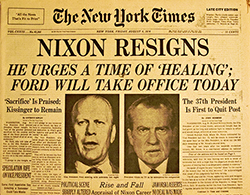 Under mounting impeachment pressure resulting from the Watergate break-in, Nixon becomes the first president ever to resign from presidency.
Under mounting impeachment pressure resulting from the Watergate break-in, Nixon becomes the first president ever to resign from presidency.
 Gerald Ford becomes thirty-eighth president of the United States.
Gerald Ford becomes thirty-eighth president of the United States.
(no entry for this year)
1975
(no entry for this year)
(no entry for this year)
1976
(no entry for this year)
(no entry for this year)
1977
 The eighth and final night for the televised miniseries based on Alex Haley's Roots is shown on February 3. This final episode achieves the highest ratings to that point for a single television program.
The eighth and final night for the televised miniseries based on Alex Haley's Roots is shown on February 3. This final episode achieves the highest ratings to that point for a single television program.
Jimmy Carter becomes thirty-ninth president of the United States.
(no entry for this year)
1978
(no entry for this year)
(no entry for this year)
1979
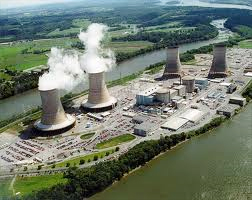 On March 28, a partial core meltdown occurred in Unit 2 of the Three Mile Island Nuclear Generating Station in Dauphin County, Pennsylvania near Harrisburg.
On March 28, a partial core meltdown occurred in Unit 2 of the Three Mile Island Nuclear Generating Station in Dauphin County, Pennsylvania near Harrisburg.
(no entry for this year)
1980
(no entry for this year)
(no entry for this year)
1982
(no entry for this year)
(no entry for this year)
1983
On November 2, Pres. Ronald Reagan signs into law a bill making the third Monday in January a federal holiday honoring the life of Martin Luther King Jr.
(no entry for this year)
1984
(no entry for this year)
(no entry for this year)
1985
United States Rep. William H. Gray III (Pennsylvania), becomes the first African-American congressmen to chair the House Budget Committee.
(no entry for this year)
1986
On September 8, The Oprah Winfrey Show from Chicago becomes nationally syndicated.
 On April 26, the Chernobyl Nuclear Disaster occurred in the Soviet Union, when reactor 4 of the Chernobyl Nuclear Power Plant suffered a catastrophic power increase, leading to explosions in the core. This dispersed large quantities of radioactive fuel and core materials into the atmosphere and ignited the combustible graphite moderator. The burning graphite moderator increased the emission of radioactive particles, carried by the smoke, as the reactor had not been contained by any kind of hard containment vessel (unlike all Western plants). The accident occurred during an experiment scheduled to test a potential safety emergency core cooling feature. Large areas in Ukraine, Belarus, and Russia had to be evacuated, with over 336,000 people resettled.
On April 26, the Chernobyl Nuclear Disaster occurred in the Soviet Union, when reactor 4 of the Chernobyl Nuclear Power Plant suffered a catastrophic power increase, leading to explosions in the core. This dispersed large quantities of radioactive fuel and core materials into the atmosphere and ignited the combustible graphite moderator. The burning graphite moderator increased the emission of radioactive particles, carried by the smoke, as the reactor had not been contained by any kind of hard containment vessel (unlike all Western plants). The accident occurred during an experiment scheduled to test a potential safety emergency core cooling feature. Large areas in Ukraine, Belarus, and Russia had to be evacuated, with over 336,000 people resettled.
(no entry for this year)
1987
 Dr. Clifton R. Wharton Jr. is appointed chairman and CEO of TIAA-CREF, the 19th largest US Fortune 500 company. He becomes the first black chairman and CEO of a major US corporation.
Dr. Clifton R. Wharton Jr. is appointed chairman and CEO of TIAA-CREF, the 19th largest US Fortune 500 company. He becomes the first black chairman and CEO of a major US corporation.
 Kurt Schmoke becomes the first African-American elected mayor of Baltimore.
Kurt Schmoke becomes the first African-American elected mayor of Baltimore.
(no entry for this year)
1988
(no entry for this year)
(no entry for this year)
1989
 Douglas Wilder wins the governorship of Virginia, make him the first African-American to be popularly elected to that office.
Douglas Wilder wins the governorship of Virginia, make him the first African-American to be popularly elected to that office.
 Gen. Colin L. Powell is named chief of the United States Joint Chiefs of Staff, the first African-American in the youngest person (52) to hold the post.
Gen. Colin L. Powell is named chief of the United States Joint Chiefs of Staff, the first African-American in the youngest person (52) to hold the post.
 In March, Frederick Andrew Gregory becomes the first African-American to command a space shuttle when he leads the crew of the Discovery.
In March, Frederick Andrew Gregory becomes the first African-American to command a space shuttle when he leads the crew of the Discovery.
George Bush becomes forty-first president of the United States.
(no entry for this year)
1990
 Nelson Mandela, South African black nationalist, is freed after 27 years in prison.
Nelson Mandela, South African black nationalist, is freed after 27 years in prison.
(no entry for this year)
1991
The Soviet Union ends, and so does the Cold War.
(no entry for this year)
1992
(no entry for this year)
(no entry for this year)
1993
(no entry for this year)
1994
 On April 27, Nelson Mandela is elected President of South Africa in that nation's first election giving black voters full enfranchisement. The land of apartheid is now led by a black activist.
On April 27, Nelson Mandela is elected President of South Africa in that nation's first election giving black voters full enfranchisement. The land of apartheid is now led by a black activist.
(no entry for this year)
1995
(no entry for this year)
(no entry for this year)
1996
(no entry for this year)
(no entry for this year)
1997
(no entry for this year)
(no entry for this year)
1998
(no entry for this year)
(no entry for this year)
1999
(no entry for this year)
(no entry for this year)
2000
(no entry for this year)
(no entry for this year)
2002
(no entry for this year)
(no entry for this year)
2003
(no entry for this year)
(no entry for this year)
2004
Barack Obama is elected to the United States Senate from Illinois. He becomes the second African-American elected to the Senate from that state, and only the fifth black US senator in history.
(no entry for this year)
2005
(no entry for this year)
(no entry for this year)
2006
(no entry for this year)
(no entry for this year)
2007
(no entry for this year)
(no entry for this year)
2008
On August 27, Illinois Sen. Barack Obama becomes the first African-American to attain the Democratic Party nomination for president of the United States when he is chosen at the party's national convention in Denver.
(no entry for this year)
2010
(no entry for this year)
(no entry for this year)
2011
(no entry for this year)
(no entry for this year)
2012
(no entry for this year)
(no entry for this year)
2013
(no entry for this year)
(no entry for this year)
2014
(no entry for this year)
(no entry for this year)
2015
(no entry for this year)
(no entry for this year)
2016
(no entry for this year)
(no entry for this year)
2017
 Donald Trump becomes forty-fifth president of the United States. A Berlusconi-like event visits America.
Donald Trump becomes forty-fifth president of the United States. A Berlusconi-like event visits America.
(no entry for this year)
2018
(no entry for this year)
(no entry for this year)
2019
(no entry for this year)
(no entry for this year)
2020
(no entry for this year)
(no entry for this year)
2021
 Joe Biden becomes the 46th President of the United States.
Joe Biden becomes the 46th President of the United States.
(no entry for this year)
2022
(no entry for this year)
(no entry for this year)
2023
(no entry for this year)
(no entry for this year)
2024
(no entry for this year)
(no entry for this year)
2025
(no entry for this year)
2026
(no entry for this year)
(no entry for this year)
2027
(no entry for this year)
(no entry for this year)
2028
(no entry for this year)
(no entry for this year)
2029
(no entry for this year)
ESP Quick Facts
ESP Origins
In the early 1990's, Robert Robbins was a faculty member at Johns Hopkins, where he directed the informatics core of GDB — the human gene-mapping database of the international human genome project. To share papers with colleagues around the world, he set up a small paper-sharing section on his personal web page. This small project evolved into The Electronic Scholarly Publishing Project.
ESP Support
In 1995, Robbins became the VP/IT of the Fred Hutchinson Cancer Research Center in Seattle, WA. Soon after arriving in Seattle, Robbins secured funding, through the ELSI component of the US Human Genome Project, to create the original ESP.ORG web site, with the formal goal of providing free, world-wide access to the literature of classical genetics.
ESP Rationale
Although the methods of molecular biology can seem almost magical to the uninitiated, the original techniques of classical genetics are readily appreciated by one and all: cross individuals that differ in some inherited trait, collect all of the progeny, score their attributes, and propose mechanisms to explain the patterns of inheritance observed.
ESP Goal
In reading the early works of classical genetics, one is drawn, almost inexorably, into ever more complex models, until molecular explanations begin to seem both necessary and natural. At that point, the tools for understanding genome research are at hand. Assisting readers reach this point was the original goal of The Electronic Scholarly Publishing Project.
ESP Usage
Usage of the site grew rapidly and has remained high. Faculty began to use the site for their assigned readings. Other on-line publishers, ranging from The New York Times to Nature referenced ESP materials in their own publications. Nobel laureates (e.g., Joshua Lederberg) regularly used the site and even wrote to suggest changes and improvements.
ESP Content
When the site began, no journals were making their early content available in digital format. As a result, ESP was obliged to digitize classic literature before it could be made available. For many important papers — such as Mendel's original paper or the first genetic map — ESP had to produce entirely new typeset versions of the works, if they were to be available in a high-quality format.
ESP Help
Early support from the DOE component of the Human Genome Project was critically important for getting the ESP project on a firm foundation. Since that funding ended (nearly 20 years ago), the project has been operated as a purely volunteer effort. Anyone wishing to assist in these efforts should send an email to Robbins.
ESP Plans
With the development of methods for adding typeset side notes to PDF files, the ESP project now plans to add annotated versions of some classical papers to its holdings. We also plan to add new reference and pedagogical material. We have already started providing regularly updated, comprehensive bibliographies to the ESP.ORG site.
ESP Picks from Around the Web (updated 06 MAR 2017 )
Old Science

Weird Science

Treating Disease with Fecal Transplantation
Fossils of miniature humans (hobbits) discovered in Indonesia

Dinosaur tail, complete with feathers, found preserved in amber.
Astronomy

Mysterious fast radio burst (FRB) detected in the distant universe.